This is an old revision of this page, as edited by Gyuli Gula (talk | contribs) at 19:37, 31 March 2021 (→Hanfu in popular media and opera). The present address (URL) is a permanent link to this revision, which may differ significantly from the current revision.
Revision as of 19:37, 31 March 2021 by Gyuli Gula (talk | contribs) (→Hanfu in popular media and opera)(diff) ← Previous revision | Latest revision (diff) | Newer revision → (diff) Traditional dress of the Han people For other uses, see Hanfu (disambiguation).
This article has multiple issues. Please help improve it or discuss these issues on the talk page. (Learn how and when to remove these messages)
|
Hanfu is a term used for the historical styles of clothing worn by the Han people in China. In modern times, the term "hanfu" (汉服) was coined by Chinese Internet users to broadly describe ancient Han Chinese people's clothing worn before the Qing dynasty. There are several representative styles of Hanfu, such as the ruqun (an upper-body garment with a long outer skirt), the aoqun (an upper-body garment with a long underskirt), the beizi (usually a slender knee-length jacket) and the shenyi (a long, belted robe with wide sleeves). Traditionally, the hanfu consisted of a robe, or a jacket worn as the upper garment with a skirt commonly worn as the lower garment. In addition to clothing, hanfu also includes several forms of accessories, such as headwear, footwear, belts, jewellery such as yupei (jade pendants) and handheld fans. Nowadays, hanfu is gaining recognition as the traditional clothing of the Han ethnic group and has experienced a growing fashion revival among young Han Chinese people in China and in the overseas Chinese diaspora.
| Hanfu | |||||||||||||||||||
|---|---|---|---|---|---|---|---|---|---|---|---|---|---|---|---|---|---|---|---|
 "Hanfu" in Simplified (top) and Traditional (bottom) Chinese characters "Hanfu" in Simplified (top) and Traditional (bottom) Chinese characters | |||||||||||||||||||
| Simplified Chinese | 汉服 | ||||||||||||||||||
| Traditional Chinese | 漢服 | ||||||||||||||||||
| Literal meaning | "Han Chinese's clothing" | ||||||||||||||||||
| |||||||||||||||||||
Following the Han dynasty, this clothing had developed into a variety of styles using fabrics that encompassed a number of complex textile production techniques, particularly those used to produce silk. Hanfu influenced the traditional clothing of many neighbouring cultures, such as Korean Hanbok, Japanese Kimono, Okinawa Ryusou, and the Vietnamese áo giao lĩnh.
History

Many factors have contributed to the fashion of ancient China: beliefs, religions, wars, and the emperor's personal liking. Han clothing comprises all traditional clothing classifications of the Han Chinese with a recorded history of more than three millennia. Each succeeding dynasties have produced each own distinctive dress codes, reflecting the socio-cultural environment of the times. And, ever since the Qin dynasty (221 - 206 BC), colours used in the sumptuary laws of the Han Chinese had symbolic meaning which were based on the Taoist Five Elements Theory and the Yin and Yang principle; and each dynasties had a favourite colour.
From the beginning of its history, Han Chinese clothing (especially in elite circles) was inseparable from silk and the art of sericulture, supposedly discovered by the Yellow Emperor's consort, Leizu (also known as Luozu) who was also revered as the Goddess of sericulture. There is even a saying in the Book of Change, which says that
"Huang Di, Yao, and Shun (simply) wore their upper and lower garments (as patterns to the people), and good order was secured all under heaven".
Clothing made of silk was initially used for decorative and ceremonial purposes. Common people in the Zhou dynasty, including the minority groups in Southwest China, wore hemp-based clothing. The cultivation of silk, however, ushered the development of weaving, and by the time of the Han dynasty, brocade, damask, satin, and gauze had been developed.
From ancient time, the upper garments of hanfu is wrapped over, in a style known as jiaoling youren (交領右衽), the left side covering the right side and extend to the wearer's right waist. Initially, the style was used because of the habit of the right-handed wearer to stuff the right side first. Later, the people of Zhongyuan discouraged left-handedness, considering it unnatural, barbarian, uncivilized, and unfortunate. In contrast, zuoren (左衽), right side crosses over the left, is used to dress the dead. Zuoren (左衽) is also used by some minor ethic in China.
Elements of Han Chinese clothing have also been influenced by neighbouring cultural clothing, especially by the nomadic peoples to the north, and Central Asian cultures to the west by way of the Silk Road.
Shang dynasty
In China, a systemic structure of clothing was first developed during the Shang dynasty (c. 1600 BC – 1000 BC), where colours, designs, and rules governing use was implemented across the social strata. In the Shang dynasty, the rudiments of hanfu was developed in the combination of upper and lower garments; this form of clothing consisted of a yi (衣; a narrow-cuffed, knee-length tunic tied with a sash) and a chang (裳; a narrow skirt which reached the ankles of its wearer), usually worn with a bixi (蔽膝; lit. knees cover, a cloth attached from the waist, covering front of legs). The cross-collar upper garment started to be worn during the Shang dynasty. During this period, this clothing style was unisex. Only primary colours (i.e. red, blue, and yellow) and green were used, due to the degree of technology at the time; and in winter, padded jackets were worn. Only rich people wore silk; poor people continued to wear loose shirts and trousers made of hemp or ramie. Trousers were known as ku (袴) or jingyi (胫衣); they were knee-high trousers which tied on the calves but left the thighs exposed, which was worn under the chang. An example of the attire worn in the Shang dynasty can be seen on an anthropomorphic jade figurine excavated from the Tomb of Fu Hao in Anyang, which shows a person wearing a long narrow-sleeved upper garment with a wide band covering around waist, and a skirt underneath. This upper and lower garment attire appears to have been designed for the aristocratic class.
- An anthropomorphic jade figurines of Shang dynasty from the Tomb of Fu Hao, now stored in the National Museum of China. An anthropomorphic jade figurines of Shang dynasty from the Tomb of Fu Hao, now stored in the National Museum of China.
-
 Statuette of a Standing Dignitary, China, Shang dynasty, Arthur M. Sackler Museum, Harvard University.
Statuette of a Standing Dignitary, China, Shang dynasty, Arthur M. Sackler Museum, Harvard University.
-
 One of the jade human figure, excavated from the tomb of Fu Hao, Late Shang dynasty.
One of the jade human figure, excavated from the tomb of Fu Hao, Late Shang dynasty.
Zhou dynasty
The dynasty to follow the Shang dynasty, the Western Zhou dynasty (c. 1045 BC – 771 BC), established a strict hierarchical society that used clothing as a status meridian, and inevitably, the height of one's rank influenced the ornateness of a costume. Such markers included the fabric materials, the shape, size, colour of the clothing, the decorative pattern, the length of a skirt, the wideness of a sleeve, and the degree of ornamentation. There were strict regulations on the clothings of the emperor, feudal dukes, senior officials, soldiers, ancestor worshippers, brides, and mourners.
The mianfu (冕服) was the most distinguished type of formal dress, worn for worshipping and memorial ceremonies; it had a complex structure and there were various decorations which bore symbolic meaning. There were six ranked types of mianfu, and was worn by emperors, princes and officials according to their titles. The emperors also wore bianfu (弁服) which was only second to mianfu; it was worn when they would meet with officials or if they had to work on official business. When the emperor were not at court, they wore the xuanduan (玄端), also called the yuanduan (元端). Xuanduan can also worn by princes during sacrificial occasions and by scholars who would go pay respect to their parents in the morning. The mianfu, bianfu and xuanduan all consisted of four separate parts: a skirt underneath, a robe in the middle, a bixi on top, and a long cloth belt dadai (大带). Similarly to the Western Zhou dynasty, the dress code of the early Eastern Zhou dynasty (770 - 256 BC) was governed by strict rules which was used maintain social order and to distinguish social class.
In addition to these class-oriented developments, the daily hanfu in this period became slightly looser while maintaining the basic form the Shang dynasty. The upper garment was still yi (衣) and the lower garment was a skirt, chang (裳). Broad and narrow sleeves both co-existed. The yi (衣) was closed with a sash which was tied around the waist; jade decorations were sometimes hung from the sash. The length of the skirts and trousers could vary from knee-length to ground-length.
The earliest form of Chinese hair stick was found in the Neolithic Hemudu culture relics; the hair stick was called ji (笄), and were made from bones, horns, stones, and jades. Zhou dynasty formalized women's wearing of ji with a Han Chinese coming-of-age ceremony called Ji li (笄礼), which was performed after a girl was engaged and the wearing of ji showed a girl was already promised to a marriage. Men could also were ji alone, however more commonly men were ji with the crown and hat to fix the headwear.
Spring and Autumn period, Warring States period
During the Spring and Autumn period (722 - 481 BC) and the Warring States period (481 - 403 BC), numerous school of thoughts emerged in China, including Confucianism; those different schools of thoughts naturally influenced the development of the clothing. Moreover, due to the frequent wars occurred during the Warring States period, various etiquettes were slowly revoked. Eastern Zhou dynasty dress code started to erode by the middle of Warring States period. Later, many regions decided not to follow the system of Zhou dynasty; the clothing during this period were differentiated among the seven major states (i.e. the states of Chu, Han, Qin, Wei, Yan, Qi and Zhao).
Based on the archeological artefacts dating from the Eastern Zhou dynasty, ordinary men, peasants and labourers, were wearing a long top with narrow-sleeved and youren (右衽) opening, with a sitao (丝套; narrow silk band) being knotted at the waist over the top. The youren top was worn with trousers to allow greater ease of movement, but was made of plain cloth instead of silk cloth. This style of clothing (youren top and trousers) also influenced the hufu (胡服; the cloth of Ancient China's nomadic people). Aristocratic figures did not wear those kind of clothing however, they were wearing wider-sleeved long robes which was belted at the waist; one example can been seen from the wooden figures from a Xingyang warring-state period tomb. Skirts also appear to have been worn during the Warring States period based on archeological artefacts and sculpted bronze figures, and was worn together with an upper garment covering the skirt, forming the shanqun (衫裙), or worn under the skirt to form the ruqun (襦裙). An archeological example of a bronze figure wearing shanqun is the bronze armed warrior holding up chime bells from the Tomb of Marquis Yi of Zeng. A dark yellow-skirt, dating from the late Warring States period, was also found in the Chu Tomb (M1) at the Mashan site in Jiangling County, Hubei province.
-
 The bronze armed warrior holding up chime bells, from Tomb of Marquis Yi of Zeng, Warring States Period, 6th BC. The man is wearing a shanqun with youren (右衽) opening.
The bronze armed warrior holding up chime bells, from Tomb of Marquis Yi of Zeng, Warring States Period, 6th BC. The man is wearing a shanqun with youren (右衽) opening.
- Front of the bronze armed warrior wearing shanqun with youren (右衽) opening; from Tomb of Marquis Yi of Zeng, Warring States Period, 6th BC. Front of the bronze armed warrior wearing shanqun with youren (右衽) opening; from Tomb of Marquis Yi of Zeng, Warring States Period, 6th BC.
-
 A standing jade figure wearing a robe, Eastern Zhou dynasty, 4th century BC. The robe shows an example of youren (右衽) opening.
A standing jade figure wearing a robe, Eastern Zhou dynasty, 4th century BC. The robe shows an example of youren (右衽) opening.
-
 Pair of shamans, Chu culture, Warring States period, 4th-3rd century BC.
Pair of shamans, Chu culture, Warring States period, 4th-3rd century BC.
-
 Charioteer figure, bronze, Eastern Zhou dynasty. The upper clothing also shows youren (右衽) opening.
Charioteer figure, bronze, Eastern Zhou dynasty. The upper clothing also shows youren (右衽) opening.
- A wooden male figure, from Xingyang tomb, Warring State Period, c.475-221 BC. A wooden male figure, from Xingyang tomb, Warring State Period, c.475-221 BC.
It was also during the Warring States period that the shenyi (深衣) was first developed; qujupao (曲裾袍), a type of shenyi which wrapped in a spiral effect and had fuller sleeves, was found wearing by a Warring States period tomb figurine. Unearthed clothing from tombs show that the shenyi was worn by aristocrats in the state of Chu. The increased popularity of the shenyi may have been partially due to the influence of Confucianism. The shenyi remained the dominant form of Chinese clothing in the period from the Zhou dynasty to the Qin dynasty and further to the Han dynasty.
-
 A tomb figurine representing an attendant, wearing a typical clothing of its period, Warring States Period (475 - 221 BC), Shanghai Museum.
A tomb figurine representing an attendant, wearing a typical clothing of its period, Warring States Period (475 - 221 BC), Shanghai Museum.
-
 A lacquerware painting from the Jingmen Tomb of the State of Chu (704–223 BC) (Chinese: 荊門楚墓; pinyin: Jīng mén chǔ mù) showing the back of a figure wearing shenyi.
A lacquerware painting from the Jingmen Tomb of the State of Chu (704–223 BC) (Chinese: 荊門楚墓; pinyin: Jīng mén chǔ mù) showing the back of a figure wearing shenyi.
-
 A lacquerware painting from the Jingmen Tomb of the State of Chu (704–223 BC), depicting women and men wearing shenyi.
A lacquerware painting from the Jingmen Tomb of the State of Chu (704–223 BC), depicting women and men wearing shenyi.
The year 307 B.C. also marked an important year with the first reform of the military uniform implemented by King Wuling of Zhao. The reform is commonly referred as hufu qishe (胡服骑射; "nomadic clothing and mounted archery"); it required all Zhao (state) soldiers to wear the uniforms of the Donghu, Linhu and Loufan people (i.e. hufu or nomadic dress, consisted of short jackets with tube-shaped sleeves, belt, belt buckle, and boots) in battles to facilitate fighting capability. A new type of trousers with a loose rise was also introduced.
Qin and Han dynasties
Qin dynasty
Although the Qin dynasty was short-lived, it set up a series of systems that impacted the later generations greatly. Following the unification of the seven states, Emperor Qin Shihuang ordered his people, regardless of distance and class, to follow a series of regulations in all forms of cultural aspects, including clothing. The Qin dynasty adopted a coloured-clothing system, which stipulated people who held higher position (officials of the third rank and above) wore green shenyi while common people wore normal white shenyi. The Han Chinese wore the shenyi as a formal dress and was worn together with a guan (冠; a type of crown or cap) and shoes. The guan was used to distinguish social ranks; the use of guan was one the distinctive features of the Han Chinese clothing system, and men could only wear it after the Adulthood ceremony known as Guan Li. Although Qin dynasty exempt Zhou dynasty's mianfu ranking system, the emperors alone still wore mianfu as ceremonial dress, while officials simply wore black robes. In court, the officials wore hats, loose robes with carving knives hanging from the waist, holding Hu (ritual baton), and stuck ink brush between head and ears. There was an increase in the popularity of robes with large sleeves with cuff laces among men.
In ordinary times, Han Chinese men wore ru (襦; jackets) and trousers (袴; trousers) whereas the women wore ru (襦; jackets) and skirts (裙; skirts). Merchants, regardless of their wealth, were never allowed to wear clothing made of silk. The commoners and labourers wore crossed-collared robes with narrow sleeves, trousers, and skirts; they braided their hairs or simply wore skull caps and kerchiefs. The making of Qin dynasty different kinds of qun (裙; skirts; called xie (衺) in Qin dynasty), shanru (上襦; jackets), daru (大襦; outwear) and ku (袴; trousers) is recorded in a Qin dynasty's bamboo slip called Zhiyi (制衣; Making clothes). Moreover, the Terracotta army provides difference between soldiers and officers' clothing wherein the elites wore long gown while all the commoners wore shorter jackets; they also wore headgears which ranged from simple head cloths to formal official caps. Calvary riders were also depicted wearing long-sleeved, hip-length jackets and padded trousers.
-
 A kneeling figurine, Qin dynasty (221–206 BC).
A kneeling figurine, Qin dynasty (221–206 BC).
-
 Terracotta army soldiers in daily wear, Qin dynasty.
Terracotta army soldiers in daily wear, Qin dynasty.
-
 A Kneeling Terracotta army archer wearing with a shirt, an armoured jacket, a short skirt with underneath trousers, and a shallow-mouth shoes, Qin dynasty.
A Kneeling Terracotta army archer wearing with a shirt, an armoured jacket, a short skirt with underneath trousers, and a shallow-mouth shoes, Qin dynasty.
-
 Reconstruction of Terracotta army soldiers in color.
Reconstruction of Terracotta army soldiers in color.
Han dynasty
By the time of Han dynasty, the shenyi remained popular and developed further into two types: qujupao (曲裾袍; a "curved gown") and the zhijupao (直裾袍; a "straight gown"). The robes appeared to be similar, regardless of gender, in cut and construction: a wrap closure, held by a belt or a sash, with large sleeves gathered in a narrower cuff; however, the fabric, colours and ornaments of the robes were different between gender. However, later during the Eastern Han, very few people wore shenyi.
-
 Mawangdui Painted Figurines wearing qujupao shenyi, Han dynasty.
Mawangdui Painted Figurines wearing qujupao shenyi, Han dynasty.
-
 A female servant and a male advisor in Chinese shenyi, ceramic figurines from the Western Han period (202 BCE – 9 CE).
A female servant and a male advisor in Chinese shenyi, ceramic figurines from the Western Han period (202 BCE – 9 CE).
-
 Fresco of two Men from a Han Dynasty Tomb in Sian, Shensi, Western Han dynasty (202 BC - 9 AD).
Fresco of two Men from a Han Dynasty Tomb in Sian, Shensi, Western Han dynasty (202 BC - 9 AD).
-
 Mural painting of a male figure, discovered in a Western Han dynasty (206 B.C. – 8 A.D.) tomb in Chin-hsiang County.
Mural painting of a male figure, discovered in a Western Han dynasty (206 B.C. – 8 A.D.) tomb in Chin-hsiang County.
-
 A man dressing in the Han dynasty style shenyi.
A man dressing in the Han dynasty style shenyi.
-
 An Eastern Han carved stone tomb door showing a man wearing trousers underneath a long robe with a hat, stored in Sichuan Provincial Museum in Chengdu.
An Eastern Han carved stone tomb door showing a man wearing trousers underneath a long robe with a hat, stored in Sichuan Provincial Museum in Chengdu.
-
 An Eastern Han carved stone tomb door showing a man wearing a long robe with apron, stored in Sichuan Provincial Museum in Chengdu.
An Eastern Han carved stone tomb door showing a man wearing a long robe with apron, stored in Sichuan Provincial Museum in Chengdu.
In the beginning of the Han dynasty, there was no restrictions on the clothing worn by common people. During the Western Han, the imperial edicts on the use of general clothing were not specific enough to be restrictive to the people, and were not enforced to a great degree. The clothing was simply differed accordingly to the seasons: blue or green for spring, red for summer, yellow for autumn and black for winter. It was the Emperor Ming of Han (r. 58-79 AD) formalized the dress code of Han dynasty in 59 AD, during the Eastern Han. According to the new dress code, the emperor had to be dressed in a black-coloured upper garment and in an ocher yellow-coloured lower garment. The Shangshu - Yiji (尚书益稷) records the 12 patterns on the sacrificial garments and the 12 ornaments which could be use to differentiate social ranks in the earlier times. In addition, regulations on the ornaments used by emperors, councillors, dukes, princes, ministers and officials were specified. Different kind of weaving and fabric material, as well as ribbons attached to officials seals, were also used to distinguish the officials.
Throughout the years, Han dynasty women commonly also wore jackets and skirts of various colours. The combination of upper and lower garments in women's wardrobe eventually became the clothing model of the Han ethnicity of the later generations. During the Qin and Han dynasties, women wore skirts which was composed of four pieces cloth sewn together; a belt was often attached to the skirt, but the use of a separate belt was sometimes used by women.
-
 Mural from Dahuting Han Tomb of the late Eastern Han dynasty, in Henan, China.
Mural from Dahuting Han Tomb of the late Eastern Han dynasty, in Henan, China.
-
 A Chinese ceramic statue of a woman holding a bronze mirror, Eastern Han period (25-220 AD), Sichuan Museum, Chengdu.
A Chinese ceramic statue of a woman holding a bronze mirror, Eastern Han period (25-220 AD), Sichuan Museum, Chengdu.
-
 A female dancer from Eastern Han dynasty.
A female dancer from Eastern Han dynasty.
-
 A Western Han skirt made of thin silk, composed of four pieces sewn together. Excavated from the Mawangdui Tomb No.1. Now stored in the Hunan Museum.
A Western Han skirt made of thin silk, composed of four pieces sewn together. Excavated from the Mawangdui Tomb No.1. Now stored in the Hunan Museum.
-
 Han Skirt, Mawangdui tomb.
Han Skirt, Mawangdui tomb.
The male farmers, workers, businessmen and scholars, were all dressed in similar fashion during the Han dynasty; jackets, aprons, and dubikun (犊鼻裈; calf-nose trousers) or leggings were worn by male labourers. The jackets worn by men who engaged in physical work is described as being a shorter version of zhijupao (直裾袍) and it was worn with trousers. The jingyi (胫衣; trousers) was continued to be worn in the early period of Han dynasty; other trousers worn during the Han dynasty were dakouku (大口裤; trousers with extremely wide legs) or dashao (大袑; trousers which was tied under the knees with strings); both were developed from the loose rise trousers introduced by King Wuling of Zhao. Men in the Han dynasty also wore a kerchief or a crown on their heads. The guan (冠; crown or cap) was used as a symbol of higher status and could only be worn by people of distinguished background. The emperors wore tongtian guan when meeting with their imperial subjects, yuanyou guan were worn by dukes and princes; jinxian guan was worn by civil officials while military officials wore wu guan. The kerchief was a piece of clothing that wrapped around the head, and it symbolized the status of adulthood in men. One form of kerchief was ze (帻); it was a headband that keep the head warm during cold weather.
As Buddhism arrived in China during late period of Han dynasty, robes of Buddhist monks started to be produced. The attire worn in the Han dynasty laid the foundation for the clothing development in the succeeding dynasties.
-
 A man wearing a black cross-collared robe over a pair of red trousers, Dahuting tomb mural detail of a dancer, Eastern Han Dynasty.
A man wearing a black cross-collared robe over a pair of red trousers, Dahuting tomb mural detail of a dancer, Eastern Han Dynasty.
-
 A reconstruction of the Daoyin tu (an exercise chart showing "Guiding and Pulling Chart"), excavated from the Mawangdui Tomb 3 (sealed in 168BC) in the former kingdom of Changsha.
A reconstruction of the Daoyin tu (an exercise chart showing "Guiding and Pulling Chart"), excavated from the Mawangdui Tomb 3 (sealed in 168BC) in the former kingdom of Changsha.
-
 A Han dynasty fresco painting of a man in blue hunting dress.
A Han dynasty fresco painting of a man in blue hunting dress.
-
 A Western Han warrior figure.
A Western Han warrior figure.
-
 An Eastern Han male figure, Shanghai Museum.
An Eastern Han male figure, Shanghai Museum.
-
 A late Eastern Han Chinese tomb mural showing lively scenes of a banquet, dance and music, acrobatics, and wrestling, from the Dahuting Han Tomb in Henan, China.
A late Eastern Han Chinese tomb mural showing lively scenes of a banquet, dance and music, acrobatics, and wrestling, from the Dahuting Han Tomb in Henan, China.
Ornaments and jewelries, such as rings, earrings, bracelets, necklace, and hairpin, and hair sticks were common worn in China by the time of Han dynasty. The original hair sticks ji evolved to zanzi (簪子) with more decorations. And a new type of women hair ornament invented during Han dynasty was the buyao (步摇; the dangling hair stick), which was zanzi added with dangling decorations that would sway when the wearer walk and was unique to the Han Chinese women.
Three Kingdoms, Jin dynasty
The paofu (袍服; long robe) worn in the Han dynasty continued to evolved. During this period, 220–589 AD, the robe became loose on the wearer's body so a wide band functioned as belt was in use to organise the fitting, and the sleeves of the robe changed to "wide-open" instead of cinched at the wrist; this style is referred as bao yi bo dai (褒衣博带; loose robes with wide band), and usually worn with inner shirt and trousers. In some instances, the upper part of the robe was loose and open with no inner garment worn; men wearing this style of robe was featured in the painting Seven Sages of the Bamboo Grove. The bao yi bo dai style appears to have been a northern Han Chinese style, and the popularity of the robe was a result of the wide-spread Taoism. The style of men's paofu gradually changed into a more simple and casual style, while the style of women's paofu increased in complexity. During the Three Kingdoms and Jin period, especially during the Eastern Jin period (317 – 420 AD), aristocratic women sought for a carefree life style after the collapse of the Eastern Han dynasty's ethical code; this kind of lifestyle influenced the development of women's clothing, which became more elaborate. Typical women attire during this period is the guiyi (袿衣), which is also called the Swallow-tailed Hems and Flying Ribbons clothing (杂裾垂髾服), wide-sleeved paofu adorned with xian (髾; long swirling silk ribbons) and shao (襳; a type of triangular pieces of decorative embroidered-cloth) on the lower hem of the robe that hanged like banners and formed a "layered effect". The robe continued to be worn in the Northern and Southern dynasties by both men and women, as seen in the lacquered screen found in the Northern Wei tomb of Sima Jinlong (ca. 483 A.D); however, there were some minor alterations to the robe, such as higher waistline and the sleeves are usually left open in a dramatic flare.
-
 A mural painting showing man and women wearing loose robes, from the Northern Liang's Dingjiazha Tomb No. 5 of the Sixteen Kingdoms period.
A mural painting showing man and women wearing loose robes, from the Northern Liang's Dingjiazha Tomb No. 5 of the Sixteen Kingdoms period.
-
 Seven Sages of the Bamboo Grove wearing bao yi bo dai, from rubbing of Eastern Jin molded tomb bricks.
Seven Sages of the Bamboo Grove wearing bao yi bo dai, from rubbing of Eastern Jin molded tomb bricks.
-
 Duke Yi of Wey (衞懿公) wearing paofu, from Wise and Benevolent Women (列女仁智圖) by Jin dynasty's Gu Kaizhi.
Duke Yi of Wey (衞懿公) wearing paofu, from Wise and Benevolent Women (列女仁智圖) by Jin dynasty's Gu Kaizhi.
-
 Court Lladies wearing ruqun and guiyi, from Admonitions of the Instructress to the Palace Ladies (女史箴图) by Gu Kaizhi, c.380.
Court Lladies wearing ruqun and guiyi, from Admonitions of the Instructress to the Palace Ladies (女史箴图) by Gu Kaizhi, c.380.
-
 A man wearing paofu and a woman wearing guiyi; laquer painting, Tomb of Sima Jinlong, Northern Wei, c.484 AD.
A man wearing paofu and a woman wearing guiyi; laquer painting, Tomb of Sima Jinlong, Northern Wei, c.484 AD.
Shoes worn during this period included lü (履; regular shoes for formal occasions), ji (屐; high, wooden clogs for informal wear), and shoes with tips which would curl upward. The shoes with tips curled upward would later become a very popular fashion in the Tang dynasty. Leather boots (靴, xue), quekua (缺胯; an open-collared robe with tight sleeves; it cannot cover the undershirt), hood and cape ensemble were introduced by northern nomads in China. Tomb inventories found during this period include: fangyi (方衣; square garment), shan (衫; shirt), qun (裙; long skirt), hanshan (汗衫; sweatshirt), ru (襦; lined jacket), ku (裤, trousers), kun (裈; drawers), liangdang (两裆; vest), ao (袄; multi-layered lined jacket), xi (褶; a type of jacket), bixi (蔽膝; lower garment covering knees); while women's clothing style were usually ruqun (襦裙; lined jacket with long skirt) and shanqun (衫裙; shirt with long skirt), men's clothing styles are robes, shanku (衫裤; shirts with trousers), and xiku (褶裤; jacket with trousers). During this period, the black gauze hats with a flat top and an ear at either side appeared and were popular for both men and women.
Although they had their own cultural identity, the Cao Wei (220–266 AD) and the Western Jin (266–316 AD) dynasties continued the cultural legacy of the Han dynasty. Clothing during the Three Kingdoms era (220–280 AD) and the clothing in Jin dynasty (266–420 AD) roughly had the same basic forms as the Han dynasty with special characteristics in their styles; the main clothing worn during those times are: ruqun (襦裙; jacket and skirt), ku (裤; trousers), and qiu (裘; a fur coat). During this period, elites generally wore long robes while peasants wore short jackets with trousers. Male commoners wore similar dress as Han dynasty male commoner did; archeological artefacts of this period depict male commoners wearing a full-sleeved youren jacket that reached to knees; man's hairstyle is usually a topknot or a flat cap used for head covering. Female commoners dressed in similar fashion as their male counterpart but their jacket was sometimes depicted longer; they also wore long skirt or trousers. Attendants (not to be confused with servants) on the other hand are depicted as wearing two layers of garment and wore a long skirt reaching the ground with long flowing sleeved jacket. The jacket is sometimes closed with a belt or a fastener. White colour was the colour worn by commoner people during the Three Kingdoms and Jin period. Commoner-style clothing from this period can be seen on the Jiayuguan bricks painting.
-
Brick painting of a peasant wearing a full-sleeved youren jacket that reached to knees, Three Kingdoms to Jin, found in Jiayuguan, Gansu.
-
Brick painting of a woman wearing ruqun and a man wearing long robe, Three Kingdoms period.
-
Brick painting of two women wearing ruqun and a female attendant wearing a jacket with skirt, Three Kingdoms period.
-
Brick painting of group of women wearing jacket and skirt, Three Kingdoms period.
-
 Figure wearing a shanqun, and two male figures with upper garment and trousers, Cao Wei, Three Kingdoms period.
Figure wearing a shanqun, and two male figures with upper garment and trousers, Cao Wei, Three Kingdoms period.
-
 A dancer wearing ruqun from Dingjiazha Tomb No. 5, Gansu Province, China.
A dancer wearing ruqun from Dingjiazha Tomb No. 5, Gansu Province, China.
-
 Mural painting of men wearing robes, Cao Wei, Three Kingdoms period.
Mural painting of men wearing robes, Cao Wei, Three Kingdoms period.
During the Western Jin (266 –316 AD), it became popular to use a cord made of felt to bind trousers. Trousers that were bounded with strings at the knees were called fuku, and it was worn with a knee-length tight cotton-padded robe, this clothing was referred as kuzhe (裤褶). The kuzhe was a very popular style of clothing during the Northern and Southern dynasties and was a Han clothing created by assimilating non-Han Chinese cultures. The dakouku (大口裤) also remained popular. New forms of belts with buckles, dubbed as "Jin style", were also designed during the Western Jin. The "Jin style" belts were later exported to several foreign ethnicities (including the Murong Xianbei, the Kingdom of Buyeo, the early Türks and the Eurasian Avars); these belts was later imitated by the Murong Xianbei and Buyeo before evolving into the golden parade belts with hanging metal straps of Goguryeo and Silla.
Sixteen Kingdoms, Northern and Southern dynasties
Due to the frequent wars in this era, mass migration occurred and resulted in several ethnics living together with communication exchange; as such, this period marked an important time of cultural integration and cultural blending, including the cultural exchange of clothings. Han Chinese living in the south favoured the driving dress of the northern minorities, trousers and xi (褶; a tight sleeved, close fitting long jacket, length reaching below crotch and above knees), while the rulers from northern minorities favoured the court dress of the Han Chinese. Near the areas of the Yellow River, the popularity of the ethnic minorities' hufu (胡服) was high, almost equal to the Han Chinese clothing, in the Sixteen Kingdoms and the Northern and Southern dynasties period. Liangdang (两裆) is a type of undershirt or waistcoat worn in Northern China during the Sixteen Kingdoms period; it is not to be confused with a type of doubled-faced cuirass armour, also named liangdang, which was worn during this period.
During the Northern and Southern dynasties (420 - 589 AD), the dressing style followed the style of the Three Kingdoms and Jin dynasty; robes, skirts, trousers, short jackets, sleeveless jackets were worn while fur coats, especially marten coats, were very rare. Young people liked to be dressed in trousers; however, it was not well-perceived for women to wear trousers; women wore skirts. Based on tomb figures dating from the Southern dynasties, it is known that the robes worn during those period continued the long, wide-sleeves, youren opening tradition. The robes continued to be fastened with a girdle and was worn over a straight-neck undergarment. Tomb figures depicted as servants in this period are also shown wearing skirts, aprons, trousers and upper garments with vertical opening or youren opening. Servants wore narrow-sleeved upper garment whereas attendants had wider sleeves which could be knotted above the wrist. The court dress was still xuanyi (玄衣; dark cloth); however, there were regulations in terms of fabric materials used.
-
 Men wearing kuzhe with xi depicted on a Southern dynasty brick relief, unearthed in Dengxian, Henan, 1958. depicted on a Southern dynasty brick relief, unearthed in Dengxian, Henan, 1958.
Men wearing kuzhe with xi depicted on a Southern dynasty brick relief, unearthed in Dengxian, Henan, 1958. depicted on a Southern dynasty brick relief, unearthed in Dengxian, Henan, 1958.
-
 Scholars (and maids) wearing xi with robes (and shirt with long skirt) underneath, depicted on a Southern dynasty brick relief.
Scholars (and maids) wearing xi with robes (and shirt with long skirt) underneath, depicted on a Southern dynasty brick relief.
-
A candle stick holder depicting a man in a robe with a youren opening, Southern dynasty (420-589 AD).
-
 A female figure wearing a shanqun; the upper garment has a vertical opening, Liang dynasty, Southern dynasty.
A female figure wearing a shanqun; the upper garment has a vertical opening, Liang dynasty, Southern dynasty.
-
 A male figure wearing a youren opening upper garment and trousers, Liang dynasty, Southern dynasty.
A male figure wearing a youren opening upper garment and trousers, Liang dynasty, Southern dynasty.
-
 Earthenware Nanjing female figure wearing youren upper garment and a skirt with a straight-necked undergarment; d. Southern dynasty.
Earthenware Nanjing female figure wearing youren upper garment and a skirt with a straight-necked undergarment; d. Southern dynasty.
In the Northern dynasties (386 - 581 AD), ordinary women always wore short jackets and coats. The ethnic Xianbei (鮮卑) founded the Northern Wei dynasty in 398 A.D. and continued to wear their traditional, tribal nomadic clothing to denote themselves as members of the ruling elite until c. 494 A.D. when Emperor Xiaowen of Northern Wei decreed a prohibition of Xianbei clothing among many other prohibition on Xianbei culture (e.g. language, Xianbei surnames) as a form of sinicization policies and allowed the intermarriage between Xianbei and Chinese elites. The Wei shu (魏書; the History of the Northern Wei) even claimed that the Xianbei rulers were descendants of Yellow Emperor just like the Han Chinese despite being non-Chinese. The Wei shu also records that Emperor Xiaowen of Northern Wei promoted Chinese-style long robes and official crowns in the court to display the wearer's rank and his hierarchical position in the court and ritual functions. For example, both male and female patrons appeared in Xianbei-style attire during the 5th century AD, this can be seen particular at the Yungang caves temples near Datong and in the earliest carvings at Longmen, whereas in the first third of the 6th century, the patrons tend to appear in Chinese-style clothing in the majority of Northern Wei caves at Longmen; this change in clothing style has been suggested to be the result of sinicization policies regarding the adoption of Chinese-style clothing in the Northern Wei court. Earliest images of nomadic Xianbei-style dress in China tend to be depicted as a knee-length tunic with narrow sleeves, with a front opening, which can typically be collarless, round-collared, and sometimes be V-neck collared; men and women tend to wear that knee-length tunic over trousers for men and long, ground-length skirts for women. When their tunics had lapelled, the lapel opening was typically zuoren. Xianbei people also wore Xianbei-style cloaks and xianbei hat (鮮卑帽; xianbei mao).
-
 Emperor Xiaowen with his entourage, Central Bingyang cave, Longmen, Zhejiang; Northern Wei c.522-523.
Emperor Xiaowen with his entourage, Central Bingyang cave, Longmen, Zhejiang; Northern Wei c.522-523.
-
 Procession of the Empress as Donor with Her Court, Chinese, from the Binyang Cave, Longmen, Henan Province, Northern Wei Dynasty, c.522 AD.
Procession of the Empress as Donor with Her Court, Chinese, from the Binyang Cave, Longmen, Henan Province, Northern Wei Dynasty, c.522 AD.
-
 Procession of tomb occupant and his wives, mural painting from the tomb of General Cui Fen; Northern Qi.
Procession of tomb occupant and his wives, mural painting from the tomb of General Cui Fen; Northern Qi.
-
 Procession, Gongyi, Henan Province, Northern Wei Dynasty.
Procession, Gongyi, Henan Province, Northern Wei Dynasty.
-
 A pottery figure wearing Han Chinese style attire, Northern Wei (471 - 499 AD). The garment has a youren opening.
A pottery figure wearing Han Chinese style attire, Northern Wei (471 - 499 AD). The garment has a youren opening.
-
 Male xianbei warrior wearing a cloak and xianbei hat, Northern Wei dynasty.
Male xianbei warrior wearing a cloak and xianbei hat, Northern Wei dynasty.
-
 Female xianbei warrior wearing a cloak and xianbei hat, Northern Wei dynasty.
Female xianbei warrior wearing a cloak and xianbei hat, Northern Wei dynasty.
-
 Example of a female attendant wearing an early Xianbei garb, the opening is zuoren, unearthed in Sima Jinlong tomb, Northern Wei, 484 AD.
Example of a female attendant wearing an early Xianbei garb, the opening is zuoren, unearthed in Sima Jinlong tomb, Northern Wei, 484 AD.
Despite the sinicization policies attempted by the Northern Wei court, the nomadic style clothing continued to exist in China until Tang dynasty. For example, narrow and tight sleeves, which was well adapted to nomadic life-style, started to be favoured and was adopted by Han Chinese. In the Shuiyusi temple of Xiangtangshan Caves dated back to Northern dynasties, male worshippers are usually dressed in Xianbei style attire while women are dressed in Han Chinese style attire wearing skirts and high-waisted, wrap-style robes with wide sleeves. Moreover, after the fall of the Northern Wei, tensions started to rise between the Western Wei (535 - 557 AD) (which was more sinicized) and the Eastern Wei (534 - 550 AD) (which was less sinicized and resented the sinicized court of Northern Wei). Due to the shift in politics, Han and non-Han Chinese ethnic tensions arose between the successor states of Northern Wei; and Xianbei-style clothing reappeared; however, their clothing had minor changes.
At the end of the Northern and Southern dynasties (420 - 589 AD), foreign immigrants started to settle in China; most of those foreign immigrants were traders and buddhists missionaries from Central Asia. Cultural diversity was also the most striking feature in China in the sixth-century AD. From the mural paintings found in the Tomb of Xu Xianxiu of the Northern Qi, various types of attire are depicted which reflect the internationalism and multiculturalism of the Northern Qi; many of the attire styles are derived from Central Asia or nomadic designs. The wife of Xu Xianxiu is depicted with a flying-bird bun; she is wearing a Han Chinese cross-collared, wide-sleeves attire which has the basic clothing design derived from the Han dynasty attire with some altered designs, such as a high waistline and wide standing collar. Xu Xianxiu is depicted wearing a Central Asian-style coat, Xianbei-style tunic, trousers, and boots. Some of the female servants depicted from the tomb murals of Xu Xianxiu are wearing what appears to be Sogdian dresses, which tend to be associated with dancing girls and low-status entertainers during this period, while the ladies-in-waiting of Xu Xianxiu's wife are wearing narrow-sleeved clothing which look more closely related to Xianbei-style or Central Asian-style clothing; yet this Xianbei style of attire is different from the depictions of Xianbei-style attire worn before 500 AD. The men (i.e. soldiers, grooms and male attendants) in the mural paintings of Xu Xianxiu tomb are depicted wearing high black or brown boots, belts, headgears, and clothing which follows the Xianbei-style, i.e. V-neck, long tunic which is below knee-length, with the left lapel of the front covering the right; narrow-sleeved tunic which is worn on top of round-collared undergarment are also depicted. High-waisted skirt style, which likely came from Central Asia, was also introduced to Han Chinese during the Northern Wei dynasty (386–535 AD).
-
 A Northern Qi dynasty mural of a gate guard from the tomb of Lou Rui (婁叡).
A Northern Qi dynasty mural of a gate guard from the tomb of Lou Rui (婁叡).
-
 Riders on Horseback; Tomb of Lou Rui, Northern Qi dynasty.
Riders on Horseback; Tomb of Lou Rui, Northern Qi dynasty.
-
 The wife of Xu Xianxiu is wearing Han Chinese style clothing which derived from Han prototype with altered details such as high-waist and wide standing collar; Mural from Xu Xianxiu Tomb, Northern Qi, 571 AD.
The wife of Xu Xianxiu is wearing Han Chinese style clothing which derived from Han prototype with altered details such as high-waist and wide standing collar; Mural from Xu Xianxiu Tomb, Northern Qi, 571 AD.
-
 The wife of the Xu Xianxiu in Han Chinese-style clothing, Mural painting from Xu Xianxiu Tomb, Northern Qi, 571 AD.
The wife of the Xu Xianxiu in Han Chinese-style clothing, Mural painting from Xu Xianxiu Tomb, Northern Qi, 571 AD.
-
 A warrior in Xianbei-style costume, Northern Qi. The opening of the upper garment is zuoren.
A warrior in Xianbei-style costume, Northern Qi. The opening of the upper garment is zuoren.
-
 Sogdian figures, wearing Sogdian clothing, Tomb of An Jia, 579 CE.
Sogdian figures, wearing Sogdian clothing, Tomb of An Jia, 579 CE.
Of note, significant changes occurred to the form of the garments which had been originally introduced by the Xianbei and other Turkic people who had settled in northern China after the fall of the Han dynasty; for example, in the arts and literature which dates from the 5th century, their male clothing appeared to represent the ethnicity of its wearer, but in the 6th century, the attire lost its ethnic significance and did not denote its wearer as Xianbei or non-Chinese. Instead, the nomadic dress had turned into a type of male ordinary dress in the Sui and early Tang dynasties regardless of ethnicity. On the other hand, the Xianbei women gradually abandoned their ethnic Xianbei clothing and adopted Han Chinese-style and Central Asian-style clothing to the point that by the Sui dynasty (581–605 AD), women in China were no longer wearing steppe clothing.
Sui, Tang, Five dynasties and Ten kingdoms period
See also: Popular fashion in ancient ChinaThe Sui and the Tang dynasties developed the pin se fu (品色服), which was a colour grading clothing system to differentiate social ranking; this colour grading system for clothing then continued to be developed in the subsequent dynasties.
Sui dynasty
Following the unification of China under the Sui dynasty (589 - 618 AD), the Sui court abolished the Northern Zhou rituals, it adopted the rituals, practices and ideas of the Han and Cao Wei dynasties, and the clothing code of the Han dynasty was restored. The Sui system was also based on the system of Western Jin and Northern Qi. The first emperor of Sui, Emperor Gaozu, would wear tongtianfu (通天服; celestial robe) on grand occasions, gunyi (衮衣; dragon robe) on suburban rites and visits to ancestral temple. He also set the colour red as the authoritative colour of the court imperial robes; this included the clothing of emperors and the ceremonial clothing of the princes. Crimson was the colour of martial clothing (i.e. chamber guards, martial guards, generals and duke generals) whereas servants would wear purple clothing, which consisted of hood and loose trousers. During Emperor Gaozu's time, the court official garment was similar to the clothing attire of the commoners, except that it was yellow in colour. Court censors during Emperor Gaozu wore the quefei guan (卻非冠; "the cap that rejects the wrong").
Emperor Yangdi later reformed the dress code in accordance of the ancient customs and news sets of imperial clothing were made. In 605 AD, it was decreed that officials over the fifth-ranks had to dress in crimson or purple, and in 611 AD, any officials who would follow the emperor in expedition together had to wear martial clothing. In 610 AD, the kuzhe (裤褶) attire worn by attending officials worn during imperial expeditions was replaced by the rongyi (戎衣) attire. Emperor Yangdi also wore several kind of imperial headgears, such as wubian (武弁; warrior cap) which derived from the ancient court officials headgear bian (弁), baishamao (白紗帽; white gauze cap), and the wushamao (烏紗帽; black gauze cap). Civil officials wore jinxian guan (進賢冠), and the wushamao (烏紗帽) was popular and was from court officials to commoners. The quefei guan (卻非冠) was replaced by the xiezhi guan (獬豸冠), another form of ancient hat, which could also be used to denote the censor's rank based on the material used.
During the Sui dynasty, an imperial decree which regulated clothing colour stated that lower class could only wear muted blue or black clothing; upper class on the other hand were allowed to wear brighter colours, such as red and blue. Women in the Sui dynasty wore short jackets with long skirts. Women's skirts in the Sui dynasty were characterized with high waistline which created a silhouette which looked similar to the Empire dresses of Napoleonic France; however, the construction of the assemble differed from the ones worn in Western countries as Han Chinese women assemble consisted of a separate skirt and upper garment which show low décolletage. In the Sui dynasty, ordinary men did not wear skirts anymore.
-
 Painted pottery of a female attendant, Sui dynasty (581–618 AD).
Painted pottery of a female attendant, Sui dynasty (581–618 AD).
-
 Painted pottery of a male attendant, Sui dynasty (581–618 AD).
Painted pottery of a male attendant, Sui dynasty (581–618 AD).
-
 Female figurines of musicians, Sui dynasty from Zhang Sheng's Tomb.
Female figurines of musicians, Sui dynasty from Zhang Sheng's Tomb.
-
 Emperor Yangdi, Emperor of Sui dynasty, with his servants, painting d. 7 century AD.
Emperor Yangdi, Emperor of Sui dynasty, with his servants, painting d. 7 century AD.
Tang dynasty and Five dynasties and Ten kingdoms period
Many elements of the Tang dynasty clothing traditions was inherited from the Sui dynasty. During the Tang dynasty (618 - 907 AD), yellow-coloured robes and shirts was reserved for emperors; a tradition which was kept until the Qing dynasty. Moreover, the subjects of Tang dynasty was forbidden from using ochre yellow colour as Emperor Gaozu of Tang used this colour for his informal clothing. The guan (冠) was replaced by futou (襆頭; black cap). Scholars and officials wore the futou (幞頭) along with the panling lanshan (盤領襴衫) which is a long, round-collar robe with long sleeves. Clothing colours and fabric materials continued to play a role in differentiating ranks; for example, officials of the three upper levels and princes had to wear purple robes; official above the fifth level had to wear red robes; officials of the sixth and seventh level had to wear green robes; and official of eighth and ninth levels had to wear cyan robes. Dragons-with-three-claws emblems also started to be depicted on the clothings of court officials above third ranks and on the clothing of princes; these dragon robes were first documented in 694 AD during the reign of Empress Wu Zetian. Common people wore white and soldiers wore black.
Common women attire in the Tang dynasty included shan (衫; a long overcoat or long blouse), ru (襦; a short sweater), banbi (半臂; a half-sleeved waistcoat), pibo (披帛), and qun (裙; usually wide, loose skirt which was almost ankle-length). The pibo (披帛), also known as pei (帔) in the Tang dynasty, is a long silk scarf; however it is not used to cover neck, sometimes it covers shoulders and other times just hangs from elbow. Regardless of social status, women in the Tang dynasty tend to be dressed in 3-parts clothing: the upper garment, the skirt, and the pibo (披帛). During the Tang dynasty, there were 4 kind of waistline for women skirts: natural waistline; low waistline; high waistline which reached the bust; and, high waistline above the bust, which could create different kind of women's silhouettes and reflected the ideal images of women of this period. This Tang dynasty-style ensemble would reappear several times even after the Tang dynasty, notably during Ming dynasty (1368-1644 AD). One of Tang dynasty's ensemble which consisted of a very short, tight-sleeved jackets and an empire-waisted skirt tied just below the bust-line with ribbons also strongly influenced the Korean Hanbok.
The women's clothing in the early Tang dynasty was quite similar to the clothing in the Sui dynasty; the upper garment was a short-sleeved short jacket with a low-cut; the lower garment was a tight-fitting skirt which was tied generally above the waist, and sometimes even up to the armpits, and a scarf was wrapped around their shoulders. The banbi was commonly worn on top of a plain top and was worn together with high-waisted, striped or one-colour A-line skirt in the seventh century. Red coloured skirts were very popular during the Tang dynasty.
-
 A painted lay figure of a female dancer (wuyong); Tang Dynasty, 8th century AD.
A painted lay figure of a female dancer (wuyong); Tang Dynasty, 8th century AD.
-
 A Group of Tang Dynasty Musicians from the Tomb of Li Shou (李壽) (577-630 AD), early Tang dynasty.
A Group of Tang Dynasty Musicians from the Tomb of Li Shou (李壽) (577-630 AD), early Tang dynasty.
-
 A Tang Dynasty Woman with Flower, dressed in ruqun.
A Tang Dynasty Woman with Flower, dressed in ruqun.
-
 Court ladies of the Tang from Li Xianhui's tomb, Qianling Mausoleum, dated 706.
Court ladies of the Tang from Li Xianhui's tomb, Qianling Mausoleum, dated 706.
-
 A Young Girl, Fresco from the Tomb of An Yüen-shou (安元壽) (607-683 A.D.), early Tang dynasty.
A Young Girl, Fresco from the Tomb of An Yüen-shou (安元壽) (607-683 A.D.), early Tang dynasty.
In the middle of the Tang dynasty, women who had a plump appearance were favoured; and thus, the clothings became looser, the sleeves became longer and wider, the upper garment became strapless, and a silk unlined upper garment was worn; they wore "breast dresses". This change in the ideal corporal shape of women body has been attributed to a beloved consort of Emperor Xuanzong of Tang, called Yang Guifei, although archeological evidence shows that this ideal form of female body had emerged before Yang Guifei's ascension to power in the imperial court.
-
A sancai figurine of a plump lady holding a Dog, Tang dynasty.
-
 Sancai glazed female figurine Tang dynasty 618-907.
Sancai glazed female figurine Tang dynasty 618-907.
-
Tang Dynasty, sancai pottery, woman figurine.
-
 Court lady figurine (Tang Dynasty 618 - 907), Heritage Museum Sha Tin Hong Kong.
Court lady figurine (Tang Dynasty 618 - 907), Heritage Museum Sha Tin Hong Kong.
-
 Anonymous-Astana Graves Courtesan, c. 744, Tang dynasty.
Anonymous-Astana Graves Courtesan, c. 744, Tang dynasty.
-
 Painting of "A palace concert", Tang dynasty, c.836 - 907.
Painting of "A palace concert", Tang dynasty, c.836 - 907.
Another form of popular fashion in women's attire during the Tang dynasty is the wearing of male clothing; it was fashionable for women to dress in male attire in public and in everyday live, especially during the Kaiyuan and Tianbao (742 -756 AD) periods; this fashion started among the members of the nobility and the court maids and gradually spread in the community. Men's attire during the Tang dynasty usually included robes which was worn with trousers, yuanlingpao (圆领袍; round collar robe), belt worn at the waist, futou (襆頭; a black head scarf) or putou (幞頭; a turban-liked head wrap), and dark leather boots. The Tang dynasty inherited all the forms of belts which were worn in the Wei, Jin, Northern and Southern dynasties and adopted them in the official costumes of the military and civil officials. In some instances, however, Han Chinese-style robe continued to be depicted in arts showing court officials. In the Tang dynasty, the yuanlingpao (圆领袍) was worn by both men and women.
-
A group of eunuchs, Prince Zhanghuai's tomb, Tang dynasty, 706 AD.
-
 Figures in a cortege wearing round-collar robe, from a wall mural in the Tang Dynasty Chinese tomb of Li Xian, 706 AD.
Figures in a cortege wearing round-collar robe, from a wall mural in the Tang Dynasty Chinese tomb of Li Xian, 706 AD.
-
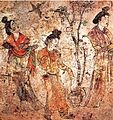 Palace ladies; from Li Xian's tomb, Tang dynasty, 706 AD. The girl in the middle is wearing a yuanlingpao.
Palace ladies; from Li Xian's tomb, Tang dynasty, 706 AD. The girl in the middle is wearing a yuanlingpao.
-
 Female servant in Tang dynasty dressed in a yuanlingpao; mid 8th century AD.
Female servant in Tang dynasty dressed in a yuanlingpao; mid 8th century AD.
-
 Men wearing round collar gown with boots, belt, trousers; Mural painting from the Tomb of Wang Chuzhi, Five dynasties and Ten kingdoms period.
Men wearing round collar gown with boots, belt, trousers; Mural painting from the Tomb of Wang Chuzhi, Five dynasties and Ten kingdoms period.
The shoes worn by Han Chinese were lü (履), xi (shoes with thick soles), women's boots, and ji (屐; wooden clogs) with two spikes were worn when walking outside on muddy roads; in the South, xueji (靴屐; a type of boot-like clog) was developed. Some shoes were commonly curved in the front and was phoenix-shaped.
The Tang dynasty represents a golden age in China's history, where the arts, sciences and economy were thriving. Female dress and personal adornments in particular reflected the new visions of this era, which saw unprecedented trade and interaction with cultures and philosophies alien to Chinese borders. Although it still continues the clothing of its predecessors such as Han and Sui dynasties, fashion during the Tang dynasty was also influenced by its cosmopolitan culture and arts. Where previously Chinese women had been restricted by the old Confucian code to closely wrapped, concealing outfits, female dress in the Tang dynasty gradually became more relaxed, less constricting and even more revealing. The Tang dynasty also saw the ready acceptance and syncretisation with Chinese practice, of elements of foreign culture by the Han Chinese. The foreign influences prevalent during Tang China included cultures from Gandhara, Turkestan, Persia and Greece. The stylistic influences of these cultures were fused into Tang-style clothing without any one particular culture having especial prominence.
An example of foreign influence on Tang's women clothing is the use of garment with a low-cut neckline. Women were also allowed to fashioned themselves into hufu (胡服) (i.e. foreign dress, which included the clothing of the Tartars or clothing of the people who lived in the Western Regions during this period). Popular menswear such as Persian-style round collared robes with tight sleeves and a central band decorated with flowers on the front was also popular among Tang dynasty's women; this Persian-style round collared robe is different from the local worn yuanlingpao (圆领袍). Long Persian trousers and knickers were also worn by women as a result of the cultural and economic exchanges which took place. Stripped trousers were also worn. The Chinese trousers during the Tang dynasty were narrow compared to the dashao (大袑) and the dakouku (大口裤) trousers worn in the preceding dynasties. Another popular garment worn in the 7th and 8th centuries which originated from Central Asia was the kuapao robe. It was a kaftan-like robe with tight-fitting sleeves, double overturned lapels, and a front opening; the kuapao could be used as main garment for cross-dressing attendants or could be draped across the shoulders like a cloak. The kuapao was also worn by men.
-
 Woman wearing hufu in Tang Dynasty.
Woman wearing hufu in Tang Dynasty.
-
 A sancai figurine of a woman holding a parrot, Tang dynasty.
A sancai figurine of a woman holding a parrot, Tang dynasty.
The headwear of the women in Tang dynasty also demonstrates evidence of foreign clothing inclusion in their attire. In Taizong's era, women wore a burqa-like mili (羃䍦) which concealed the entire body when horse back riding; the trend changed to the use of weimao (帷帽; a veiled curtain hat) during the reign of Emperor Gaozong of Tang and Wu Zetian; and after that, during the early reign of Emperor Xuanzong of Tang, women started wearing a veil-less hat called humao (胡帽; translated literally as "barbarian hat"); women eventually stopped wearing hats when horse riding, and by the 750's, women dressing in men's garments became popular.
Noble women of the Tang dynasty wore the veil, and after the Yonghui reign the veil with hat was worn. The Tang dynasty veils covered the women's face and neck. Song dynasty women continued to wear this Tang dynasty women's veil which covered the head and upper body despite its barbarian origin. The mili appears to have been adopted from the Tuyuhun ethnic minority of Qinghai which was worn by both men and women in the late 6th century; but full-body mili in the Tang dynasty was worn as a way to conceal the entire body, and thus it was considered as protecting women's modesty. The full-body veil was worn in both Sui and Tang dynasties. The full-body veil originating from the Rong and Yi barbarians started to be worn by Chinese women of noble and aristocratic families during the Sui dynasty and was enforced with laws during the Tang dynasty to make women wear it since women started abandoning it for the weimao which only covered the head and face. It was to stop strangers from seeing women and viewed as proprietious. When the full-body veil fashion started to fell out of favour, Emperor Gaozong of Tang issued imperials edict twice to order women to abandon the wear of weimao and returned to the burqa-like mili, covering the head and body with only a slit for vision, in order to stop women from being seen by men to enforce public decency. Due those imperial edicts, women decided to wear hoods that only let the face be shown or a veil that covered the sides of their head hanging from a broad rimmed hat with a veil, a curtain bonnet which originated from Tokâra; however, the Emperor Gaozong was not even satisfied with these because they let the face be shown and he wanted the burnoose to return and cover the face. However, his imperial edicts were only effective for a short period of time as the women started re-wearing the weimao. By the time of Wu Zetian's ascendancy, the weimao was back to fashion while the mili had gradually disappeared. After the mid-seventh century, the social expectation that women had to hide their faces in public disappeared. It was also fashionable for noble women to wear Huihuzhuang (回鶻装; Uyghur dress, which is sometimes referred as Huihu-style), a turned-down lapel voluminous robes with tight sleeves which were slim-fitting, after the An Lushan Rebellion (755 - 763 AD). Another trend which emerged after the An Lushan Rebellion is the sad and depressed-look while looking exquisite which reflected the instability of the political situation in this period. Of note, just like women in the Tang dynasty period incorporated Central Asian-styles in their clothing, Central Asian women were also wearing some Han Chinese-style clothing from the Tang dynasty and/or would combine elements of the Han Chinese-style attire and ornament aesthetic in their ethnic attire. In 840 AD, the Uyghur empire collapsed, the Uyghur refugees fled to Xinjiang and to the Southeast of Tang frontier to seek refuge, and in 843 AD, all the Uighur living in China had to wear Chinese-style clothing.
The influence of hufu eventually faded after the High Tang period, and women's clothing gradually regain a broad and loose fitting, and more traditional Han style clothing was restored. The sleeve width of women's garments for ordinary women was more than 1.3 meters. The daxiushan, (大袖衫; a "dress with broad sleeves") for example, was made of an almost transparent, thin silk; it featured beauty design and pattern on it and its sleeves were so broad that it was more than 1.3 meters. Based on the painting, "Court ladies adorning their hair with flowers" (簪花仕女圖; Zanhua shinü tu), a painting attributed to the painter Zhou Fang (active in the late 8th to early 9th century), women clothing was depicted as a sleeveless gown which was worn under a robe with wide sleeves, with the use of a shawl as an ornament; some of the women painted are fashioned with skirts while others are seen wearing an overskirt above on an underskirt; it is speculated that shawls and cloaks during this period were made from a silk-netted sheer gauze fabric material.
-
 A painting of Tang dynasty women playing with a dog, by artist Zhou Fang, 8th century.
A painting of Tang dynasty women playing with a dog, by artist Zhou Fang, 8th century.
-
 Buddhist donors of late Tang dynasty.
Buddhist donors of late Tang dynasty.
-
 A noble lady from the painting Bodhisattva Who Leads the Way, Five Dynasties and Ten Kingdoms.
A noble lady from the painting Bodhisattva Who Leads the Way, Five Dynasties and Ten Kingdoms.
-
 Buddhist donatress Chang, Five Dynasties and Ten Kingdoms.
Buddhist donatress Chang, Five Dynasties and Ten Kingdoms.
-
 Lady musicians in a raised-relief, Tomb of Wang Chuzhi (d. 923AD) from the Capital Museum in Beijing, dated to the Five Dynasties and the Ten Kingdoms Period (907-960 AD).
Lady musicians in a raised-relief, Tomb of Wang Chuzhi (d. 923AD) from the Capital Museum in Beijing, dated to the Five Dynasties and the Ten Kingdoms Period (907-960 AD).
-
 Mural of Wang Chuzhi tomb, Southern Tang.
Mural of Wang Chuzhi tomb, Southern Tang.
-
 Women of Southern Tang holding a baby, 10th century AD.
Women of Southern Tang holding a baby, 10th century AD.
-
 Men and women in the Night Revels of Han Xizai painting, copy after the original painting of Southern Tang painter, Gu Hongzhong.
Men and women in the Night Revels of Han Xizai painting, copy after the original painting of Southern Tang painter, Gu Hongzhong.
-
 Men and women in the Night Revels of Han Xizai painting, copy after the original painting of Southern Tang painter, Gu Hongzhong.
Men and women in the Night Revels of Han Xizai painting, copy after the original painting of Southern Tang painter, Gu Hongzhong.
-
 A Buddhist donor from early Northern Song dynasty.
A Buddhist donor from early Northern Song dynasty.
Song dynasty
See also: Popular fashion in ancient ChinaThe Song dynasty (960 - 1279 AD) clothing system was established at the beginning of the Northern Song dynasty (960 - 1127 AD). Clothes could be classified into two major types: officials garments (further differentiated between court clothing and daily wear), and the garment for ordinary people. Some features of Tang dynasty clothing were carried into the Song dynasty, such as court dress. Song dynasty court dress often used red colour, with accessories made of different colours and materials, black leather shoes and hats. The officials had specific clothing for different occasions: (1) the sacrificial dress, a vermillion colour garment worn when attending ancestral temple or grand ceremonies, which they had to wear with the proper hats, i.e. jinxian guan (進賢冠), diaochan guan (貂蟬冠) or xiezhi guan (獬豸冠); (2) the court dress, which was worn when attending court meeting held by the Emperor and sometimes during sacrificial rituals; and (3) the official gown, worn daily by officials who held ranks. The form of officials' daily dresses had the same design regardless of rank: round-collared robe with long and loose sleeves; however, the officials were bound to wear different colours according to ranks. As the Song dynasty followed the Tang dynasty's clothing system, officials of third ranks and above wore purple gown; fifth ranks officials wore vermillion gown; seventh ranks officials and above wore green gowns; and the ninth rank officials and above wore black gown. However, after the Yuanfeng period, changes were imposed on the colour system of the official gowns: officials of the fourth rank and above wore purple gown, the sixth rank and above wore crimson gown; and the ninth rank and above officials wore green gown; this noted the removal of black colour as a colour for the official dress. Officials also wore leather belts and kerchiefs as ornaments. If senior officials were allowed to wear purple or crimson official garments, they had to wear a silver or gold fish-shaped bag as ornament. The official gown were worn with different styles of futou (襆頭) and guan (冠) as headwear. For example, jinxian guan (进贤冠) was worn by general officials; diaochan guan (貂蝉冠), also known as longjin (笼巾; cage kerchief), was worn by senior officials; and xiezhi guan (獬豸冠), also called the "Legal hat", was worn by enforcement officials.
-
 Male Buddhist Donor, Northern Song dynasty, 981 AD.
Male Buddhist Donor, Northern Song dynasty, 981 AD.
-
 Eight riders in Spring, Song dynasty.
Eight riders in Spring, Song dynasty.
-
 The Chinese Emperor during the Civil Service Examination, Song dynasty.
The Chinese Emperor during the Civil Service Examination, Song dynasty.
-
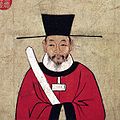 A painting of Sima Guang, Song dynasty.
A painting of Sima Guang, Song dynasty.
The apparels for court gathering in the Song dynasty was tongtianguanfu (通天冠服); it was worn by the most senior officials who served the emperor directly; it was the most important clothing after the clothing worn by the emperor. The tongtianguanfu was the combination of a deep red gown with dragons in clouds embroidery, a deep red trousers, a white shirt, white stockings, black shoes; personal ornaments, belt of gold or jade, a tall hat called tongtian guan (通天冠), and personal ornaments were also worn with the tongtianguanfu.
The clothes worn by Song dynasty emperors are collectively called tianzi apparel (天子服饰; the emperor's apparel). The apparels worn when attending sacrificial and worshipping ceremonies were daqiumian (大裘冕; a type of mianfu), gunmian (衮冕; a type of mianfu), and lüpao (履袍). The emperor's daily wears were shanpao (衫袍) and zhaipao (窄袍). The yuyue fu (御阅服) was the formal military uniform worn by the Song dynasty Emperors and only came into existence in the Southern Song dynasty (1127 - 1279 AD). The crown prince would wear the gunmian (衮冕) when he would accompanied the emperor to sacrificial ceremonies, and he would wear yuanyouguanfu (远游冠服) and zhumingfu (朱明衣) on less formal but important occasions such as nobility conferring and appointment, when paying visits to the founding ancestor's temple and when attending court meetings which are held by the Emperor. The Crown prince also wear purple official dress, gold and jade waistband, and wore a folding-up black muslin scarf on his head.
Although some of clothing in the Song dynasty have similarities with previous dynasties, some unique characteristics separate it from the rest. While most of them following the Tang dynasty style, the revival of Confucianism influenced the women clothing of the Song dynasty; Confucians in the Song dynasty revered antiquity and wanted to revive some old ideas and customs and encouraged women to reject the extravagance of the Tang dynasty fashion. Due to the shift in philosophical thought, the aesthetics of the Song dynasty clothing showed simplicity and became more traditional in style. Palace ladies searched for guidance in the Rites of Zhou on how to dress accordingly to ceremonial events and carefully chose ornaments which were graded for each occasion based on the classic rituals. While women of the Tang dynasty liked clothing which emphasized on body curves and sometimes revealed décolletage, women in the Song dynasty perceived such styles as obscene and vulgar and preferred slender body figure. Donning clothing which looked simple and humble instead of extravagant was interpreted as expressing sober virtue. The Song dynasty clothing system also specified how women of the imperial court had to dress themselves and this included the Song empresses, the imperial concubines, and the titled gentlewomen; their clothing would also change depending on occasions. Song dynasty empresses wear the huiyi (褘衣); they often had three to five distinctive jewelry-like marks on their face (two side of the cheek, other two next to the eyebrows and one on the forehead). The everyday clothing of the Empresses and Imperial concubines included: long skirts, loose-sleeves garments, tasselled capes and beizi. Imperial concubines like the colour yellow and red; the pomegranate colour skirt was also popular in the Song dynasty. Collar edges and sleeve edges of all clothes that have been excavated were decorated with laces or embroidered patterns. Such clothes were decorated with patterns of peony, camellia, plum blossom, and lily, etc. Pleated skirts were introduced and became the characteristic skirts of the upper social class.
-
 Portrait of Song Taizu wearing a white round-collar gown and a zhanchi futou (展翅幞頭; lit. spread wings hat), c.1000 AD.
Portrait of Song Taizu wearing a white round-collar gown and a zhanchi futou (展翅幞頭; lit. spread wings hat), c.1000 AD.
-
 Empress Cao wearing a huiyi with two court ladies wearing a round-collar gown with red pleated skirts, Song dynasty.
Empress Cao wearing a huiyi with two court ladies wearing a round-collar gown with red pleated skirts, Song dynasty.
-
 A Song dynasty period painting of Emperor Wen of Han in bianfu.
A Song dynasty period painting of Emperor Wen of Han in bianfu.
-
 Emperor and empress, Fresco from the Temple of Enlightenment - Life of Buddha, Song dynasty.
Emperor and empress, Fresco from the Temple of Enlightenment - Life of Buddha, Song dynasty.
One of the common clothing styles for woman during the Song dynasty was beizi (褙子), which were usually regarded as shirt or jacket and could be matched with ru (襦; a jacket), which was a necessary clothing for daily life of commoners, a qun (裙; skirt) or ku (袴; trousers). There are two size of beizi: the short one is crown rump length and the long one extended to the knees. According to the sacrificial and ceremonial apparel system drafted by Zhu Xi, women should wear an overcoat, a long skirt, and the beizi. Other casual forms of clothing included: the pao (袍; the gown which could be broad or narrow-sleeved), ao (襖; a necessary coat for commoner in their daily lives), duanhe (短褐; a short, coarse cloth jacket worn by people of low socioeconomic status), lanshan (襴衫), and zhiduo (直裰). According to the regulations, ordinary people were only allowed to wear white clothes; but at some point, the regulations changed and ordinary people, as well as administrative clerks and intellectuals, were able to wear black clothes. However, in reality, the clothing worn by civilians were much more colourful than what was stipulated as many colours were used in the garments and skirts. Han Chinese women's skirts worn in the Song dynasty included the liangpian qun (两片裙), a wrap skirt which consist of two pieces of fabric sewn to a separate, single waistband with ties. Ordinary people also dressed differently accordingly to their social status and occupations. A painting, called Sericulture, by the painter Liang Kai in Southern Song dynasty depicts rural labourers in the process of making silk. Foot binding also became popular in the Song dynasty at the end of the dynasty.
-
 Song dynasty painting, 12th century.
Song dynasty painting, 12th century.
-
 A working woman who is wearing trousers, Song dynasty painting.
A working woman who is wearing trousers, Song dynasty painting.
-
 Song dynasty women wearing beizi; Northern Song dynasty.
Song dynasty women wearing beizi; Northern Song dynasty.
-
 Song Dynasty Tomb Painting Found in Tengfeng City 6.
Song Dynasty Tomb Painting Found in Tengfeng City 6.
-
 A Song period mural depicts a scene of the daily life of the occupant, found in a tomb unearthed in Dengfeng.
A Song period mural depicts a scene of the daily life of the occupant, found in a tomb unearthed in Dengfeng.
-
 Children Playing in an Autumn Courtyard, 12th century AD, Song Dynasty.
Children Playing in an Autumn Courtyard, 12th century AD, Song Dynasty.
-
 Playing Children, Painting from the mid-12th century; Song dynasty.
Playing Children, Painting from the mid-12th century; Song dynasty.
-
 Weighing and sorting the cocoons, from the painting Sericulture, Southern Song dynasty, c.1200 AD.
Weighing and sorting the cocoons, from the painting Sericulture, Southern Song dynasty, c.1200 AD.
-
 Poet Li Bai in Stroll (李白行吟圖). A 減筆畫 (lit. minimalist painting) by Liang Kai of Southern Song dynasty. Note that Li Bai is depicted with his bun exposed, possibly due to the poet's heavy Taoist influence. The painting is currently kept in Tokyo National Museum.
Poet Li Bai in Stroll (李白行吟圖). A 減筆畫 (lit. minimalist painting) by Liang Kai of Southern Song dynasty. Note that Li Bai is depicted with his bun exposed, possibly due to the poet's heavy Taoist influence. The painting is currently kept in Tokyo National Museum.
In addition, Neo-Confucian philosophies also determined the conduct code of the scholars. The Neo-Confucians re-constructed the meaning of the shenyi, restored, and re-invented it as the attire of the scholars. Some Song dynasty scholars, such as Zhu Xi and Shaoyong, made their own version of the scholar gown, shenyi, based on The book of Rites, while scholars such as Jin Lüxiang promoted it among his peers. However, the shenyi used as a scholar gown was not popular in the Song dynasty and was even considered as "strange garment" despite some scholar-officials appreciated it.
In the capital of Southern Song, clothing-style from Northern China were popular. The Song dynasty court repeatedly banned people (i.e. common people, literati, and women) from wearing clothing and ornaments worn by Khitan people, such as felt hats, and from the wearing of exotic clothing. They also banned clothing with colours which was associated to Khitan clothing; such as aeruginous or yellowish-black. They also banned people, except for drama actors, from wearing Jurchen and Khitan diaodun (釣墩; a type of lower garment where the socks and trousers were connected to each other) due to its foreign ethnic nature. Many of Song dynasty clothing was adopted in the Yuan and Ming dynasties.
Liao, Western Xia, and Jin dynasties
Liao dynasty
After the fall of the Tang dynasty, the Khitan, a branch of the Eastern Xianbei tribes, established Liao dynasty (916–1125 AD) in Northern China and Northeast Asia. The Liao dynasty was constituted of two regions: the Northern and Southern Divisions. The Northern divisions of Liao was mainly composed of tribal Khitan people while the Southern regions was composed of Han Chinese and other sedentary groups. The rulers of the Liao dynasty adopted a clothing system which allowed the coexistence of Han Chinese and Khitan clothing. According to the History of Liao, the earliest clothing worn by the Khitan used to made with animal hides, and it is only during the reign of Emperor Taizong of Liao that an apparel system was developed. Culturally, the Khitan was closer to the Tang dynasty culture than the Song dynasty culture; and under the influence of Tang dynasty culture, they started to include silk garments (e.g. jackets and robes) to their wardrobe and conform their clothing customs to the clothing customs of the Tang dynasty, thus fashioning themselves in Han Chinese-style while maintaining some distinction in their attire. The Khitan court adopted both the guofu (國服; Khitan National garments) and hanfu (漢服; Han Chinese clothing) which the Khitan inherited from the Later Jin dynasty and were actually clothing from the Tang dynasty. The guofu of the Liao dynasty was also heavily influenced by the Han Chinese clothing system. In the Liao dynasty, Khitan officials and the Liao empresses wore Khitan clothes, but the Han Chinese officials and Liao emperor wore Song dynasty clothes (Han clothes). However, after 970 AD, it was decreed that all top Khitan officials had to be dressed in Chinese style clothing while the lower officials of Kithan origins had to continue to wear their native dress for the Great Willowtree Shooting ceremony (大射柳; dasheliu) when praying for rain. This changes again in 1055 AD when the emperor decreed that all Khitan officials had to wear Chinese-style clothing.
Based on mural paintings from Khitan tombs during the Liao dynasty, a typical outer garment worn by the Khitan men is a narrow-sleeved, round-collar gown which falls just above the ankles, and opens from the waist down on both sides but not in the front and back; they also wear a bely around the hip area. The lapels of their outer garments appears to be right lapels crossing over the left, and they also fastened their lapels on the left under the arm. The inner garment of Khitan's man was a short garment or tunic worn under the round-collar gown. They also wore trousers and high-toped boots which were either bordered or rolled at the top. Khitan officials used gold ornamented ribbons to found their hair locks around their foreheads, covering their heads with felt hats according to the Ye Longli's Qidan Guozhi. Khitan wore the long side fringes & shaved pates. Tomb murals of Khitan hairstyle show only some hair remaining near the neck and forehead with the rest of the head shaved. Only at the temples were hair left while the crown was shaven. The absence of Khitan clothes and hairstyles on a painting of riders previously identified as Khitan has lad to experts questioning their purported identity. Khitan males grew hair from their temples but shaved the crown of their heads. Khitan men might have differentiate between classes by wearing different patterns on their small braids hanging off their shaved foreheads. They wore the braids occasionally with a forehead fringe with some shaving off all the forehead. Khitan men left only two separate patches of hair on each of the forehead's sides in front of each ear in tresses while they shaved the top of their head. Khitan wore felt hats, fur clothes and woollen cloth and the Liao emperor switched between Han and Khitan clothing.
Non-Han women such as Central Asian women often adopted Han dress while their men did not during the Tang dynasty. The Liao had both Han Chinese Tang and Song dynasty-style clothes and Khitan clothes. Both Khitan women and Han Chinese women in the Liao wore Han style Tang-Song dress. The Han Chinese men living in the Liao dynasty were not required to wear the shaved Khitan hairstyle which Khitan men wore to distinguish their ethnicity, unlike the Qing dynasty which mandated wearing of the Manchu hairstyle for men.
In Han Chinese tombs dating from Liao dynasty, there are tombs murals which depicts purely Chinese customs and Chinese clothing. Tombs in haner families (i.e. Han Chinese of mixed origins or who have adopted some Khitan customs), for example the Zhang and Hann families, often depicts men dressed in Khitan clothing in corridors and antechambers while inner culture shows haner culture. Some Han Chinese or Haner men adopted and mixed or combined Han clothing with Khitan clothing with Khitan boots and Han clothes or wearing Khitan clothes. Han women on the other hand did not adopt Khitan dress and continued wearing Han dress. For example, the tomb of Hann Shixun (a man from distinguished haner families) who died in the early 12th century during the late Liao dynasty depict Khitan-style clothing in the antechamber whereas women in Han Chinese-style clothing is seen in the painting found in the inner chamber. Another example can be seen in a mural painting found in the tomb of Zhao Wenzao, where children and servants are depicted wearing Khitan hairstyles and Khitan-style clothing, while the woman who is standing behind the table is depicted in Han Chinese clothing. During the Liao dynasty, Han Chinese women living in the Southern Division and Haner women were culture bearers, who generally preserved Han Chinese culture and continued to wear the Han Chinese clothing which was worn prior to the conquest.
-
 Yelü Bei
Yelü Bei
-
 Liao horsemen at rest
Liao horsemen at rest
-
 Horsemen
Horsemen
-
-
 A Khitan man hairstyle, Beisanjia Tomb No.1, Liao dynasty.
A Khitan man hairstyle, Beisanjia Tomb No.1, Liao dynasty.
-
 Liao men preparing for hunt, mural from tomb of Aohan, Lian dyansty.
Liao men preparing for hunt, mural from tomb of Aohan, Lian dyansty.
-
 Liao cooks, Tomb in Aohan, Liao dynasty.
Liao cooks, Tomb in Aohan, Liao dynasty.
-
 Preparing drinks, Mural from Tomb in Aohan, Liao Dynasty
Preparing drinks, Mural from Tomb in Aohan, Liao Dynasty
- File:Khitan.jpg
-
 Khitan women; Baoshan tomb No.2 wall-painting of Liao dynasty.
Khitan women; Baoshan tomb No.2 wall-painting of Liao dynasty.
-
 Khitan women wearing Tang-style clothing, mural from Baoshan Tomb No.2, Liao dynasty.
Khitan women wearing Tang-style clothing, mural from Baoshan Tomb No.2, Liao dynasty.
-
 Khitan woman, Baoshan Tomb No.2, Liao dynasty.
Khitan woman, Baoshan Tomb No.2, Liao dynasty.
-
 Mural painting from the Tomb of Zhang Kuangzheng (M10), Liao dynasty, 1058-1093 AD. Children and servants wear Khitan-style clothing and hairstyle; the standing women wears Han Chinese clothing.
Mural painting from the Tomb of Zhang Kuangzheng (M10), Liao dynasty, 1058-1093 AD. Children and servants wear Khitan-style clothing and hairstyle; the standing women wears Han Chinese clothing.
-
 Women possibly wearing shanqun (upper garment over skirt) and beizi (Song-style clothing), inner chamber of the Tomb of Zhang Kuangzheng, Liao dynasty.
Women possibly wearing shanqun (upper garment over skirt) and beizi (Song-style clothing), inner chamber of the Tomb of Zhang Kuangzheng, Liao dynasty.
Jin dynasty
After the Jin dynasty (1115–1234 AD) was founded, the Jin dynasty rulers imitated the Song dynasty and decided to establish their own carriages and apparel system. In 1125, the Jin dynasty destroyed the Liao dynasty, and in 1127, the Jin invaded Northern Song and sacked the capital city, Kaifeng. There was about 30 million Han Chinese living under the rule of the Jin dynasty. In the early period of the Jin dynasty, the Jin dynasty court first attempted to impose Jurchen hairstyle and clothes on the Han Chinese population in 1126 AD and in 1129 AD. The Han Chinese style clothing was prohibited and the people had to wear a short scarf and left-lapelled clothing; if they did not obey, they were put to death. Unlike the tonsure of the Tangut Western Xia, the Jurchen hairstyle of wearing the queue combined with shaving the crown was not the invention of an emperor of the dynasty but was an established Jurchen hairstyle which showed who submitted to Jin rule. This Jurchen queue and shaving hairstyle was not enforced on the Han Chinese in the Jin after an initial attempt to do so which was a rebuke to Jurchen values. However, the rules were not observed and the order was taken back under the Emperor Wanyan Liang who was Pro-Chinese allowing the Han Chinese to wear their Han clothing by lifting the ban in 1150 AD. After the occupation of the Northern Song territories by the Jurchens in 1127 AD, the Han Chinese who were living in Northern Song territories became the majority while the Jurchen became an ethnic minority in the Jin dynasty; this lead to the Jurchens to make political concessions allowing the Han Chinese to practice Han Chinese culture. In 1138 AD, the Jin court adopted the Chinese robes for the emperor and the officials.
In 1161-1189 AD, many Jurchens appear to have started to adopt Han Chinese behavior and have started to forget their own traditions and languages; therefore, the emperor Emperor Shizong of Jin prohibited the Jurchens from dressing like the Han Chinese in 1191 AD (which they had been doing for forty years) and from adopting Chinese family and personal names as he wanted to revitalize the old Jurchen culture. The Jin dynasty court had also banned intermarriage, but this ban was also lifted in 1191 AD. However, despite his efforts, the influence of the Han Chinese living in the Northern Song territories had a significant influence and by the mid-twelve century, the Jurchens were sinicized so much that they were almost indistinguishable from the Han Chinese in terms of dress, literacy and social customs. Based on Han Chinese tombs of the Jin dynasty, it appears that ordinary Jurchen clothing may have been a symbol of lower class status as servants and lower class women tend to be portrayed as wearing modified Jurchen-style clothing whereas women from the upper class wear Han Chinese style clothing. Yet despite the Han Chinese influence on Jurchens, travellers from the Southern Song dynasty (1127–1279 AD) who visited the former territories of the Song dynasty noted that there have been changes in the people's culture and that the Han Chinese's clothing-style had also been influenced by the Jurchens in terms of adoption of items; they also noted that the only thing which had not changed much was the women's clothing style. However, the clothing-style of the Han Chinese women living the Jin dynasty was outdated compared to the Han Chinese women in the Southern Song territories. The yunjian (雲肩; cloud collar) originated from the Jin dynasty (1115–1234) and was adopted in the Yuan dynasty as a signature pattern on men's and women's clothing.
-
 Standing official with tablet, China, possibly Handan, Hebei, Jin dynasty, early 1200s AD.
Standing official with tablet, China, possibly Handan, Hebei, Jin dynasty, early 1200s AD.
-
 Jin Dynasty Tomb of Zou Fu, 1199 AD.
Jin Dynasty Tomb of Zou Fu, 1199 AD.
-
 Jin Dynasty Tomb of Zou Fu, 1199 AD.
Jin Dynasty Tomb of Zou Fu, 1199 AD.
Western Xia
The founder of Western Xia (1038–1227 AD), Emperor Jingzong, established an apparel system which were characterized by the Tangut people's culture; the apparel system was established for all civil and military officials. The Han Chinese-style and the Tangut-style clothing were distinguished from each other, but both were used in the Western Xia. The Han-style clothing was worn by officials whereas the Tangut-style clothing was worn by the military. Civil officials wore futou, boots, purple or crimson gown. Envoys of Western Xia were always dressed in narrow gown and wore golden diexie, leather boots, and golden hats. The emperor of Western Xia wore round-collar gown with dragons roundels, high hats, and wore a belt over their gown. The women in Western Xia wore skirts and embroidered narrow-sleeved, cross-collared gowns which tend to be made of coarse cloth, fine wool, and animal hides. Servants wore round-collared, narrowed-sleeved gowns of various colours which was decorated with roundels and fastened their gown with a waistband. Emperor Jingzong rejected Han Chinese silk clothing over the leather-based and wool clothing of the nomadic people from the Steppe; he argued that the Tanguts had traditionally worn leather-based and wool clothing and since the Tanguts men were military, they also had no use of silk materials. Yet, silk clothing was still worn in Western Xia during his reign. Emperor Jingzong also ordered that every people in Western Xia must be shaved in an attempt to restore old Xianbei customs, and disobedience was death penalty. However, in 1061 AD, Emperor Yizong, the son of Emperor Jingzong, decided to replace Tangut clothing with Han Chinese clothing in his court. In his wish list to the Song dynasty court, Emperor Yizong asked permission to use Han Chinese rites and clothing to greet Song dynasty envoys and seek permission to buy Chinese official clothing; both of these requests were granted.
-
 Tangut Emperor and a boy, a Western Xia Painting, 13 century.
Tangut Emperor and a boy, a Western Xia Painting, 13 century.
-
 Sitting figures, Western Xia painting, 13 century.
Sitting figures, Western Xia painting, 13 century.
-
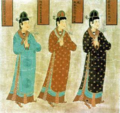 Mural depicting women wearing a cross-collared gown and skirts; Western Xia.
Mural depicting women wearing a cross-collared gown and skirts; Western Xia.
-
 Mural depicting men; Western Xia.
Mural depicting men; Western Xia.
Yuan dynasty
During the Yuan dynasty (1271–1368 AD), Mongol dress was the clothing of elite for both genders. Although Mongol clothing had been influenced by the Han Chinese clothing, the Mongol attire worn in the 13th-14th century was completely different from the Han Chinese clothing which had been worn in the Tang dynasty and Song dynasty. The Mongol attire was shared by people of different social ranking due to its practicality which contrasted with the dress code of the Han Chinese; as such, Mongol attire was popular. An important and popular robe for male Mongols was the terlig, known as bianxian ao (辫线袄; plait-line coat) or yaoxian ao (腰线袄; waist-thread coat) by Han Chinese; this coat had decorations at the waist, tight sleeves, and pleats at the lower hem which made it convenient for horse riding and was worn by all social classes. The most notable terlig is the jisün garment, known as zhisun fu (质孙服) in Chinese. The jisün garment was one of the most important male court garment of the Yuan dynasty; it was worn by the emperors and bestowed from the emperors to officials; it can also be called zhisun (质孙 or 只孙), jixun (济逊), or zhama (诈玛). The original jisün was worn by the Mongols prior to the establishment of the Yuan dynasty, but it became more elaborate in the Yuan dynasty. In the History of Yuan, the jisün is also described as yisefu (一色服, dress in one colour) and were usually found in one colour. The boli hat (钹笠帽; boli mao) was a popular hat which was worn by the Mongols in Yuan dynasty as it had a wide brim which made it sun-proof and rain-proof; it was worn by emperors, officials and male commoners. The creation of the Mongol hat with a wide brim has been attributed to Empress Chabi. Mongol men also wore a sleeveless and collarless garment like a vest, called bijia (比甲), whose making is also attributed to Empress Chabi. Mongol men swept their hair behind their ears and plaited them. The Mongol women in the Yuan dynasty continued to wear the clothing that they wore before the fall of the Song dynasty, along with a tall headdress called the gugu hat (罟罟 冠 or 固姑冠 or 顧姑冠; guguguan). The gugu hat was also known as boqta or boghta. The robe of Mongol women was described as looking similar to the Chinese Taoist garment; it was very wide, was open in the front, was fastened in three places, was double-breasted, and was cut in the same way as the robe of their male counterpart. The Mongol woman's robe was long and was one-piece; its sleeves were also narrow-sleeved at the wrists. The long, red Mongol robe became the official dress was worn by elite Mongol women. Another woman's garment worn during the Yuan dynasty is a short overjacket.
-
 Tolui With Queen Sorgaqtani, parents of Kublai Khan, and their surrounding all wear Mongol-style clothing, painting by Rashid-al-Din Hamadani in the Jami' al-tawarikh, early 14th century AD.
Tolui With Queen Sorgaqtani, parents of Kublai Khan, and their surrounding all wear Mongol-style clothing, painting by Rashid-al-Din Hamadani in the Jami' al-tawarikh, early 14th century AD.
-
Kublai Khan, Empress Chabi, and his men going for hunt are all wearing Mongolian-style attire, which is distinct from Han Chinese clothing, Yuan dynasty by Liu Guandao, c. 1280.
-
 Portrait of Yuan dynasty empresses, wearing the Mongolian robe and guguhat; a distinct way of dressing from the Han Chinese women.
Portrait of Yuan dynasty empresses, wearing the Mongolian robe and guguhat; a distinct way of dressing from the Han Chinese women.
-
 Figure of a Mongol man wearing Mongol attire and a boli hat, Yuan dynasty.
Figure of a Mongol man wearing Mongol attire and a boli hat, Yuan dynasty.
In the Yuan dynasty, the Mongols never imposed Mongol customs on the Han Chinese. Many Han Chinese and other ethnicities readily adopted Mongol clothing in Northern China to show their allegiance to the Mongols; however, in Southern China, Mongol clothing was rarely seen as both men and women continued to dress in Song-style garments. In the tomb of a woman from a Southern Song site, dating from the late-Yuan dynasty in Fuzhou, Fujian, the two-pieces system of Southern Song clothing (i.e, the skirt and the upper garment) has been found instead of the Mongol women's one-piece robe. Burial clothing and tomb paintings in the southern territories of the Yuan dynasty also show that women wore the Song-style attire, which looked slimmer when compared to the Mongol court robe. The Song-style clothing is also depicted as consisting of jackets, which were open in the front and had long, narrow and thin sleeves, and sometimes women are depicted as wearing a sleeveless vest-type jackets with front openings. For example, in the Yuan dynasty mural paintings from Dongercun from 1269 AD in Shaanxi and in the mural painting in tomb M2 at Kangzhuangcun in Tunliu from 1276 AD, maids and servants are seen wearing Song-style attire. Moreover, the type of clothing worn in the Yuan dynasty may have also served as a political statement; for example, despite not being the clothing of the ruling elite, the Tang-Song style clothing worn in multiple layers continued to be worn by families who showed that they were resisting the rule of the Mongols. A form of skirts worn in the Yuan dynasty is a skirt which consist of two parts sewn to a separate single waistband which may also be pleated. In the Yuan dynasty, theatre zaju drama actors wore all different clothes ranging from Jurchen, to Khitan, to Mongol, to Song Han Chinese clothes.
-
 The tomb occupants are Chinese but are wearing Mongol-style clothing. The female tomb occupant is depicted wearing the woman's red Mongol robe under a short overjacket but does not wear the gugu hat, Shazishan Tomb Fresco, Yuan Dynasty, Chifeng Museum.
The tomb occupants are Chinese but are wearing Mongol-style clothing. The female tomb occupant is depicted wearing the woman's red Mongol robe under a short overjacket but does not wear the gugu hat, Shazishan Tomb Fresco, Yuan Dynasty, Chifeng Museum.
-
 A female figure from Vimalakirti and the Doctrine of Nonduality, Yuan dynasty.
A female figure from Vimalakirti and the Doctrine of Nonduality, Yuan dynasty.
-
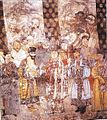 Yuan dynasty theatre actors wore elaborate costumes and stereotyped facial makeup; diverse costumes of different nationalities were worn, Yuan dynasty, 1324 AD.
Yuan dynasty theatre actors wore elaborate costumes and stereotyped facial makeup; diverse costumes of different nationalities were worn, Yuan dynasty, 1324 AD.
-
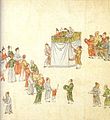 Puppeteers draw a crowd, Yuan Dynasty, 14th century AD.
Puppeteers draw a crowd, Yuan Dynasty, 14th century AD.
-
 Man Riding a Horse in a round-collared gown, Yuan dynasty painting by Zhao Mengfu, dated 1296 AD.
Man Riding a Horse in a round-collared gown, Yuan dynasty painting by Zhao Mengfu, dated 1296 AD.
Ming dynasty
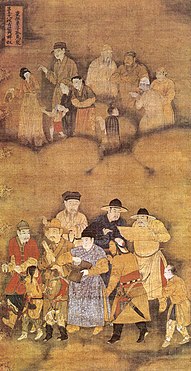
The Ming dynasty had many Mongol clothes and cultural aspects abolished and enforced Tang dynasty style Han Chinese clothing.
As soon as the Hongwu Emperor conquered the Yuan dynasty, he decried the "barbarian customs" of the Yuan dynasty and how people imitated the Mongols for personal gains; and so, he called for the restoration of Han Chinese traditions, which included the proper forms of dress, hairstyles, and attires. According to the Veritable Records of Hongwu Emperor (太祖實錄), a detailed official account of daily activities of Hongwu Emperor written by court historians, he restored the entire clothing system back to the standard of Tang dynasty shortly after the founding of Ming dynasty.
"On the Renzi day in the second month of the first year of Hongwu era (Feb 29th, 1368 CE), Hongwu emperor decreed that all fashions of clothing and headwear shall be restored to the standard of Tang, all citizens shall gather their hairs on top of their heads, and officials shall wear the Wu Sha Mao (black-cloth hats), round-collar robes, belts, and black boots." ("洪武元年二月壬子...至是,悉命復衣冠如唐制,士民皆束髮於頂,官則烏紗帽,圓領袍,束帶,黑靴。")
The attempt was to signified the Han Chinese cultural identity after defeating the Yuan dynasty. The new clothing system that the Hongwu Emperor formulated was based on the dress code of the previous dynasties, which included the dress codes of the Zhou, Han, Tang, and Song dynasties. He also promulgated several decrees to ban Mongol and nomadic clothing style. However, fashionable Mongol attire, items and hats were still sometimes worn by early Ming royals, such as Hongwu Emperor himself and Zhengde Emperor. Thus, the Ming dynasty clothing absorbed elements of both Han Chinese and Mongol clothing.
The boli hat (钹笠帽) worn by the Mongols in the Yuan dynasty influenced the Han Chinese and continued to be used widely in the Ming dynasty in the form of the damao (大帽; big hat), which was worn by the government clerks and family servants. The use of the damao by the family servants of the Ming officials and the imperial family contributed popularity spread of that hat which eventually become a symbol of low-ranking servants. The jisün garment that had been popular in the Yuan dynasty was adopted by Ming dynasty as the yesa robe (曳撒袍) with minor changes. The yesa robe, also known as yisa (一撒), is a cross-collared, long sleeved robe with narrow pleats on the lower hem; while the back of the lower part is flat, the front had two densely pleated sides with a flat middle. The yesa robe was worn as an informal attire by emperors, princes, ministers, and officials in their spare time during the early period of the Ming dynasty; it was worn as a formal uniforms in some occasions during the middle period of the Ming dynasty; it was worn as a casual dress worn by scholar-officials during the mid-to-late period of the Ming dynasty; and eventually it was worn by servants and commoners in the late Ming. The yesa robe were also worn by the court bodyguard, the xiaowei (校尉; guards of honour), the brocade guards (锦衣卫), and by court servants who where in charge of whip-throwing, fan-holding and umbrella-like towel-holding duties. The Ming court eunuchs wore yesa robe in different styles, such as the red-coloured yesa robes with a qilin patch, round-collared yesa robes, and light green yesa robe, etc. The Ming dynasty also adopted bijia (比甲; an open-sided long vest), humao (胡帽; barbarian hat), and a waistcoat with buttons at the front from Yuan dynasty.
-
 The Jinyiwei, also known "Brocade-clad guards", dressed in their uniforms to guard the Emperor's treasures, Ming dynasty.
The Jinyiwei, also known "Brocade-clad guards", dressed in their uniforms to guard the Emperor's treasures, Ming dynasty.
-
 Painting of a lady wearing the Ming-style bijia (比甲), which extends down the knees.
Painting of a lady wearing the Ming-style bijia (比甲), which extends down the knees.
The Ming dynasty developed a new attire from Yuan dynasty's terlig: tieli (贴里); it is a cross-collared, long sleeved robe with dense and narrow pleats all around the lower hem. The tieli was mainly worn by the upper class and rarely worn by the lower class. In the Veritable Records of the Joseon Dynasty, tieli were recorded as ch'obli (帖裡), bestowed as present by the Ming dynasty from the year 1424; however, the terlig-style attires found in both countries differed from each other in terms of form and historical development. Other new Ming dynasty attires influenced by the Yuan dynasty include the small hat (小帽), the dahu (褡护) jacket. Archeological evidence from the tombs of Ming dynasty princes show that the Mongol-style attire continued to exist well until the 16th century.
The founder of the Ming dynasty, the Hongwu Emperor, saw the fundamentality of making a new dress code to consolidate his rule; he spent almost all his reigning years developing and institutionalizing dressing regulations, which were recorded in various compilation of texts, such as the Collected Statutes of the Ming Dynasty. The dressing regulations were based on the dressing system of the Tang and Song dynasties. Moreover, the Ming dynasty dressing regulations were strongly related to the ritual system; the Confucian codes and ideals that were popularized during the Ming dynasty also had a significant effect on those regulations. The dressing regulations determined what attire and ornaments could be worn depending on one's social ranks. For example, the Ming dynasty's basic dressing principles, announced in 1392, included the following:
"Officials’ robes should fit their bodies. The length of those worn by civil officials is one inch from the ground. The sleeves should be long enough to reach the elbows when they are folded back from the end of the hands; they should be one foot wide, with cuffs of nine inches wide. The sizes of nobles (gonghou), and imperial sons-in-law's robes are the same as civil officials’. So are the sizes of seniors and primary degree holders’ robe, except for the sleeves, which are three inches from the elbow when folded from the hands. A commoners’ robe is five inches from the ground. So is a military official's; their sleeves should be seven inches over their hands, with cuffs as broad as their fists. Soldiers’ clothes are seven inches from the ground, with sleeves five inches longer than their hands, and seven inches wide. Their cuffs are wide enough only for their fists to stretch out".
In the Ming dynasty, the inner garment that people wore were called neidan (内单). The fabric material of the outer garment are determined by one's social status. The emperors tend to wear yellow satin gown with dragon designs, jade belts, and yishan guan (翼善冠; philanthropy crown, with wings folded upwards). The yishan guan were only worn by emperors and other members of the royal family on formal occasions. Officials wore different wore robes of various colours and patterns; they also wore gauze hats. Civil and military officials wore different types of guanfu (官服), depending on occasions and events: chaofu (朝服; court dress), the jifu (祭服; sacrificial ceremony dress), the gongfu (公服; public service dress), the changfu (常服; everyday dress), and the yanfu (燕服; casual or leisure clothing). The officials' robes are usually patched with embroidered square pattern of animals on the back and the front; the patches are called the Mandarin square, and were differentiated between officials' ranks. Minor differences can be observed between the Mandarin squares decreed by the Hongwu Emperor and the Jiajing Emperor.
 Ten Officials Who Passed The Imperial Examination In The Same Year of 1464 (甲申十同年圖), painted in 1503 during one of their reunions. The presence of yapai (牙牌; lit. 'Tusk Card'; the rectangular ornaments, that hanged from each official's left waist, are ivory plaques that engraved with the wearer's department, position, rank and instructions; Yapai were visitor's badge that granted passage into the Forbidden City for officials to have an audience with the emperor) implies that this scene was painted shortly after a court meeting. During the Ming dynasty, both civil and military officials were divided into nine Ranks (品), each Rank was further subdivided into Primary (正) and Secondary (從) so there were technically eighteen Ranks, with First Rank Primary (正一品) being the highest and the Ninth Rank Secondary (從九品) the lowest. Officials of the upper four Ranks (from First Rank Primary to Fourth Rank Secondary) were entitled to wear the red robes; mid-Ranks (Fifth Rank Primary to Seventh Rank Secondary) to wear blue robes and the lower Ranks (Eighth Rank Primary to Ninth Rank Secondary) to wear green robes. In addition, each exact Rank was indicated by a picture of unique animal (either real or legendary) sewn in a Mandarin square on both the front and back of the robe, so fellow officials could identify someone's Rank from afar.
Ten Officials Who Passed The Imperial Examination In The Same Year of 1464 (甲申十同年圖), painted in 1503 during one of their reunions. The presence of yapai (牙牌; lit. 'Tusk Card'; the rectangular ornaments, that hanged from each official's left waist, are ivory plaques that engraved with the wearer's department, position, rank and instructions; Yapai were visitor's badge that granted passage into the Forbidden City for officials to have an audience with the emperor) implies that this scene was painted shortly after a court meeting. During the Ming dynasty, both civil and military officials were divided into nine Ranks (品), each Rank was further subdivided into Primary (正) and Secondary (從) so there were technically eighteen Ranks, with First Rank Primary (正一品) being the highest and the Ninth Rank Secondary (從九品) the lowest. Officials of the upper four Ranks (from First Rank Primary to Fourth Rank Secondary) were entitled to wear the red robes; mid-Ranks (Fifth Rank Primary to Seventh Rank Secondary) to wear blue robes and the lower Ranks (Eighth Rank Primary to Ninth Rank Secondary) to wear green robes. In addition, each exact Rank was indicated by a picture of unique animal (either real or legendary) sewn in a Mandarin square on both the front and back of the robe, so fellow officials could identify someone's Rank from afar.The Ming dynasty empresses appeared to be wearing similar dress as their Song dynasty counterparts. The queens wore crown with decorations of dragons and phoenixes, and wore a red large-sleeves upper garments also decorated with dragon and phoenixes. The dressing of officials' wives and mothers who were bestowed the title of "appointed lady" (mingfu; 命妇) were also strictly regulated. The Emperors could bestow special types of robes to people that he favoured, such as the mangfu (蟒服; "four-clawed dragon" robe), the douniufu (斗牛服; "fighting bull" robe; the "fighting bull" is a two-horned dragon-like creature), and the feiyufu (飞鱼服; "flying fish" robe; the "flying fish" is a two-horned creature that has a long carp's body, and a dragon head). The illegal use and production of those special robes were prohibited by imperial decree and could result to severe punishment or death.
-
 Wang Ao (1450 – 1524 AD) wearing Mangfu, Ming dynasty.
Wang Ao (1450 – 1524 AD) wearing Mangfu, Ming dynasty.
The Jiajing Emperor (1522 - 1567 AD) was the last ruler of the Ming dynasty and he made significant changes to the Ming dynasty dressing code in order to consolidate his imperial authority. The Jiajing Emperor was very focused in reforming the yanfu (燕服; casual or leisure clothing), as he found his own yanfu too vulgar and too common to befit his imperial status. At the end of 1528 AD, yanfu's new statutes, adjusted from the ancient xuanduan (玄段), were decreed. The yanbian guanfu (燕弁冠服; "Dress of the Casual Hat"), designed for the emperor, was in colour black bordered with a green trim and featured 143 dragons, with a dragon medallion on the front of the clothing. The zhongjing guanfu (忠靜冠服 or 忠靖冠服; "Dress of Loyalty and Tranquility"), designed for the ranked officials, was dark green in colour; while cloud patterns were granted to the robe for third-rank and above officials, fourth-rank and below officials had to wear plain robes. The baohe guanhu (保和冠服 ; "Dress of Preserving Harmony"), designed for the royal princes), was in colour green and bordered with a green trim, and had two rank badges that showed dragon designs.
The shenyi suddenly made a comeback among Han Chinese and became the formal scholar official robe when the Ming dynasty was founded in 1368 AD. The scholar officials wore chengziyi (程子衣) as leisure clothing. Hats worn by the scholars and literati were: the sifang pingding jin (四方平定巾; flat-top square hat), the dongpo jin (東坡巾; "Dongpo hat"), and the fangjin (方巾). The daopao (道袍; Taoist dress) was worn as a casual dress by all levels of society, including External officials and eunuchs. The zhishen (直身; straight robe) was also worn by eunuchs sometimes to show their superiority. Commoner men usually wore plain-coloured clothing while commoner women wore upper garments and skirts of light colours.
-
 A portrait painting of Nicolas Trigault wearing the shenyi and a sifang pingding jin (四方平定巾) hat.
A portrait painting of Nicolas Trigault wearing the shenyi and a sifang pingding jin (四方平定巾) hat.
-
 Portrait of a man wearing daopao.
Portrait of a man wearing daopao.
Though the Ming dynasty restored Han Chinese clothing, the dynasty also brought many changes. For example, the formal robes of the early Ming emperors had close-fitting sleeves instead of the Song dynasty's voluminous sleeves. The collar of the Ming dynasty clothing changed from the symmetrical type of the Song dynasty to the circular type. Moreover, under the influenced of the Yuan dynasty's court dress, the xiongbei (胸背; central badges) found on the official cloths became square in shape, different from Song dynasty's round shape. Compared with the clothing of the Tang dynasty, the proportion of the upper outer garment to lower skirt in the Ming dynasty was significantly inverted. Since the upper garment was shorter and the lower garment was longer, the jacket gradually became longer to cover the exposed skirt.
The Ming dynasty implemented the use of gold and silver interlocking buckles to close clothing and collars. In the middle of the Ming dynasty, the interlocking buttons were often paired with the upper garment with standing collar; it was commonly used by women partially because they wanted to cover their bodies to show modesty and preserve their chastity and because of the cold climate period. Skirts with pleats became very popular and the skirt colour tended to be light. Another form of skirt which was worn in the Ming dynasty is a skirt with two pieces which was deeply pleated and was sewn to a separate, single waistband. In the late Ming dynasty, Ming dynasty women wore the pifeng (披风; a type of over-gown or long over-jacket) daily, the ru (short jacket) with a skirt and a short over skirt (yaoqun), the ao (袄; a long jacket) which is worn with a skirt, and the bijia (比甲). The shuitianyi (水田衣; paddy-field or patchwork gown) was another form of clothing worn in the late Ming dynasty. Han Chinese women also wore dudou as an underwear.
-
 Painting of a Ming dynasty woman.
Painting of a Ming dynasty woman.
-
 Ming noble woman.
Ming noble woman.
-
-

-
While clothing regulation were strictly enforced in the early Ming dynasty; it started to weaken in the Mid-Ming dynasty (around the early 16th century) which has been attributed to the failing of ritual practice and the expansion of commercialization which has lead to a weakened state control over the clothing system, and thus to an eventual dress code transgression. In the late Ming, the dress code was widely transgressed by sons of officials and eunuchs who clothes which did not denote their real social status. Fashion changed quickly relatively to the earlier years during the late Ming which caused distress to the literati. The literati were also concerned about the wives of the elites who would parade and show off their clothings and ornaments without having anyone to reproach them. Despite the attempts of Confucians scholars to urge the ban of illegal and/or improper dress, the dressing code was not enforced by the imperial court.
When Han Chinese ruled the Vietnamese in the Fourth Chinese domination of Vietnam due to the Ming dynasty's conquest during the Ming–Hồ War they imposed the Han Chinese style of men wearing long hair on short haired Vietnamese men. Vietnamese were ordered to stop cutting and instead grow their hair long and switch to Han Chinese clothing in only a month by a Ming official. Ming administrators said their mission was to civilized the unorthodox Vietnamese barbarians. The Ming dynasty only wanted the Vietnamese to wear long hair and to stop teeth blackening so they could have white teeth and long hair like Chinese. A royal edict was issued by Vietnam in 1474 forbidding Vietnamese from adopting foreign languages, hairstyles and clothes like that of the Lao, Champa or the "Northerners" which referred to the Ming. The edict was recorded in the 1479 Complete Chronicle of Dai Viet of Ngô Sĩ Liên in the Later Lê dynasty. The Vietnamese had adopted the Chinese political system and culture during the 1,000 years of Chinese rule so they viewed their surrounding neighbors like Khmer Cambodians as barbarians and themselves as a small version of China (the Middle Kingdom). By the Nguyen dynasty the Vietnamese themselves were ordering Cambodian Khmer to adopt Han Chinese culture by ceasing "barbarous" habits like cropping hair and ordering them to grow it long besides making them replace skirts with trousers.
Korean Language was invented by King Sejong the Great from Chinese Language during Ming dynasty by translating Chinese characters 汉 and 韩's Korean character into 한. Hanbok (韩服) is influenced by Hanfu in Ming dynasty (汉服明朝). The Joseon dynasty monarchy looked to Ming China for cultural inspiration, the upper classes and the court of Joseon wore Ming-style clothing but also made a few modification to make those clothings look distinctively Korean; this lead to the formation of the women's hanbok style. The lower class of Joseon imitated the clothing of the upper class.
Qing dynasty
In the Liao, Jin, Yuan, and Ming dynasties, Jurchens people mainly wore Zuojun gowns. The robes and clothes of the Manchus before entering the customs are called "yijie" in Manchu. They are clothes worn by men, women and children throughout the year. Each gown is cut from a whole piece of clothing. The basic structure is a round neck, a large flap, a left gusset, four-sided slits, a waistband and horseshoe sleeves. The development of Manchu clothing in the late Ming Dynasty mainly imitated Mongolian clothing, and the arrow sleeves are obviously characteristics of Mongolian clothing. The famous Chinese scholars Zhang Taiyan and Liang Qichao both denied that the popular Manchu jackets in the Qing Dynasty (1644 - 1912 AD) originated from the hanfu in the Ming Dynasty.
When the Manchu established the Qing dynasty, they did not want to be under Chinese culture dominance as such the authorities promulgated several laws to establish Manchu customs which included laws on clothing style and adornments. The authorities issued decrees having Han Chinese men to adopt Manchu hairstyle by shaving their hair on the front of the head and braiding the hair on the back of the head into pigtail (bianzi; 辮子). In 1622, the Han Chinese men living in Liaodong peninsula had to cut down their hair (xiaofa 削髮) and the officials who refused were put to death; therefore, the populace complied to the law. Similar laws were passed in 1630 and 1631.
Around the 1640s, the Manchu repeatedly ordered the Han Chinese to shave their head to show submission under the Manchu; the Manchu both issued and enforced hairstyle regulations. In 1645, the tifa yifu (剃发易服; "shaving hair and changing costume") policy forced Han Chinese to follow Manchu's hairstyles and attires which lead to massacres in Yanzhou, Jiading, and in other places in China. The tifa yifu policy served to consolidate the political control of the Manchu rulers and spread the state ideology on the Han Chinese, as well as a way to make the Han Chinese submit to the Manchu's rule while maintaining the Manchu ethnic identity.
The Han Chinese did not object to wearing the queue braid on the back of the head as they traditionally wore all their hair long, but fiercely objected to shaving the forehead so the Qing government exclusively focused on forcing people to shave the forehead rather than wear the braid. For Han Chinese, the focus of intactness of the body was fundamental as part of the Confucian tradition; as such, head shaving was considered on the greatest insults and as a form of punishment while the adoption of Manchu-style clothing meant contravening to the Confucian prescriptions which govern the use of attire. In response to the tifa yifu policy, Han Chinese revolted in many areas in South China occurred. Many of the Han Chinese who belonged to the late Ming dynasty scholars and literati also strongly opposed such edict. Han Chinese rebels in the first half of the Qing who objected to Qing hairstyle wore the braid but defied orders to shave the front of the head. One person was executed for refusing to shave the front but he had willingly braided the back of his hair. However, the resistances against the hair shaving policy were suppressed. It was Han Chinese defectors who carried out massacres against people refusing to wear the queue. Li Chengdong, a Han Chinese general who had served the Ming but defected to the Qing, ordered troops to carry out three separate massacres in the city of Jiading within a month, resulting in tens of thousands of deaths. The third massacre left few survivors. The three massacres at Jiading District are some of the most infamous, with estimated death tolls in the tens or even hundreds of thousands. Jiangyin also held out against about 10,000 Qing troops for 83 days. When the city wall was finally breached on 9 October 1645, the Qing army, led by the Han Chinese Ming defector Liu Liangzuo (劉良佐), who had been ordered to "fill the city with corpses before you sheathe your swords," massacred the entire population, killing between 74,000 and 100,000 people. Han Chinese soldiers in 1645 AD under Han General Hong Chengchou forced the queue on the people of Jiangnan while Han people were initially paid silver to wear the queue in Fuzhou when it was first implemented. Even after a decade following tifa yifu policy implementation, Han Chinese still resisted against the order of shaving the hair and changing into Manchu clothing frequently. Even during emperor Kangxi's reign (1662-1722 AD), a large amount of ordinary people continued to wear Ming dynasty hairstyles and clothing; however, the Han Chinese officials and military generals had to wear the queue and Manchu clothing.
However, despite the implementation of tifa yifu policy, the early Qing dynasty court also prohibited Han Chinese from wearing some specific Manchu items and prohibited banner-women from dressing as Han Chinese women in order to maintain ethnic distinction. The early Qing dynasty policies also mainly applied to Han Chinese men. Those who were exempted from such policies were women, children, Buddhist and Taoist monks, and Qing dynasty rebels; moreover, men in their living had to wear Manchu-clothing, but they could be buried in Han Chinese clothing after their death.
After death, their hair could also be combed into a topknot similar to the ones worn by the Han Chinese in Ming; a practice which was observed by the Europeans; men who were wealthy but held no official rank were allowed to be buried in a deep-blue silk shenyi which was edged with bright blue or white band. Men who were in mourning were also exempted; however, since the mourners were not allowed to wear topknot in accordance to the Confucian rites, the men simply untied their queues and left their loose hair dishevelled. Women from wealthy families could also be buried in a variation of shenyi called the bai shou yi (lit. "longevity jacket"), a deep blue or black ao with the character shou for longevity embroidered in gold all over the ao. The bai shou yi was worn with a white pleated skirt which was edged with blue satin; the skirt was embroidered with the many blue shou character.
The ban of Han Chinese clothing also did not apply to performers who wore and displayed Han Chinese clothing when playing in dramas. Taoist priests and Buddhist monks continued to wear their traditional hairstyles, completely shaved heads for Buddhist monks, and long hair in the traditional Chinese topknot for Taoist priests. To avoid wearing the queue and shaving the forehead, the Ming loyalist Fu Shan became a Daoist priest after the Qing took over Taiyuan. Taoist priests continued to wear Taoist traditional dress and did not adopt Qing Manchu dress. Remains of the Ming dynasty subjects also invented various ways to preserve their hairstyle and their Han-style clothing (for example, in remote places).
Han Chinese rebels who went against the Qing dynasty, like the Taiping rebels, even retained their queue braids on the back but the symbol of their rebellion against the Qing was the growing of hair on the front of the head, causing the Qing government to view shaving the front of the head as the primary sign of loyalty to the Qing rather than wearing the braid on the back which did not violate Han customs and which traditional Han did not object to. Koxinga (1624 – 1662 AD) insulted and criticized the Qing hairstyle by referring to the shaven pate looking like a fly. Koxinga and his men objected to shaving when the Qing demanded they shave in exchange for recognizing Koxinga as a feudatory. The Qing demanded that Zheng Jing (1642 – 1681 AD) and his men on Taiwan shave to receive recognition as a fiefdom. His men and the last Ming dynasty prince, Zhu Shugui (1617 – 1683 AD), fiercely objected to the shaving decree.
During the Taiping rebellion (1850-1864 AD), the rebels let their hair grow while others kept their queues hidden under red turbans. In the Taiping Heavenly Kingdom, the clothing system was based on the clothing of Qing dynasty, but they change the clothing by establishing their own clothing system. The kings and princes of the Heavenly Kingdom were the only people allowed to wear yellow dragon robe. As a result, Ming dynasty style clothing was even retained in some places in China during the Xinhai Revolution in 1911 AD.
-
 Han and Manchu clothing coexisted during Qing dynasty.
Han and Manchu clothing coexisted during Qing dynasty.
-
 Han Chinese clothing in early Qing.
Han Chinese clothing in early Qing.
-
 A Night Banquet at Peach and Plum Garden in Spring; painting by Huang Shen (1687-1772).
A Night Banquet at Peach and Plum Garden in Spring; painting by Huang Shen (1687-1772).
-
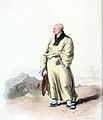 Portrait of a lama or a bonze, drawing by William Alexander, draughtsman of the Macartney Embassy to China in 1793.
Portrait of a lama or a bonze, drawing by William Alexander, draughtsman of the Macartney Embassy to China in 1793.
-
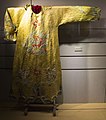 Dragon robe, Taiping Heavenly Kingdom.
Dragon robe, Taiping Heavenly Kingdom.
The Qing dynasty court continued to reform and regulate the clothing of its subjects, but discussion on ethnic clothing was a sensitive topic even after the Qing dynasty had consolidated its rule. By 1759 AD, the Qianlong Emperor (r. 1736-1795 AD) commissioned the Illustrated Precedents for the Ritual Paraphernalia of the Imperial Court (Huangchao Liqi Tushi) which was published and enforced by 1766; this publication covered several aspects including the dressing and accessories of the emperors, princes, noblemen and their consorts, Manchu officials, their wives and daughters, and the dress codes for Han Chinese men officials who had reached the rank of mandarin and were employed and their wives; as well as Han Chinese men who were waiting for an official appointment. The aim of this edict was made to preserve the Manchu identity once again, but at the same time, it also attempted to align the image of the emperor with Confucian ideas and codes of behaviours and manners. The dress code designed in the Huangchao Liqi Tushi continued to be used as the standard for the court attire until the end of the Qing dynasty. The Manchu continued to use the five colours symbolism in their clothings which was in line with the previous Han Chinese dynasties; however, they chose the colour blue as their dynasty colour and generally avoided the use of red colour in their clothing because red was the dynasty colour of Ming dynasty. On the other hand, Han Chinese continued to view red as a lucky colour because of its connection with rulers of Ming dynasty, and used it extensively in celebratory events and at weddings.
It was mistakenly thought that the hunting ancestors of the Manchus skin clothes became Qing dynasty clothing, due to the contrast between Ming dynasty clothes unshaped cloth's straight length contrasting to the odd-shaped pieces of Qing dynasty longpao and chaofu. Scholars from the west wrongly thought they were purely Manchu as the early Manchu rulers wrote several edicts stressing on maintaining their traditions and clothing. The Manchu imposed some nomadic features on the Ming dynasty robes to form their court costume.
The Manchu clothes were modified Han Chinese clothing from Ming China, the Manchus originally did not have their own cloth or textiles and they had to obtain Ming dragon robes (longpao), Chaofu and cloth when they paid tribute to the Ming or traded with the Ming. These Ming robes were modified, cut and tailored to be narrow at the sleeves and waist with slits in the skirt to make it suitable for falconry, horse riding and archery. The Ming dragon robes were simply modified and changed by Manchus by cutting it at the sleeves and waist to make them narrow around the arms and waist instead of wide and added a new narrow cuff to the sleeves. The new cuff was made out of fur. The robe's jacket waist had a new strip of scrap cloth put on the waist while the waist was made snug by pleating the top of the skirt on the robe. The Manchus added sable fur skirts, cuffs and collars to Ming dragon robes and trimming sable fur all over them before wearing them. However, some denied that the popular Manchu jackets in the Qing Dynasty originated from the Han Chinese clothing in the Ming Dynasty.
-
 Kangxi Emperor in casual dress.
Kangxi Emperor in casual dress.
-
 A military attire of the Qianlong Emperor.
A military attire of the Qianlong Emperor.
-
 Qianlong Emperor in Qing court dress.
Qianlong Emperor in Qing court dress.
-
 Qing dynasty Empress Robe, reign of Yongzheng Emperor.
Qing dynasty Empress Robe, reign of Yongzheng Emperor.
Han Chinese court costume (chaofu) was modified by Manchus by adding a ceremonial big collar (da-ling) or shawl collar (pijian-ling); the clothing was also reduced in bulk, the sleeves made narrower, and the side-fastening changed from cross-collared to a curved overlapping right front. The clothing was fastened with loops and buttons which was also adopted from nomadic practice. The Manchu also decorated their early Qing robes with dragons similarly to the Ming chaofu. Chaofu robes from Ming dynasty tombs, like the Wanli emperor's tomb, were excavated in the past decades, and it was found that Qing dynasty chaofu was similar and derived from it. They had embroidered or woven dragon-like creature on them but are different from longpao dragon robes which are a separate clothing. Flaired skirt with right side fastenings and fitted bodices dragon robes have been found in Beijing, Shanxi, Jiangxi, Jiangsu and Shandong tombs of Ming officials and Ming imperial family members. Integral upper sleeves of Ming chaofu had two pieces of cloth attached on Qing chaofu just like earlier Ming chaofu that had sleeve extensions with another piece of cloth attached to the bodice's integral upper sleeve. Another type of separate Qing clothing, the longpao resembles Yuan dynasty clothing like robes found in the Shandong tomb of Li Youan during the Yuan dynasty.
The Qing dynasty chaofu appear in official formal portraits while Ming dynasty chaofu that they derive from do not, perhaps indicating the Ming officials and imperial family wore chaofu under their formal robes since they appear in Ming tombs but not portraits. Qing longpao were similar unofficial clothing during the Qing dynasty. The Yuan dynasty robes had hems flared and around the arms and torso they were tight. Qing unofficial clothes, longpao, derived from Yuan dynasty clothing while Qing dynasty official clothing, chaofu, derived from unofficial Ming dynasty clothing, dragon robes. The Ming dynasty consciously modelled their clothing after that of earlier Han Chinese dynasties like the Song dynasty, Tang dynasty and Han dynasty. In Japan's Nara city, the Todaiji temple's Shosoin repository has 30 short coats (hanpi) from Tang dynasty. Ming dragon robes derive from these Tang dynasty hanpi in construction. The hanpi skirt and bodice are made of different cloth with different patterns on them and this is where the Qing chaofu originated. Cross-over closures are present in both the hanpi and Ming garments. The eighth century Shosoin hanpi's variety show it was in vogue at the tine and most likely derived from much more ancient clothing. Han dynasty and Jin dynasty (266–420) era tombs in Yingban, to the Tianshan mountains south in Xinjiang have clothes resembling the Qing dynasty longpao and Tang dynasty hanpi. The evidence from excavated tombs indicates that China had a long tradition of garments that led to the Qing chaofu, and it was not invented or introduced by Manchus in the Qing dynasty or Mongols in the Yuan dynasty. The Ming robes that the Qing chaofu derived from were just not used in portraits and official paintings but were deemed as high status to be buried in tombs. In some cases, the Qing dynasty went further than the Ming dynasty in imitating ancient China to display legitimacy with resurrecting ancient Chinese rituals to claim the Mandate of Heaven after studying Chinese classics. Qing sacrificial ritual vessels deliberately resemble ancient Chinese ones even more than Ming vessels. Tungusic people on the Amur river like Udeghe, Ulchi and Nanai adopted Chinese influences in their religion and clothing with Chinese dragons on ceremonial robes, scroll and spiral bird and monster mask designs, Chinese New Year, using silk and cotton, iron cooking pots, and heated house from China during the Ming dynasty.
The Spencer Museum of Art has six longpao robes that belonged to Han Chinese nobility of the Qing dynasty (Chinese nobility) which shows the diversity of the late 18th and 19th century non-imperial dragon robes. Ranked officials and Han Chinese nobles had two slits in the skirts while Manchu nobles and the Imperial family had 4 slits in skirts. All first, second and third rank officials as well as Han Chinese and Manchu nobles were entitled to wear 9 dragons by the Qing Illustrated Precedents. Qing sumptuary laws only allowed four clawed dragons for officials, Han Chinese nobles and Manchu nobles while the Qing Imperial family, emperor and princes up to the second degree and their female family members were entitled to wear five clawed dragons. However officials violated these laws all the time and wore 5 clawed dragons and the Spencer Museum's 6 long pao worn by Han Chinese nobles have 5 clawed dragons on them. Wives of Han Chinese noblemen and high-ranking officials had to wear semi-official formal dresses on ceremonial events; their clothing consisted of a mang ao (a four-clawed dragon loose fitting jacket with wide sleeves), a xia pei (a type of stole), a mang chu (a dragon skirt which was embroidered with dragons and phoenixes on the front and back skirt panels), a jiao dai (a rigid hooped belt which was worn around the jacket) and a phoenix coronet. The women mang ao was red in colour if the wearer was a man's principle wife; it was originally undecorated but started to be decorated with dragon by the 18th century. The xia pei was developed from the xia pei worn in Ming dynasty; the xia pei in Qing was first worn when the wedding day of a woman, after the wedding, she would wear it for special important events which were connected with her husband's status.
-
 Qing Dynasty Lady in a red robe, with a xia pei on top of her robe, and a coronet.
Qing Dynasty Lady in a red robe, with a xia pei on top of her robe, and a coronet.
-
 Han Chinese general Zhang Zhiyuan wearing Qing military outfit.
Han Chinese general Zhang Zhiyuan wearing Qing military outfit.
-
 Xia pei worn in Qing dynasty
Xia pei worn in Qing dynasty
During the Qianlong reign, a man named Liu Zhenyu was executed for urging the return of presumably Ming dynasty clothing. However during this period, Manchu style clothing was only required for scholar-official elite, such as the Eight Banners members and Han men serving as government officials, but not the entire male population. Therefore, Han Chinese men were allowed to continue to dress in Ming dynasty clothing. But as time passed, Han civilian men also voluntarily adopted Manchu clothing like Changshan and the magua (horse jacket) on their own free will. In the beginning of the Mid-Qing period, the discourses and resistance against the Manchu clothing regulations gradually disappeared. By the late Qing dynasty, not only officials and scholars, but a great many commoners as well, started to wear Manchu attire.
For women's clothing, Manchu and Han fashions of clothing coexisted. The Han Chinese women carefully maintained their pure Han Chinese ethnicity and did not wear Manchu clothing. Throughout the Qing dynasty, Han women continued to wear clothing from Ming dynasty; however, with time, the Ming dynasty customs started to be forgotten and influence from the Manchu started to influence the women's clothing. However, Manchu women and Han Chinese women never emulated each other's clothing; and as a result, by the end of the nineteenth century, Manchu and Han Chinese women had maintained distinctive clothing.
At the beginning of the Qing dynasty, Han Chinese women were expected to continue the Han Chinese clothing of the Ming dynasty. Manchu women wore a long, one-piece robe with a curving robe where as Han Chinese women continued to wear the combination upper and lower garment. As Han Chinese women were not forced to change in to Manchu clothing, most of the clothing elements of the Han Chinese women in the Qing dynasty continued to follow the style of the Ming dynasty coat (袄; ao). Following the Ming dynasty customs, Han Chinese women would wear a jacket as an upper garment with lower garments. A popular fashion in the Qing dynasty was the aoqun (袄裙). Han Chinese women would wear skirts; trousers were sometimes worn under the skirts if they were commoners or unmarried. Han Chinese women who were unmarried or were peasant would wear trousers with jacket, without any overskirt. Wearing skirts were generally considered a symbol of maturity and was reserved for married women.
In the middle of the Qing dynasty, Manchu and Han Chinese women started to influence each other's clothing; however, they still maintain the uniqueness of their respective clothing styles. The late Qing dynasty, Han Chinese women in the gentry and aristocratic classes started to imitate the clothing of the Manchu; similarly, the Manchu women started to imitate the clothing of the Han Chinese women; and thus, they influenced each other. In the late Qing dynasty, Han Chinese traditional coats (袄; ao) continued to share some similarities with the coat (袄; ao) worn in the Ming dynasty. However, the clothing worn by the Han Chinese women was also influenced by Manchu culture to some degree; for example, in terms of clothing colour, embroidery and binding. The late Qing dynasty ao had large sleeves, a slant opening (instead of cross-collared, there was a curved front opening) and was waist-length. Elderly Chinese women wore an ao with round standing collar, which had a planket by the right, flat sleeves, sleeves which were wrist-length and had a wide cuff. The collar of the Han Chinese ao may be standing collar or low collar stand, and there were slits on both sides of the ao. The waist-length ao could also have narrow sleeves and a front opening. Women clothing in the late Qing dynasty also had piped edges.
The silk skirts which are indigenous to Han Chinese women is a representative garment of the Qing dynasty clothing. A popular form of skirts during the Qing dynasty is a skirt which is made of two separate pieces of fabric which are not sewn together from the waistline to the hemline; this skirt allowed Han Chinese women with bounded feet to walk with greater ease. The two pieces were overlapped and sewn to a waistband which was wider compared to the two-pieces skirts worn in the preceding dynasties (Song, Yuan, and Ming dynasties). Those overlapping skirts worn during the Qing dynasty by Han Chinese women are called mamianqun (馬面裙; horse-face skirt); and they were sometimes referred as paired aprons or aprons in some literature, despite they were not aprons as defined in the dictionary. Those overlapping skirts had very subtle changes in both the cut and decorations throughout the Qing dynasty. Other Han Chinese women skirts which were popular in the Qing dynasty are baijianqun (百襇裙; hundred pleated skirt), yuehuaqun (月華裙; moonlight skirt), and the ‘fish-scale’ skirt. The yuehuaqun was popular in the early Qing dynasty. During the reign of Kangxi and Qianlong, the phoenix tail skirt was popular. At the end of the Qing dynasty, a skirt decorated with sword-shaped ribbons with bells hanging at the sharp corner appear. Han Chinese women also wore dudou, which was developed from the Ming dynasty dudou.
-
 On the left, a Han Chinese woman wearing Han Chinese clothing composed of an ao and a skirt; on the right, a Manchu woman wearing a one-piece long robe, which is the precursor of the qipao.
On the left, a Han Chinese woman wearing Han Chinese clothing composed of an ao and a skirt; on the right, a Manchu woman wearing a one-piece long robe, which is the precursor of the qipao.
- Qing dynasty hanfu for women. Qing dynasty hanfu for women.
-
 Qing dynasty aoqun worn in theatre for female role, 18th century.
Qing dynasty aoqun worn in theatre for female role, 18th century.
-
 A woman dressed in an ao and a trousers, she is playing a small drum, from 1800.
A woman dressed in an ao and a trousers, she is playing a small drum, from 1800.
-
 A woman wearing an ao with a long skirt, Playing a zheng, from 1800.
A woman wearing an ao with a long skirt, Playing a zheng, from 1800.
-
 A woman wearing an ao and trousers under an overskirt, she is playing a wind instrument with a curved bell, from 1800.
A woman wearing an ao and trousers under an overskirt, she is playing a wind instrument with a curved bell, from 1800.
-
Han Chinese embroidered silk lady's jacket and pleated skirt, c. 1900.
-
 The clothing of Han women during the 19th century. The top ao from Ming dynasty was changed into a variation of the Manchu qizhuang, while skirt, which inherited the Ming style, was also influenced by Qing-style patterns.
The clothing of Han women during the 19th century. The top ao from Ming dynasty was changed into a variation of the Manchu qizhuang, while skirt, which inherited the Ming style, was also influenced by Qing-style patterns.
-
 Qing Dynasty pleated skirt; late 19th century
Qing Dynasty pleated skirt; late 19th century
-
 Woman's two panels skirt, Qing dynasty (1644-1912), Late 19th Century-Early 20th Century.
Woman's two panels skirt, Qing dynasty (1644-1912), Late 19th Century-Early 20th Century.
Han Chinese children were spared from the tifa yifu policy and could be dressed in Han Chinese clothing, and their clothing was fastened to the right side in the Ming dynasty-style. Their daily clothing was made of silk, and they would wear satin and silk clothing for special occasions; the colours of the clothing were brights and the clothing were typically red and pink as these were auspicious colours. Infants would wear dudou, which was embroidered with luck charms, as their only clothing in hot summer months until they reach the age of two to three years old. They also wore a “hundred families jacket", a form of Chinese patchwork jacket, it was worn by children in the Qing dynasty to wish a child good fortune and as an evil protection. The "hundred families jacket" is a form of jacket, which was also depicted in Song dynasty painting. They also wore different style of hats, such as the "rice bowl hat", the "tiger head hat", the "dog head hat", which aim to protect against evil spirit and later on to attract good fortunes when they have to take important examinations.
- A Qing dynasty Han chinese child's hanfu, Ming-style upper garment with a pair of trousers. A Qing dynasty Han chinese child's hanfu, Ming-style upper garment with a pair of trousers.
- Children hanfu in Qing dynasty, upper garment. Children hanfu in Qing dynasty, upper garment.
- Children hanfu in Qing dynasty, upper garment. Children hanfu in Qing dynasty, upper garment.
- A Qing dynasty-style “hundred families jacket", a form of Chinese patchwork jacket, worn by children. A Qing dynasty-style “hundred families jacket", a form of Chinese patchwork jacket, worn by children.
During the late Qing dynasty, the Vietnamese envoy to Qing China were still wearing the official attire in Ming dynasty style. Some of the locals recognized their clothing, yet the envoy received both amusement and ridicule from those who did not.
In the late Qing dynasty, some members of the White Lotus sect cut down their queues in an act of defiance while most of them only remove a hair strand or unbraided their hair and let it loose.
Outside China in 1911, the magazine Vogue recommended shopping for a set of attire called "boudoir set" which consisted of the Qing dynasty aoqun with wide hems and wide sleeves, and shoes. However, by the Xinhai revolution in 1911, the wide hemmed and wide sleeved Qing dynasty aoqun was no more popular among urban Han Chinese women in China; instead they started to make their clothing narrower. Ready-to-wear Western clothing had little popularity among Chinese consumers as due to proportion misfit of Western clothing. After the Qing dynasty was toppled in the 1911 Xinhai revolution, the Taoist dress and topknot was adopted by the ordinary gentry and "Society for Restoring Ancient Ways" (Fuguhui) on the Sichuan and Hubei border where the White Lotus and Gelaohui operated. It was only later westernized revolutionaries, influenced by western hairstyle, who began to view the braid as backward and advocated adopting short haired western hairstyles.
Modern
20st Century
In 1912, the republic was established and government ministers were required to western-style clothing. Official attire for both men and women were regulated and published in the government gazettes; the men had to wear western-style clothing on formal days and evening, and in informal time, they could Western suit or changshan magua. Women had to wear Qing style jacket and skirt. Women started to wear more western-style cloting, Foot binding was legally abolished.
In 1914 AD during the early years of the republic, cutting off the queue was a pre-requisite for provincial election votes, and in the 1914, policemen cut off the queue of any anyone arrested wearing queues.
After the fall of the Qing dynasty, Yuan Shikai revived the Sacrifice at the Temple of Heaven ceremony and proclaimed himself Emperor Hongxian and the beginning of a new dynasty; the robe and hat which specially designed for him to wear on the day of this ceremony was based on the ceremonial dress worn by the Han and Ming dynasty emperors on sacrificial ceremonies. However, Yuan Shikai did not adhere to the Han dynasty and Ming dynasty fashion completely and these gowns showed differences in design, i.e. the use of roundels. A manual, called the Jisi guanfutu (祭祀冠服圖; The Illustrated Manual of Dress for Ritual Sacrifices), was specially prepared and produced in 1914 AD by the Zhengshitang lizhiguan (政事堂禮制館; Bureau of Rites of the Executive Affairs department); this manual provided a detailed description of the attire worn by Yuan Shikai and the participants of the ceremony on this 1914 public, ceremonial event. Yuan Shikai's ceremonial gown was jiaoling youren (i.e. fastened over the right side), made of black satin which was bordered with gold brocade and was decorated with twelve roundels which depicted the full twelve Imperial symbols (shier zhang; 十二章). Officials gowns were also designed for officials who had to participate in the ceremony; the officials gown were made of black satin and the edges were made with blue brocade. Laws regarding the official dress were also decreed: (1) First-rank officials had to wear nine roundels with nine symbols on their gowns; (2) second-rank officials had to wear seven roundels with seven symbols; (3) Third-rank officials had to wear five roundels with five symbols; (4) fourth-rank officials had to wear three roundels with three symbols; and (5) fifth-rank officials and below had to wear a robe without any borders and without any roundels. Those imperial emblems which were used in the roundels originated from the twelve emblems which were documented in the Shangshu. This ceremonial gown was worn over a purple satin apron skirt which would be edged with either blue or gold brocade; a belt of matching colour was also worn around the waist. They also wore flat hats, and some of them had string of pearls which hung over their faces just like the hats which were worn by the Han Chinese emperors of the earlier dynasties. Yuan Shikai's deliberate way of dressing up to pay respect to Heaven was not only made in accordance to the old imperial traditions, but it can also be considered as a public declaration to the Chinese people and to the world that the old Chinese customs were still relevant in modern society. When Yuan Shikai died in 1916, he was buried in imperial gown which was decorated with nine golden dragons. However, since his reign was short-lived, the attempts at restoring ancient Chinese ceremonial and official gowns failed and gradually disappeared.
-
 Picture of Emperor Yuan Shikai.
Picture of Emperor Yuan Shikai.
-
 Third-rank Official at Yuan Shikai's visit to the sacrificial ceremony at the Temple of Heaven; he is wearing a robe with five roundels.
Third-rank Official at Yuan Shikai's visit to the sacrificial ceremony at the Temple of Heaven; he is wearing a robe with five roundels.
-
 Official wearing sacrificial clothing.
Official wearing sacrificial clothing.
-
 Part of the participants of the 17th Confucius Conference wear Hanfu, 1910s.
Part of the participants of the 17th Confucius Conference wear Hanfu, 1910s.
-
 Sai Jinhua wearing a jiaoling youren clothing, 1920s.
Sai Jinhua wearing a jiaoling youren clothing, 1920s.
-
 Eminence Taixu, a buddhist monk, wearing a youren gown in the streets of London, 1929.
Eminence Taixu, a buddhist monk, wearing a youren gown in the streets of London, 1929.
-
 Graduate of Yenching University, 1930.
Graduate of Yenching University, 1930.
In 1919, women aoqun evolved; the ao became slimmer and longer until it reached below the narrow; the sleeves became narrower to the wrists, and the side slits were shortened; the collars became very high with some corners turning down sometimes and other collars reaching up to the ears. The edges of the ao became narrow contrasting to the wide bands of embroidery which was popular in the past. The ao was worn with a one-piece ankle length skirt.
In the early 1920s, the ao became more fitted and was shortened reaching only the top of the hip with a rounded hem, the sleeves were also shortened to three quarter of its length. The skirt became plainer, cut with a simple flared style, and wide waistband was replaced by narrow band in which a cord or elastic was threaded. The qipao, also known as cheongsam, was eventually created in the middle of 1920s.
In 1927, changshan and magua was established as the formal, official wear for men, and they were worn for important ceremonies, such as weddings, temple and ancestral halls worship. Women's formal wear was either a black ao and blue skirt with the same style as the earlier outfit or the cheongsam.
In the mid 1930's as men started to adopt more Western clothing. Under the Japanese occupations (1937-1945), more men started to wear even more Western suits and ties, and the men traditional clothing was worn on informal occasions.
During the Cultural Revolution (1966-1976), traditional Chinese clothing, as a broad term, was considered as being part of one of the "four olds" and the Mao suit was popularized for both genders. Skirts also disappeared as they were considered being both impractical for manual work and ideologically inappropriate during this time period. In 1974, Jiang Qing, the fourth wife of Mao Zedong, wanted to make an attire, known as the Jiang Qing dress, as the national dress for the Chinese women. The Jiang Qing dress, which she personally designed, consisted of pleated skirts instead of trousers, the sleeves were nearly elbow-length, there was a central opening, and the neckline was V-shaped and was delineated by a wide, white band; the skirt was based on the pleated skirts (i.e. the "one hundred pleats" skirt) worn by the court ladies worn in Tang dynasty paintings. The earliest form of Jiang Qing dress is documented and appear in the 1974 Asian Games photos. Jiang Qing tried to popularize the dress in diverse ways through public and foreign avenues; however, her dress failed to win popularity and was disliked.
Since the late 1970's, skirts and dresses reappeared and western-style clothing became popular in daily lives.
Hanfu in popular media and opera
Hanfu continue to be depicted frequently as Chinese costumes in Chinese and foreign television series, films and other forms of entertainment media, and was widely popularized since the late 1980s dramas. However, these Television drama costumes are often inaccurate and do not conform to historical facts. One example of historically inaccurate hanfu is the costume worn by Disney's Mulan, where the wide sleeves of the hanfu was reduced to narrow sleeves reflecting modern fashion and to reflect the character of Disney's Mulan.
-
 A Movie poster of Romance of the Western Chamber, a 1927 silent movie.
A Movie poster of Romance of the Western Chamber, a 1927 silent movie.
-
 A scene from the silent film, The Cave of the Silken Web aka Pan Si Dong (1927). Various forms of hanfu-style costumes are depicted in the movie.
A scene from the silent film, The Cave of the Silken Web aka Pan Si Dong (1927). Various forms of hanfu-style costumes are depicted in the movie.
-
 Disney's Mulan (1998) wearing inaccurate hanfu.
Disney's Mulan (1998) wearing inaccurate hanfu.
-
 Costumes from the Chinese drama Nirvana in Fire (2015) are based on historical Hanfu clothing system of the Wei, Jin, Northern and Southern dynasties.
Costumes from the Chinese drama Nirvana in Fire (2015) are based on historical Hanfu clothing system of the Wei, Jin, Northern and Southern dynasties.
Many elements and costumes styles worn in Chinese opera are derived from the Ming dynasty clothing and may be blended with the clothing style from the Tang to Qing dynasty. The opera costumes worn in Kunqu opera is primarily based on the clothing worn in Ming dynasty. And, most of the style of costumes depicted in Cantonese opera are also derived from the clothing of the Ming dynasty, with a few exception being derived from the Qing dynasty clothing. Costumes of Cantonese opera uses the Ming-style clothing for opera which are set in all dynasties, except for the ones set in the Qing dynasty; those costumes follow the Qing-style.
- Yam Kim-fai (1913-1989), a Catonese opera actress, wearing a youren gown. Yam Kim-fai (1913-1989), a Catonese opera actress, wearing a youren gown.
-
 Hanfu in a Kunqu performance.
Hanfu in a Kunqu performance.
-
 Cantonese Opera Happy Valley (2008).
Cantonese Opera Happy Valley (2008).
-
 Kunqu opera of the Ming-dynasty play The Peony Pavilion.
Kunqu opera of the Ming-dynasty play The Peony Pavilion.
Hanfu and modern taoism
Some modern times taoist monks and taoism practitioners continue to style their long hair into a touji (頭髻; a topknot hairstyle) and wear traditional clothing. Some modern taoist abbess and priests also wear cross-collared jiaoling youren (交領右衽) robes and hats.
-
 A Taoist soothsayer advising a woman; he has a topknot hairstyle, a surviving male hairstyle of Han people. Photo taken in 2008 outside the Changchun Temple (長春觀) in Wuhan, China.
A Taoist soothsayer advising a woman; he has a topknot hairstyle, a surviving male hairstyle of Han people. Photo taken in 2008 outside the Changchun Temple (長春觀) in Wuhan, China.
-
 A Taoist monk; he has a topknot hairstyle and wears a tangzhuang-style upper garment. The upper garment is not considered as being hanfu; Beijing, date unknown.
A Taoist monk; he has a topknot hairstyle and wears a tangzhuang-style upper garment. The upper garment is not considered as being hanfu; Beijing, date unknown.
21st Century: Modern Hanfu
In the 21st century, a fashion and social movement named Hanfu movement seeks the revival of ancient Han Chinese clothing. On 22 November 2003, a man named Wang Letian wore a DIY shenyi in public; his hanfu story was published in Lianhe Zaobao newspaper and attracted the public attention causing controversies; this is considered as the beginning of the hanfu movement. Some elements of the hanfu movement take inspiration from the use of indigenous clothing by ethnic minorities in China, as well as the usage of kimono in Japan and traditional clothing used in India.
The hanfu which arises in the 21st century is sometimes described as modern hanfu, restored hanfu or new hanfu. Some contemporary authors also tried to separate the types of hanfu into two categories: (1) ancient hanfu, which are the hanfu worn prior to the early Qing dynasty, and (2) contemporary hanfu, which is the clothing worn since the beginning of the Hanfu movement dated 2003. However, the 21st century hanfu is still referred as hanfu within the Hanfu cultural community for ease of expression.
The modern hanfu takes inspiration from the looks of the pre-Qing dynasty clothing; however, it can hardly be perceived as a static tradition. The modern hanfu combine both the characteristics of the ancient hanfu (e.g. it follows the traditional two-dimensions cut instead of three-dimension cut) and also combines the aesthetics standards and technologies of modern society in terms of style, clothing colour, clothing construction, and materials. The modern hanfu is also not restricted by the use of colours and decoration design regulations; e.g. the modern hanfu allows the use of dragons and the colour yellow which had been forbidden in the ancient dynasties. Some people even mix-match various hanfu clothing from different dynasties.
The modern hanfu also changes to a style that can be worn daily, and these styles combined with western clothing or even clothing from other cultures. For example, the recent emergence of Christmas-theme hanfu trend (which occurred especially for Christmas season) on social media and online shops combines hanfu with Christmas elements and Christmas colour hues. Another trend is the incorporation of (western-style) lace elements to the hanfu; however, those designs are not considered as authentic hanfu but are considered being clothing with Han elements. Some modern hanfu design is influenced by the kawaii culture and is a targeted choice for young women who seek a cute appearance; some of these kawaii-style modern hanfu also uses knee-length skirt.
Around the year 2007 or 2008, a group of young people from Minghang district, Shanghai, started a project to restore Chinese clothing from ancient dynasties based on rigorous research, spending their days reading ancient documents and looking at paintings to find detailed information about the styles, materials, colours and patterns used in ancient times; this group is called the Ancient Chinese Clothing Restoration Team.
On March 8 2021, the magazine Vogue published an article on modern hanfu defining it as a "type of dress from any era when Han Chinese ruled" and reported that the styles based on the Tang, Song, Ming periods were the most popular.
Most modern hanfu are based on sculptures, paintings, art objects, historical records, and historical clothing. Ming dynasty Han Chinese robes given by the Ming Emperors to the Chinese noble Dukes Yansheng descended from Confucius are still preserved in the Confucius Mansion after over five centuries. Robes from the Qing emperors are also preserved there. The Jurchens in the Jin dynasty and Mongols in the Yuan dynasty continued to patronize and support the Confucian Duke Yansheng.
However, some forms of modern hanfu like the Qixiong ruqun is controversial due to the rarity of unearthed historical clothing. The modern Qixiong ruqun which is found on the current market comes into two forms: (1) one-piece style, and (2) two-piece style with a slit under the waist. The former is well accepted as being an authentic shape as such form of skirt was unearthed in archeological findings; thus proving the correctness of the one-piece style Qixiong ruqun whereas the latter is controversial as it is a style which (so far) can only be found in ancient paintings, such as the Tang dynasty "A palace concert" painting. Due to the lack of historical clothing back-up, the designer of the two-piece style Qixiong ruqun based himself on the Japanese Hakama as a reference object.
Another style of controversial modern hanfu is the xiao quju (小曲裾), which is shorter version of the qujupao.
The "Wei and Jin dynasty style" (魏晋风; weijinfeng) hanfu is a highly controversial form of hanfu which historically only exist in modern times; it was made during the early stage of the Hanfu movement and its design was influenced by Chinese movies and TV dramas which emerged in the 20th century. The "Wei and Jin dynasty style" hanfu is different from the ancient hanfu worn in the Wei and Jin dynasties.
-
 Two hanfu promoters, the woman wears what appears to be qujupao while the man wears a zhiqupao; Chinese cultural Festival in Guangzhou, 2008.
Two hanfu promoters, the woman wears what appears to be qujupao while the man wears a zhiqupao; Chinese cultural Festival in Guangzhou, 2008.
- A woman wearing ruqun and beizi, 2013. A woman wearing ruqun and beizi, 2013.
- A girl wearing a waist-length, squared-collared bijia over a skirt and upper garment with a youren opening, 2013. A girl wearing a waist-length, squared-collared bijia over a skirt and upper garment with a youren opening, 2013.
- A lady wearing aoqun, 2013. A lady wearing aoqun, 2013.
- Modern Ming dynasty Chang ao worn with skirt, 2020. Modern Ming dynasty Chang ao worn with skirt, 2020.
- A man wearing a zhiduo and a lady wearing aoqun with beizi, 2013. A man wearing a zhiduo and a lady wearing aoqun with beizi, 2013.
-
 Two men dressed in hanfu, (possibly) 2009 or earlier.
Two men dressed in hanfu, (possibly) 2009 or earlier.
-
 Men wearing shenyi, panling lanshan, and zhiduo, date unknown.
Men wearing shenyi, panling lanshan, and zhiduo, date unknown.
-
 Men and women in xuanduan (玄端), possibly a Guan Li ceremony, 2007.
Men and women in xuanduan (玄端), possibly a Guan Li ceremony, 2007.
-
 People wearing hanfu at IDO32 shows the diversity of hanfu, 2020.
People wearing hanfu at IDO32 shows the diversity of hanfu, 2020.
-
 A lady wearing a red and black qixiong ruqun, followed by a lady in orange chang ao, white qun (skirt) and yellow bijia, followed by a lady (possibly) in white ruqun under a white beizi, at IDO32, 2020
A lady wearing a red and black qixiong ruqun, followed by a lady in orange chang ao, white qun (skirt) and yellow bijia, followed by a lady (possibly) in white ruqun under a white beizi, at IDO32, 2020
-
 Women wearing various styles of Ming dynasty aoqun at IDO32, 2020.
Women wearing various styles of Ming dynasty aoqun at IDO32, 2020.
-
 Two ruqun in a clothing store; one the left is a hanfu with a red ru with a white skirt; on the right, the hanfu is composed of a green ru and a green skirt; 2018.
Two ruqun in a clothing store; one the left is a hanfu with a red ru with a white skirt; on the right, the hanfu is composed of a green ru and a green skirt; 2018.
Garments
The style of historical Han clothing can be summarized as containing garment elements that are arranged in distinctive and sometimes specific ways. A complete set of garment is assembled from several pieces of clothing into an attire:
| Component | Romanization | Hanzi | Definition |
|---|---|---|---|
| Upper Garment | Yi | 衣 | Open cross-collar shirt. |
| Ru | 襦 | Open cross-collar shirt, only worn by women. | |
| Lower Garment | Ku | 裤 | Trousers or pants. |
| Chang | 裳 | Skirt for men. | |
| Qun | 裙 | Skirt for women. | |
| Full-body Cloth | Pao | 袍 | Closed full-body garment. |
| Chang ru | 长襦 | Long skirt, only worn by women. | |
| Outer Garment | Ao | 袄 | Multi-layer open cross-collar shirt or jacket. |
| Shan | 衫 | Single-layer open cross-collar shirt or jacket. | |
| Banbi | 半臂 | A half-sleeved waistcoat. | |
| Bixi | 蔽膝 | A cloth attached from the waist, covering front of legs. | |
| Dou Peng | 斗篷 | Cape. | |
| Pi feng | 披风 | Cloak. | |
| Pibo | 披帛 | A long silk scarf, however not used to cover neck. Sometimes covering shoulders, other times just hanging from elbow. | |
| Zhao shan | 罩衫 | Cloaking coat. Usually open at the front. | |
| Inner Garment | Du dou | 肚兜 | Belly Cover. Covers front upper body. Worn by women and children. |
| Mo xiong | 抹胸 | Tube top. Worn by women. | |
| Zhongyi | 中衣 | Inner garments, mostly white cotton or silk. Also called zhongdan (中单). |
There is differences between traditional garment of Han ethnic and other ethnic groups in China, most notably the Manchu-influenced clothes, qipao, which is popularly considered to be the de facto traditional Han Chinese garb. A comparison of the two styles can be seen as the following provides:
| Component | Han | Manchu |
|---|---|---|
| Collars | Crossing diagonally. Loose lapels, front opened. | Parallel vertical overlapping collars, with paralleled secured lapels, no front openings. |
| Sleeves | Long and loose | Narrow and tight |
| Buttons | Sparingly used and concealed inside the garment | Numerous and prominently displayed |
| Fittings | Belts and sashes are used to close, secure, and fit the garments around the waist | Flat ornate buttoning systems are typically used to secure the collar and fit the garment around the neck and upper torso |
Style

Han Chinese clothing had changed and evolved with the fashion of the days since its commonly assumed beginnings in the Shang dynasty. Many of the earlier designs are more gender-neutral and simpler in cut than later examples. Later garments incorporate multiple pieces with men commonly wearing pants and women commonly wearing skirts. Clothing for women usually accentuates the body's natural curves through wrapping of upper garment lapels or binding with sashes at the waist.
The upper garments of all hanfu that have collar crossing is wrapped over, in a style known as jiaoling youren (交領右衽), the left side covering the right side and extend to the wearer's right waist. The jiaoling youren collar follows the yin and yang theory, wherein the left lapel (which represents the yang which symbolizes life) suppresses the yin (which represents death); therefore, jiaoling youren is the clothing of the living people while if it is worn in the opposite way, then the clothing would become burial clothing and would be considered a taboo.
Informal wear

Types include tops and bottoms, long skirt, and one-piece robes that wrap around the body once or several times (shenyi).
Zhongyi (中衣), which is usually the inner garment much like a Western T-shirt and pants, can be wear along in casual.
The typical set of informal wear consists of two or three layers. The first layer is mostly zhongyi (中衣). The next layer is the main layer which is mostly closed at the front. There can be an optional third layer which is often an overcoat called a zhaoshan which is open at the front.
For footwear, white socks and black cloth shoes (with white soles) are the norm. But in the past, shoes may have a front face panel attached to the tip of the shoes. Daoists, Buddhists and Confucians may have white stripe chevrons.
- Fusha (彿裟): Buddhist priests' full dress ceremonial robes. Also called Hai Qing (海青).
| Romanization | Hanzi | Definition | Period | Images | ||||
|---|---|---|---|---|---|---|---|---|
| Zhiju | 直裾 | Straight lapelled full body garment. | Pre-Qin - Han |  |
 |
File:Han zhiju.jpg | 
|

|
| Quju | 曲裾 | Diagonal body wrapped full body garment. | Pre-Qin - Han | File:Han dynasty wooden figurines 2.jpg |  |

|
||
| Kuzhe | 裤褶 | Pre-Qin - Ming | A short coat with trousers. | File:China's Northern Dynasties' pottery figurine.jpg |  |

|
||
| Ruqun | 襦裙 | A top garment covered by a separate skirt | Pre-Qin - Ming |  |
 |

|

|
|
| Aoqun/ Shanqun |
袄裙/ 衫裙 |
A short coat with a long skirt underneath. | Han - Ming |  |
 |

|
File:孔府藏襖裙.jpg | 
|
| Zhiduo | 直裰 | Straight robe. Similar to zhiju but with vents at sides and cuffed sleeves. | Tang - Ming |  |
 |

|

|
|
| Daopao | 道袍 | Taoist robe. Worn by Taoist priests and normal scholars. | Song - Ming |  |
 |

|

|

|
Semi-formal wear
Generally, this form of wear is suitable for meeting guests or going to meetings and other special cultural days. This form of dress is often worn by the nobility or the upper-class as they are often expensive pieces of clothing, usually made of silks and damasks. The coat sleeves are often deeper than the shenyi to create a more voluminous appearance.
A piece of ancient Chinese clothing can be "made semi-formal" by the addition of the following appropriate items:
- Chang (裳): a pleated skirt
- Bixi (蔽膝): a cloth attached from the waist, covering front of legs.
- Zhaoshan (罩衫): long open fronted coat
| Romanization | Hanzi | Definition | Period | Images | ||
|---|---|---|---|---|---|---|
| Banbi | 半臂 | A half-sleeved waistcoat. | Tang - Ming |  |
 |

|
| Bijia | 比甲 | An open-sided long vest. | Ming | 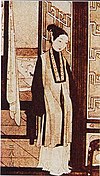 |
||
| Beizi | 褙子 | Large loose coat. | Song - Ming | 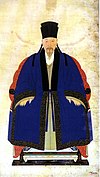 |
 |

|
Formal wear
In addition to informal and semi-formal wear, there is a form of dress that is worn only at confucian rituals, important sacrifices, religious activities or by special people who are entitled to wear them (such as officials and emperors).
The most formal dress civilians can wear is the xuanduan (sometimes called yuanduan 元端), which consists of a black or dark blue top garment that runs to the knees with long sleeve (often with white piping), a bottom red chang, a red bixi (which can have a motif and/or be edged in black), an optional white belt with two white streamers hanging from the side or slightly to the front called peishou (佩綬), and a long black guan. Additionally, wearers may carry a long jade gui (圭) or wooden hu (笏) tablet (used when greeting royalty). This form of dress is mostly used in sacrificial ceremonies such as Ji Tian (祭天) and Ji Zu (祭祖), etc., but is also appropriate for state occasions. The xuanduan is basically a simplified version of full court dress of the officials and the nobility.
Those in the religious orders wear a plain middle layer garment followed by a highly decorated cloak or coat. Taoists have a 'scarlet gown' (絳袍) which is made of a large cloak sewn at the hem to create very long deep sleeves used in very formal rituals. They are often scarlet or crimson in color with wide edging and embroidered with intricate symbols and motifs such as the eight trigrams and the yin and yang Taiji symbol. Buddhist have a cloak with gold lines on a scarlet background creating a brickwork pattern which is wrapped around over the left shoulder and secured at the right side of the body with cords. There may be further decorations, especially for high priests.
| Romanization | Hanzi | Definition | Period | Images | |||
|---|---|---|---|---|---|---|---|
| Xuanduan/ Yuanduan |
玄端/ 元端 |
literally, 'dark solemn'', a very formal dark robe. | Pre-Qin - Song | 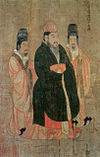 |
|||
| Shenyi | 深衣 | A long full body garment. | Song - Ming |  |
 |

|

|
| Yuanlingshan/ Panlingpao |
圓領衫/盤領袍 | Closed round-collared robe. Mostly used for official occation. | Sui - Ming | 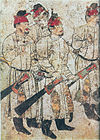 |
 |

|

|
| Lanshan | 襴衫 | Closed round-collared robe with black edges. Mostly used for academical dress. | Tang - Ming |  |
 |

|

|
| Daxiushan | 大袖衫 | Large Sleeve Gown. | Five dynasties - Tang |  |
 |

|
|
Court dress

Court dress is the dress worn at very formal occasions and ceremonies that are in the presence of a monarch (such as an enthronement ceremony). The entire ensemble of clothing can consist of many complex layers and look very elaborate. Court dress is similar to the xuanduan in components but have additional adornments and elaborate headwear. They are often brightly colored with vermillion and blue. There are various versions of court dress that are worn for certain occasions. The practical use of court dress is now obsolete in the modern age since there is no reigning monarch in China anymore.
Those in academia or officialdom have distinctive gowns (known as changfu 常服 in court dress terms). This varies over the ages but they are typically round collared gowns closed at the front. The most distinct feature is the headwear which has 'wings' attached. Only those who passed the civil examinations are entitled to wear them, but a variation of it can be worn by ordinary scholars and laymen and even for a groom at a wedding (but with no hat).
| Romanization | Hanzi | Definition | Period | Images | |||
|---|---|---|---|---|---|---|---|
| Longpao (龙袍) |
Jifu | 吉服 | The dragon robe for special occations. | Shang – Ming | 
|

|

|
| Changfu | 常服 | The dragon robe for daily wear. | Tang – Qing | 
|

|

| |
| Mianfu | 冕服 | Attire worn by emperors and crown princes. | Shang – Ming | 
|

|
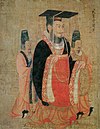
| |
| Tongtianguanfu | 通天冠服 | Tongtian, literally means 'direct links with heaven'. Ceremonial dress. | Shang – Ming | 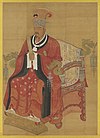
|
|||
| Bianfu | 弁服 | Occasional court dress. Also worn by officials or the nobility. | Shang – Ming | 
|
|||
| Romanization | Hanzi | Definition | Period | Images | ||
|---|---|---|---|---|---|---|
| Chaofu | 朝服 | A red ceremonial court dress of emperor, officials or nobility. | Zhou – Ming | 
|
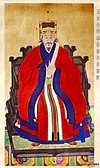
|

|
| Gongfu | 公服 | Formal court dress according to ranks. | Tang - Ming | 
|

|

|
| Changfu | 常服 | Everyday court dress. | Song – Qing | 
|

|

|
| Bufu | 补服 | Changfu sewn with Mandarin square. | Ming – Qing | 
|

|
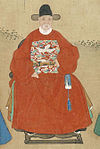
|
| Zhongjingfu | 忠静服 | Retired official's bufu with same colour long cloth belt. | Ming | 
|

|

|
| Cifu | 賜服 | Ceremonial court dress of the highest rank officials. The right to wear such dress was bestowed by emperors as a special honour. | Ming – Qing | 
|

|
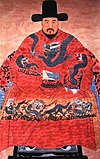
|
| Mangfu | 蟒服 | Also known as the "four-clawed dragon" robe or "python robe". It is a type of Cifu. | 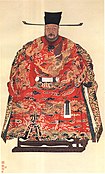
|
|||
| Feiyufu | 飞鱼服 | Also known as "flying fish" robe. It is a type of Cifu. | ||||
| Douniufu | 斗牛服 | Also known as "fighting bull" robe. It is a type of Cifu. | ||||
| Precedence | Rank | Robe Color | Animal on Patch (Civil) |
Animal on Patch (Military) |
Exemplified Positions (Not All-Inclusive) |
|---|---|---|---|---|---|
| 1st (Highest) |
First Rank Primary 正一品 |
Red-crowned crane | Lion | Emperor's Chief Advisor 太師 Regional Commander 都督 | |
| 2nd | First Rank Secondary 從一品 |
Emperor's Assistant 少傅 Regional Executive Officer 都督同知 | |||
| 3rd | Second Rank Primary 正二品 |
Golden pheasant | Lion | Crown Prince's Teaching Assistant太子少師 Secretary of Defense 兵部尚書 | |
| 4th | Second Rank Secondary 從二品 |
Governor 布政使 Provincial Deputy Commander 都指揮同知 | |||
| 5th | Third Rank Primary 正三品 |
Peacock | Tiger | Mayor of Beijing 順天府尹 Deputy Secretary of Labor 工部侍郎 | |
| 6th | Third Rank Secondary 從三品 |
Minister of the Imperial Stud 太僕寺卿 Minister of Salt Supply 都轉鹽運使 | |||
| 7th | Fourth Rank Primary 正四品 |
Wild goose | Leopard | (Eunuch Position) Handler of the Imperial Seal 掌印太監 Minister of Foreign Affairs 鴻臚寺卿 | |
| 8th | Fourth Rank Secondary 從四品 |
Principal of the Imperial Academy 國子監祭酒 Governor's Junior Assistant 參議 | |||
| 9th | Fifth Rank Primary 正五品 |
Silver pheasant | Bear | Principal of the Imperial Medical Academy 太醫院使 Grand Secretary of the Cabinet 内閣大學士 | |
| 10th | Fifth Rank Secondary 從五品 |
Junior Scholar at the Imperial Library 翰林院侍讀學士 Deputy Manager of the Department of Justice 刑部員外郎 | |||
| 11th | Sixth Rank Primary 正六品 |
Egret | Panther | (Female Position) Manager of Royal House Records 司記 Minister of Buddhist Affairs 僧錄司善世 | |
| 12th | Sixth Rank Secondary 從六品 |
Deputy Mayor 同知 Deputy Manager of Minority Affairs 安撫司副使 | |||
| 13th | Seventh Rank Primary 正七品 |
Mandarin duck | Panther | Auditor of the Supreme Court 大理寺評事 Investigating censor 監察御史 | |
| 14th | Seventh Rank Secondary 從七品 |
Monitor of the Six Ministries給事中 Deputy Ambassador 行人司左司副 | |||
| 15th | Eighth Rank Primary 正八品 |
Oriole | Rhinoceros | Accountant at the Department of Finance 戶部照磨 Deputy County Administrator 縣丞 | |
| 16th | Eighth Rank Secondary 從八品 |
Assistant Priest at the Ministry of Imperial Sacrifices 太常寺祀丞 Supervisor at the Ministry of Royal Food Service 光祿寺監事 | |||
| 17th | Ninth Rank Primary 正九品 |
Quail | A horse in the sea (not seahorse) |
Chief Servant at the Ministry of Royal Theatres 教坊司奉鑾 Chief Officer at the Headquarter of Official Travels 會同館大使 | |
| 18th (Lowest) |
Ninth Rank Secondary 從九品 |
Warden 司獄 Marshal 巡檢 |
| Romanization | Hanzi | Definition | Period | Images | ||
|---|---|---|---|---|---|---|
| Huidi-yi | 褘翟衣 | Attire worn by empresses and crown princesses | Zhou – Ming | 
|

|

|
| Dashanxiapei | 大衫霞帔 | The large gown with the radiance hanging scarf. Ceremonial court dress of empresses and mìngfu. | Song- Ming | 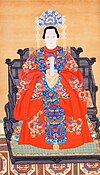
|

|

|
| Changfu | 常服 | Everyday court dress of mìngfu. | Ming | 
|

|
|
| Bufu | 补服 | Changfu sewn with Mandarin square. Ceremonial court dress of mìngfu. | Ming | 
|

|

|
Footwear
There were many etiquettes which rule people's daily lives, and this included the use and etiquettes of shoes and socks wearing. The rules of Zhou stipulated that shoes had to be removed before entering a house; shoes and socks had to be removed at banquets, and ministers who had to meet with the emperor had to remove both their shoes and socks. Being barefoot was considered a taboo on ceremonial worship occasions.
Shoes
Collectively, shoes are typically called lü (履) since the Han dynasty. In the Qin dynasty, shoes were referred as ju (屦). The word xie (鞋) eventually replaced the word lü to become a general name for shoes.
Since the ancient times, Chinese shoes came in various kinds; there were leather shoes (made of tanbark and pelt), cloth shoes (made of silk, hemp, damask, brocade, and crepe), and straw shoes (made of leaves and stems of cattail, corn leaves, and kudzu), ji (屐; wooden clogs). Han Chinese typically wore lü, xi (shoes with thick soles), and ji. Different shoes were worn based on their appropriateness for specific occasions; shoes also denoted the social ranks of its wearers.
| Name | Definition | Description | Period | Images | |||
|---|---|---|---|---|---|---|---|
| Ju (屦) | Shoes | Some shoes worn in Qin were square-headed; they were generally worn by archers. | Qin dynasty | 
|
|||
| Lü (履) or Xie
(鞋) |
Xieqiao (鞋翘) | Curled up Shoe | Some ancient Chinese shoes had curled up-shoes, i.e. shoes with rising toe caps, and could come in different shapes, such as tiger heads and phoenixes. | Han - Unknown | 
|
File:寶相花錦履.jpg | 
|
| Cailu
草鞋 |
Straw shoes | Straw shoes were worn by almost all people in ancient China regardless of social ranks; nomadic tribes were the exception. Different types of leaves and leaves would be woven together to create these types of shoes. | Ancient-modern | File:唐代麻線鞋.jpg | 
|
||
| Lianlü (蓮履) | Lotus shoes | Lotus shoes were worn by women who had bounded feet. Exact date of origin is unknown. Based on folk stories, it may have appeared in the Five dynasties period or in the Sui dynasty. | Unknown - Modern | 
|

|

| |
| Hutou xie
(虎头鞋) |
Tiger-head shoes | Also known as "tiger shoes". These shoes were worn by Han Chinese Chinese children to scare off bad spirits. They are usually worn along with the tiger head hat. They vary in styles depending on regional culture. | Unknown - present day | 
|
|||
| Ji (屐) | Wooden Clogs were shoes with two bars running perpendicular under the sole. | In Han dynasty, clogs were used on women's wedding day; they were decorated with colourful designs and ribbons. | |||||
| In the Jin dynasty, a new type of clogs were made. The sole, upper and bars were made with a single, whole piece of wood. | File:棕木屐.JPG | ||||||
| A clog with removable bars, called "Lord Xie Shoe"; it was called after the Southern dynasties period poet Xie Lingyun whose creation of the shoe is attributed to. | |||||||
| Xueji (靴屐) | Boot-like clogs | The clogs which were worn in Southern China gradually became more boot-like after the Tang dynasty. | |||||
| Xue (靴) | Leather boots | Leather boots was introduced by King Wuling of Zhao. They were generally worn by generals and calvarymen in Qin dynasty. The Han Chinese also made women's boots. In the Northerners wore leather boots when horseback riding in the Northern and Southern dynasties. | Zhou-Present day | 
|

|
||
Socks
Accessories
Hats, headwear and hairstyles
On top of the garments, hats (for men) or hairpieces (for women) may be worn. One can often tell the profession or social rank of someone by what they wear on their heads. The typical types of male headwear are called jin (巾) for soft caps, mao (帽) for stiff hats and guan (冠; crowns or caps) for formal headdress. Officials and academics have a separate set of hats, typically the putou (幞頭), the wushamao (烏紗帽), the si-fang pingding jin (四方平定巾; or simply, fangjin: 方巾) and the Zhuangzi jin (莊子巾). A typical hairpiece for women is the ji (笄; hair stick) that appeared since Neolithic time, and there are more elaborate hairpieces.
In addition, managing hair was also a crucial part of ancient Han people's daily life. Commonly, males and females would stop cutting their hair once they reached adulthood. This was marked by the Chinese coming of age ceremony Guan Li, usually performed between ages 15 to 20. They allowed their hair to grow long naturally until death, including facial hair. This was due to Confucius' teaching "Shenti fa fu, shou zhu fumu, bu gan huishang, xiaozhi shi ye (身體髮膚,受諸父母,不敢毀傷,孝之始也)" – which can be roughly translated as 'My body, hair and skin are bestowed by my father and mother, I dare not damage any of them, as this is the least I can do to honor and respect my parents'. In fact, cutting one's hair off in ancient China was considered a legal punishment called 'Kun (髡)', designed to humiliate criminals, as well as applying a character as a facial tattoo to notify one's criminality, the punishment is referred to as 'Qing (黥)', since regular people wouldn't have tattoos on their skin attributed to the same philosophy.

Children were exempt from the above commandment; they could cut their hair short, make different kinds of knots or braids, or simply just let them hang without any care, especially because such a decision was usually made by the parents rather than the children themselves; therefore, parental respect was not violated. However, once they entered adulthood, every male was obliged to tie his long hair into a bun called ji (髻) either on or behind his head and always cover the bun up with different kinds of headdresses (except Buddhist monks, who would always keep their heads completely shaved to show that they're "cut off from the earthly bonds of the mortal world"; and Taoist monks, who would usually just use hair sticks called '簪' (zān) to hold the buns in place without concealing them). Thus the 'disheveled hair', a common but erring depiction of ancient Chinese male figures seen in most modern Chinese period dramas or movies with hair (excluding facial hair) hanging down from both sides and/or in the back are historically inaccurate. Females on the other hand, had more choices in terms of decorating their hair as adults. They could still arrange their hair into as various kinds of hairstyles as they pleased. There were different fashions for women in various dynastic periods.
Such strict "no-cutting" hair tradition was implemented all throughout Han Chinese history since Confucius' time up until the end of Ming dynasty (1644 CE), when the Qing Prince Dorgon forced the male Han people to adopt the hairstyle of Manchu men, which was shave their foreheads bald and gather the rest of the hair into ponytails in the back (See Queue) to show that they submitted to Qing authority, the so-called "Queue Order" (薙髮令). Han children and females were spared from this order, also Taoist monks were allowed to keep their hair and Buddhist monks were allowed to keep all their hair shaven. Han defectors to the Qing like Li Chengdong and Liu Liangzuo and their Han troops carried out the queue order to force it on the general population. Han Chinese soldiers in 1645 under Han General Hong Chengchou forced the queue on the people of Jiangnan while Han people were initially paid silver to wear the queue in Fuzhou when it was first implemented.
Types of Headwear for males
| Name | Definition | Suitable age | Match | Period | Images | |||
|---|---|---|---|---|---|---|---|---|
| Mian Guan (冕冠) | Shi er liu mian (十二旒冕) | Twelve-tasselled Crown. Initially all Mian Guan were worn by emperors, later emperors only wore this type. |
Adult | Zhou – Ming |  |
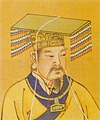 |

| |
| Jiuliu mian (九旒冕) | Nine-tasselled Crown. Worn by dukes and crown prince's servants. |
Adult | Zhou – Han |  |
File:Mianguan.jpg | |||
| Others | Baliu mian (八旒冕): Eight-tasselled Crown. Worn by princes and dukes. Qiliu mian (七旒冕): Seven-tasselled Crown. Worn by ministers. Wuiu mian (五旒冕): Five-tasselled Crown. Worn by viscounts and barons. | |||||||
| Pibian (皮弁) | Leather Crown. Embedded with jades. Worn by all nobles. | Adult | Zhou – Ming | 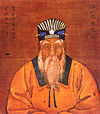 |
File:Ming crown.jpg | 
| ||
| Liang Guan (梁冠) | Tongtian Guan (通天冠)/ Gaoshan Guan (高山冠) |
Sky-reaching Crown/High Mountain Crown. Worn by emperors in special occasions. | Adult | Qin – Ming |  |
|||
| Yuanyou Guan (远游冠) | Travel Crown. Worn by emperors and princes. Similar to Tongtian Guan. Also worn by dukes in Han dynasty. | Adult | Qin – Ming |  |
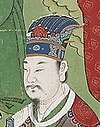 |

| ||
| Diaochan Guan (貂蟬冠) | Mink's Tail and Cicada's Wing Crown. Worn by emperor's servants and government officials. | Adult | Qin – Ming |  |
 |

| ||
| Jinxian Guan (進賢冠) | Recommending Crown. First worn by confucian scholars, later worn by government officials. | Adult | Zhou – Ming |  |
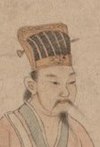 |
File:Ming dynasty Wu Liang Guan.png | ||
| Zhongjing Guan (忠靖冠) | Loyal and stable crown. Worn by retired officials. | Adult | Ming | 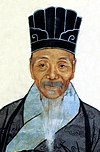 |
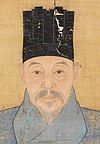 |
File:明忠靖冠 Zhongjing Guan.png | ||
| Shufa Guan (束发冠) | Hair-gathering Crown. A small cap to gather hair inside, fixed with long hairpin. Daily wear of all male. Mini size, sometimes in shapes of Liangguan. | Adult | Five Dynasties - Ming |  |
 |

| ||
| Chang Guan (长冠) | Long Crown. Designed and First worn by Emperor Gaozu of Han. Later worn by Han dynasty's officials. | Adult | Han | File:Hang dynasty wooden figurine.jpg | ||||
| Lianhua Guan (莲花冠) | Lotus Crown. First worn by highest rank Taoist Maste, later also worn by the nobility. | Adult | Tang - Song |  |
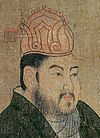 |

| ||
| Putou (襆頭) | Chuijiao Putou (垂腳襆頭) | Head cover/Head wrap. An early form of informal headwear dates back as early as Jin dynasty that later developed into several variations for wear in different occasions. | Adult | Tang – Ming | 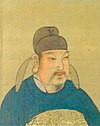 |
 |

| |
| Zhanjiao Putou (展角幞頭) | Spread-horn head cover. Designed by Emperor Taizu. Elongated horns on both sides can keep the distance between officials so they couldn't whisper to each other during court assemblies. | Adult | Changfu (Tang), Gongfu (Song-Ming) | Tang – Ming |  |
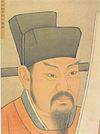 |

| |
| Zhanchi Putou (展翅幞頭) | Spread-wing head cover. Commonly as Wushamao (乌纱帽), Black-cloth hat. Standard headwear of officials during the Ming dynasty. The term "Wushamao" is still frequently used as Chinese slang referring to government positions. | Adult | Ming | 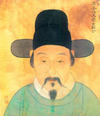 |
 |

| ||
| Yishan Guan (翼善冠) | Philanthropy Crown, with wings folded upwards. Worn by emperors and princes of the Ming dynasty, as well as kings of many China's tributaries. Sometimes decorated with jewels and dragons. | Adult | Tang – Ming |  |
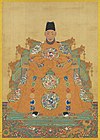 |

| ||
| Tang jin (唐巾) | Adult | Ming |  |
|||||
| Gaowu mao (高屋帽) | Baisha mao (白紗帽) | Also known as white gauze hat. It was worn by the sovereigns of Liu-Song and Southern Qi, it was later inherited by the Sui dynasty. | Adult | White gauze hat. | Northern and Southern dynasties – Tang |  |
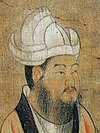 |
|
| Wusha Gaowu mao (烏紗高屋帽) | High reach black gauze hat. | Adult | Northern and Southern dynasties – Song |  |
||||
| Zhulu mao (逐鹿帽) | Adult | Northern and Southern dynasties | ||||||
| Liuheyitong mao (六合一統帽) | 'Six-part' United hat. Name originate from Ming dynasty's founder Hongwu Emperor uniting China in six direction, earth to sky, east to west, north to south. | Adult | Ming |  |
||||
| Zhuangzi jin (莊子巾) | Adult | Zhou – Han |  |
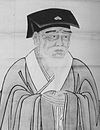 |
||||
| Fu jin (幅巾) | Adult | Han – Ming | 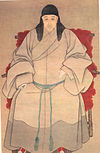 |
 |

| |||
| Cheng zi guan (程子冠) | Adult | Five Dynasties and Ten Kingdoms - Song |  |
 |
||||
| Dongpo jin (東坡巾) | Adult | Song – Ming |  |
 |

| |||
| Zhouzi jin (周子巾) | Adult | Song – Ming |  |
|||||
| Sifang pingding jin (四方平定巾) | Adult | Ming |  |
|||||
| Wangjin (網巾) | Adult | Ming | 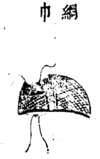 |
 |
||||
| Hutou mao (虎头帽) | Tiger head hat. | Children | Song - Modern time |  |
 |

| ||
| Zhuangyuan mao (状元帽) | Champion hat. | Children | Song - Modern time | File:狀元帽.jpg | File:狀元帽2.jpg | File:狀元帽3.jpg | ||
| Chixiao mao (鴟鴞帽) | Owl hat. | Children | Song - Modern time | File:鴟鴞帽.jpg |  |
|||
| Xianggong mao (相公帽) | Husband hat. | Children | Song - Modern time | File:相公帽2.jpg | File:相公帽.jpg | File:公子帽.jpg | ||
Types of headwear for females
| Name | Definition | Suitable age | Match | Period | Images | |||
|---|---|---|---|---|---|---|---|---|
| Ji (笄) | Single-pronged hairpin. They were often inscribed with auspicious patterns. | Adult | Neolithic – Qin |  |
 |
|||
| Zanzi (簪子) | Single-pronged hairpin after Qin dynasty. | Adult | Han – Qing |  |
 |
|||
| Chaizi (钗子) | Two-pronged hairpin. | Adult | Han – Qing |  |
 |
|||
| Yanbin (掩鬓) | The hairpin covering sideburns. | Adult | Ming – Qing |  |
 |
|||
| Buyao (步摇) | Buyao Zan (步摇簪) | Single-pronged hairpin with dangling decorations. | Adult | Han – Qing | File:Qing dynasty's gold and tian-tsui buyao (清镀金点翠鸟架步摇).png | File:Buyao Flower.jpg | ||
| Buyao Guan (步摇树) | Buyao Tree. Tree-shaped dangling decoration centered at front of hair. | Adult | Han – Ming |  |
File:Deer Head Buyao Guan (鹿首步摇冠).jpg | 
| ||
| Buyao Guan (步摇冠) | Buyao Crown. Crown consisted of dangling decorations. | Adult | Han – Ming | 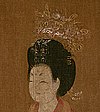 |
||||
| Zan hua (簪花) | Flower hairpin. Could be fresh flower, silk flower, and flowers made with other materials. Man could also wear. | Adult | Tang - Qing | 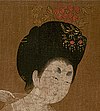 |
 |

| ||
| Huasheng (華勝) | Round flower hairpin centered front of hair. | Adult | Han – Song | 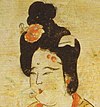 |
 |
|||
| Di Guan (翟冠) | Adult | Song - Ming |  |
 |
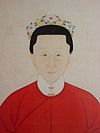
| |||
| Hua Guan (花冠) | Flower Crown. | Adult | Han – Song | 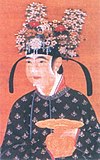 |
File:Sui dynasty Flower Crown.jpg | |||
| Tang Princess's Crown (唐公主头冠) | Adult | Tang | File:Tangcrown.jpg | |||||
| Feng Guan (鳳冠) | Huashu Guan (花树冠) | Flower Tree Crown. | Adult | Tang | File:Reverse replica of the crown of Empress Xiao.png | |||
| Feicui Fengguan (翡翠凤冠 ) | Jade Phoenix Crown. | Adult | Tang | 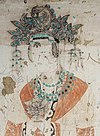 |
||||
| Long Feng Huacha Guan (龙凤花钗冠 ) | Dragon Phoenix Hairpin Crown. | Adult | Song-Ming |  |
 |
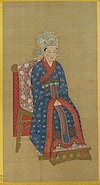
| ||
| Yanju Guan (燕居冠) | Adult | Ming |  |
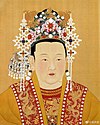 |

| |||
| Mo E (抹额) | Piece of garment covering forehead. | Adult | Tang-Qing |  |
||||
| Lianhua mao (莲花帽) | Lotus hat. | Children | Song - Modern time | File:蓮花帽3.jpg | ||||
| Shubi (梳篦) or zhi | Shu (梳) | Comb. | Ancient - Modern | 
|

|
|||
| Bi (篦) | Fine-toothed comb. | Spring and Autumn period - Modern | 
|
|||||
| Mili (羃䍦) | A hat with a long veil which covered the face and body | 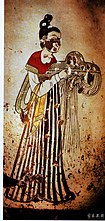
|
||||||
| Weimao (帷帽) | A hat with short veil which covers the face | |||||||
| Humao (胡帽) | A hat without the veil | |||||||
Jewelries
Earrings
In Qing dynasty, Han Chinese women wore a single earring at each ears which contrasted from the Manchu women who had to wear three earrings at each ears. From the middle of the eighteenth century, Manchu women adopted the Han Chinese single earring despite breaking the Manchu dress code and the laws which prevented them from wearing Han Chinese women clothing; this lead to the frustrations of the Qing emperors.
Jade pendants
Jade pendants (玉佩; yupei) were popular even before Confucius was born. The history of the art of jade carving in China to make ornaments, including dress ornaments, extends back to before 5000 BC. Ancient Chinese held even greater importance to yupei after it was regarded as a moral integrity by Confucius. Some yupei were stringed together to make pendants which would hold at the belt while other yupei was made of chains of bi (璧; jade discs or jade rings). Jade in the form of Huang were also popular in the making of yupei and had a rigid and specific rules attached to its use. Some jade pendants also combined jades in the shape of dragons, phoenixes, humans, human-dragons, and animals, etc.
-
 Chinese Jade pendant in the form of a bi, 2000–1500 B.C.
Chinese Jade pendant in the form of a bi, 2000–1500 B.C.
-
 Shang jade pendant in the form of a fish
Shang jade pendant in the form of a fish
-
 Jade pendants in the form of stags, Western Zhou.
Jade pendants in the form of stags, Western Zhou.
-
 Jade pendant with Huang, Western Zhou
Jade pendant with Huang, Western Zhou
-
 Western Zhou Jade Huang from a jade pendant.
Western Zhou Jade Huang from a jade pendant.
-
 Late Spring & Autumn Jade Ornaments composed of bi and huang jade, and dragon-shaped jade.
Late Spring & Autumn Jade Ornaments composed of bi and huang jade, and dragon-shaped jade.
-
 Yupei from Ying state, Western Zhou
Yupei from Ying state, Western Zhou
-
 Yupei (玉佩), Tang Dynasty.
Yupei (玉佩), Tang Dynasty.
-
 Ming Jade pendant
Ming Jade pendant
-
 Jade pendant, Qing dynasty
Jade pendant, Qing dynasty
Ribbons, Shawls, and Scarves
Hand-held Fans
Historically, fans have played an important aspect in the life of the Chinese people. The Chinese have used hand-held fans as a way to relief themselves during hot days since the ancient times; the fans are also an embodiment of the wisdom of Chinese culture and art. They were also used for ceremonial purposes and as a sartorial accessory. So far, the earliest fans that had been found date to the Spring and Autumn and Warring States Period; these were made of either bamboo or feathers. The arts of fan making eventually progressed to the point that by the Jin dynasty, fans could come in different shapes and could be made in different materials.
Silk round-shaped fans (团扇; tuanshan), are also known as "fans of reunion", is a type of "rigid fan". These types of fans were mostly used by women in the Tang dynasty and was later introduced into Japan. These round fans remained mainstream even after the growing popularity of the folding fans. Round fans with Chinese paintings and with calligraphy became very popular in the Song dynasty.
In 988 AD, folding fans (折扇; zheshan) was first introduced in China by a Japanese monk from Japan as a tribute during the Northern Song dynasty; these folding fans became very fashionable in China by the Southern Song dynasty. The folding fans later became very fashionable in the Ming dynasty.
Another popular type of fan was the palmetto fan (蒲葵扇; pukui shan), also known as pushan (蒲扇), which was made of the leaves and stalks of pukui (i.e. Livistona chinensis).
-
Replica of a Short-handled Bamboo Fan, Warring States period Tomb.
-
A girl holding a round fan with a long handle, Tang dynasty.
-
 A woman holding a flat oval fan with a Chinese painting, a type of rigid fan; painting by Chen Hongshou (1598-1652).
A woman holding a flat oval fan with a Chinese painting, a type of rigid fan; painting by Chen Hongshou (1598-1652).
-
A round fan with a Chinese painting, a type of rigid fan; late Qing dynasty.
-
A rigid fan with a Chinese painting of a cat and a calligraphy, late Qing dynasty.
-
 Folding fan with a Chinese painting and a Chinese poem, painted by the Qianlong emperor, Qing dynasty, 1762 AD.
Folding fan with a Chinese painting and a Chinese poem, painted by the Qianlong emperor, Qing dynasty, 1762 AD.
-
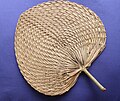 A pukui shan, a type of Chinese fan made with palm weaving.
A pukui shan, a type of Chinese fan made with palm weaving.
Gallery
| This section contains an unencyclopedic or excessive gallery of images. Please help improve the section by removing excessive or indiscriminate images or by moving relevant images beside adjacent text, in accordance with the Manual of Style on use of images. (April 2019) (Learn how and when to remove this message) |
-
 Hanfu parts.
Hanfu parts.
-
 Dr. Chen Huanzhang (1880-1933), founder of the Confucian Academy, wearing shenyi.
Dr. Chen Huanzhang (1880-1933), founder of the Confucian Academy, wearing shenyi.
See also
- Cheongsam
- Chinese academic dress
- Chinese clothing
- Chinese culture
- Cosplay
- Guan Li
- List of Hanfu
- Mandarin square
- Wafuku—a Japanese equivalent
- Hanfu movement
References
- Yao, Yuxin. "Hanfu reflects search for cultural roots – Chinadaily.com.cn". Retrieved 7 February 2021.
- China Daily. "Culture lovers dress to impress – China.org.cn". Retrieved 7 February 2021.
- ^ Wang, Xinyi; Colbert, François; Legoux, Renaud (2020). "From Niche Interest to Fashion Trend: Hanfu Clothing as a Rising Industry in China". International Journal of Arts Management. 23 (1). Retrieved 1 February 2021.
- China Daily (4 September 2019). "Hanfu market grows across China". China Daily. Retrieved 31 January 2021.
- Zhang, Tianwei (25 November 2020). "Putting China's Traditional Hanfu on the World Stage". Women's Wear Daily . Retrieved 1 February 2021.
- Wright, Julia (17 August 2019). "Traditional Chinese clothing inspires a budding fashion in Saint John". CBC News. Retrieved 1 February 2021.
- Yang, Shaorong (2004). Traditional Chinese Clothing: Costumes, Adornments & Culture. Long River Press. p. 3. ISBN 1592650198.
-
- The Korean Overseas Information Service Seoul, Republic of Korea (ROK) (2005). HELLO from Korea. 길잡이미디어. p. 39. ISBN 978-89-7375-374-1.
- Welters, Linda; Lillethun, Abby (2018). Fashion History: A Global View. Bloomsbury Publishing. ISBN 978-1-4742-5365-9.
- "China: History of Dress". www.encyclopedia.com. Retrieved 1 March 2021.
-
- 최, 부 (1992). 漂海录: 中国行记 (in Chinese). 社会科学文献出版社, 1992. ISBN 9787800502934. Retrieved 6 February 2021.
- * Ming Taizong ShiLu 明太宗实录卷二十四 Chapter.24 (in Chinese). 1430. Retrieved 6 February 2021.
- History of Ming Chapter.320 明史/卷320 外国一·朝鲜 (in Chinese). 1430. Retrieved 6 February 2021.
- * Ming Taizong ShiLu Chapter.24 明太宗实录卷二十四 (in Chinese). 1644. Retrieved 6 February 2021.
- * 朝鲜李朝实录中的中国史料 (in Chinese). Zhonghua Book Company. 1980. p. 167. Retrieved 6 February 2021.
- * Annals of Sino-Korean poetry Exchange from Hongwu Reign to Zhengde Reign in Ming Dynasty 明洪武至正德中朝诗歌交流系年 (in Chinese). Beijing Book Co. 2014. ISBN 9787020103102. Retrieved 6 February 2021.
- * 서, 거정 (1485). 동국통감 東國通鑑 (in Chinese). Beijing Book Co. Retrieved 6 February 2021.
- Tae-ok, Lee (2003). Study on Danryung structure. Proceedings of the Korea Society of Costume Conference. p. 49.
- "Dress - Korea". Encyclopedia Britannica. Retrieved 3 March 2021.
{{cite web}}: CS1 maint: url-status (link) - Stevens, Rebecca (1996). The kimono inspiration: art and art-to-wear in America. Pomegranate. pp. 131–142. ISBN 978-0-87654-598-0.
- Dalby, Liza (2001). Kimono: Fashioning Culture. Washington, USA: University of Washington Press. pp. 25–32. ISBN 978-0-295-98155-0.
- "Traditional Costume that Represents Okinawa's Culture and National Features, the "Ryusou". | Features | Okinawa Travel Info". okinawatravelinfo.com. Retrieved 22 March 2021.
- Nordquist, Barbara K. (1 January 1978). "The Ryūkyū Islands: Some Notes on Dress". Dress. 4 (1): 66–75. doi:10.1179/036121178805298829. ISSN 0361-2112.
- 《大南實錄・正編・第一紀・世祖實錄》,越南阮朝,國史館
- 《大南实录・正编・第一纪・卷五十四・嘉隆十五年七月条》,越南阮朝,國史館
- ^ Gardner, Eric; Lin, Shuning; Tan, Qiuye; Ma, Antonia. "Ancient China | Chinese Culture: Communicating through Fashion". you.stonybrook.edu. Retrieved 28 February 2021.
{{cite web}}: CS1 maint: url-status (link) - Sandra Lee Evenson (30 October 2014). "Hanfu Chinese robes". In Annette Lynch; Mitchell D. Strauss (eds.). Ethnic Dress in the United States A Cultural Encyclopedia. Rowman & Littlefield Publishers. pp. 135–136. ISBN 978-0-7591-2150-8.
- Brown, John (2006). China, Japan, Korea: Culture and Customs. Createspace Independent Publishing (published 7 September 2006). p. 79. ISBN 978-1419648939.
- ^ Bulag, Uradyn E. (2010), Wearing Ethnic Identity: Power of Dress, vol. 6, Oxford: Berg Publishers, pp. 75–80, doi:10.2752/bewdf/edch6014, ISBN 9781847888556, retrieved 28 February 2021
- ^ Shi, Songge (2021). Travelling With Hanfu: A Social Media Analysis of Contemporary Chinese Travelling for Artistic Photographs (Master of International Tourism Management thesis). Auckland University of Technology.
- Sim, Cheryl (2019). Wearing the cheongsam : dress and culture in a Chinese diaspora. London. p. 149. ISBN 978-1-350-10987-2. OCLC 1109390790.
{{cite book}}: CS1 maint: location missing publisher (link) - ^ China National Silk Museum. "中国丝绸博物馆". www.chinasilkmuseum.com. Retrieved 4 February 2021.
- Travel China Guide. "Celebrities of Yangtze Area". Travel China Guide. Retrieved 4 February 2021.
- "Book of Changes : Xi Ci II – Chinese Text Project". ctext.org (in Chinese (China)). Retrieved 4 February 2021.
- Peterson, Barbara Bennett (2015). Notable women of China : Shang dynasty to the early twentieth century. London: Routledge. ISBN 9781315702063. Retrieved 3 February 2021.
- ^ Ho, Wei; Lee, Eun-Young (2009). "Modern Meaning of Han Chinese Clothing" (PDF). Journal of the Korea Fashion & Costume Design Association. 11 (1): 99–109.
- ^ Ma, Xiaofang (2018). "Study on the Aesthetics of Han Chinese Clothing Culture in the TV Play "Nirvana in Fire"". Advances in Social Science, Education and Humanities Research. 233. Atlantis Press: 639–643. doi:10.2991/iccessh-18.2018.143. ISBN 978-94-6252-528-3.
- ^ Finnane, Antonia (2008), Changing clothes in China: fashion, history, nation, Columbia University Press, pp. 44–46, ISBN 978-0-231-14350-9
- ^ "Ancestors, The Story of China – BBC Two". BBC.
- Dien, Albert E. (2007). Six dynasties civilization. New Haven, Conn.: Yale University Press. p. 312. ISBN 978-0-300-07404-8. OCLC 72868060.
- Yang, Shaorong (2004). Traditional Chinese clothing : costumes, adornments & culture (1st ed.). San Francisco: Long River Press. ISBN 9781592650194. Retrieved 4 February 2021.
- Neo, Jocelyn; Yen, Li (23 December 2018). "Singapore Han Cultural Society: Reviving Chinese Han Couture (Hanfu)". The Epoch Times (Singapore). Retrieved 3 February 2021.
- ^ Feng, Ge; Du, Zhengming (2015). Traditional Chinese rites and rituals. Newcastle upon Tyne: Cambridge Scholars Publishing. ISBN 9781443887830. Retrieved 4 February 2021.
- ^ Lüsted, Marcia Amidon (2017). Ancient Chinese daily life (1 ed.). New York: New York : Rosen Publishing. pp. 14–22. ISBN 978-1-4777-8889-9. OCLC 957525459.
- Zhao, Yin (2014). Snapshots of Chinese culture. Xinzhi Cai. Los Angeles: Bridge21 Publications. ISBN 978-1-62643-003-7. OCLC 912499249. Archived from the original on 2014.
{{cite book}}: Check date values in:|archive-date=(help) - ^ Xu, Rui; Sparks, Diane (2011). "Symbolism and Evolution of Ku-form in Chinese Costume". Research Journal of Textile and Apparel. 15 (1): 11–21. doi:10.1108/rjta-15-01-2011-b002. ISSN 1560-6074.
- ^ Sheng, Angela (1995). "The Disappearance of Silk Weaves with Weft Effects in Early China". Chinese Science (12): 41–76. ISSN 0361-9001. JSTOR 43290485.
- The National Museum of China. "Xia, Shang, and Western Zhou Dynasties : II Economy". The National Museum of China. Archived from the original on 11 February 2021. Retrieved 11 February 2021.
- "Shang Dynasty (1600 B. C. — 1046 B. C.) — Empire of Bronze Age and Scripts on Oracle Bones". chinafetching.com. Archived from the original on 8 March 2021. Retrieved 8 March 2021.
{{cite web}}:|archive-date=/|archive-url=timestamp mismatch; 11 February 2021 suggested (help) - ^ Zhang, Qizhi (2015). An introduction to Chinese history and culture. Heidelberg: Springer, Berlin, Heidelberg. pp. 255–261. ISBN 978-3-662-46482-3.
- ^ Snodgrass, Mary Ellen (2015). World Clothing and Fashion : an Encyclopedia of History, Culture, and Social Influence. Hoboken: Taylor and Francis. pp. 121–122. ISBN 978-1-317-45167-9. OCLC 910448387.
- ^ Milburn, Olivia; Yan, Ying (2015). The Spring and autumn annals of Master Yan. Leiden: Brill. p. 319. ISBN 978-90-04-30966-1. OCLC 933295487.
- ^ Wang, Ningning (2019). A HISTORY OF ANCIENT CHINESE MUSIC AND DANCE. American Academic Press. p. 139. ISBN 9781631816345.
- ^ 臧, 迎春 (2003). 臧, 迎春 (ed.). 中国传统服饰. 臧迎春, 李竹润. 五洲传播出版社. ISBN 7508502795.
- "周原遗址出土的骨笄".
- "2". Li yi.
女子許嫁,笄而醴之,稱字。
- "2". Li yi.
皮弁笄,爵弁笄,緇組紘,纁邊,同篋。
- ^ Zang, Yingchun; 臧迎春. (2003). Zhongguo chuan tong fu shi. 李竹润., 王德华., 顾映晨. (Di 1 ban ed.). Beijing: Wu zhou chuan bo chu ban she. ISBN 7-5085-0279-5. OCLC 55895164. Archived from the original on 2003.
{{cite book}}: Check date values in:|archive-date=(help) - ^ China Style. "Garments during the Spring & Autumn and Warring States Period – - China Style". www.chinastyle.cn. Retrieved 4 February 2021.
- ^ Yang, Shaorong (2004). Traditional Chinese clothing : costumes, adornments & culture (1st ed.). San Francisco: Long River Press. ISBN 9781592650194.
- ^ Hays, Mary V (1989). "Chinese Skirts of the Qing dynasty" (PDF). The Bulletin of the Needle and Bobbin Club. 72: 4–42.
- ^ Wang, Yiwen; Luo, Ronglei (2020). "江陵马山一号楚墓襦裙形制及结构研究". Journal of Silk. 57 (6): 52–57. doi:10.3969/j.issn.1001-7003.2020.06.009.
- ^ Hao, Peng; Ling, Zhang (2018). "On "Skirts" and "Trousers" in the Qin Dynasty Manuscript Making Clothes in the Collection of Peking University". Chinese Cultural Relics. 5 (1): 248–268.
- ^ Zhang, Ling (2016). "A study on skirt construction in Qin dynasty" (PDF). The International Foundation of Fashion Technology Institutes. 18: 198–205.
- "湖北江陵马山一号墓出土的衣被(下)". 中国考古网.
- ^ Hua, Mei (2004). Chinese Clothing (1 ed.). Beijing: China International Press. pp. 9–14. ISBN 7-5085-0540-9.
- ^ Zhang, Qizhi (2015). An introduction to Chinese history and culture. Heidelberg: Heidelberg Springer. ISBN 978-3-662-46482-3. OCLC 909065833. Retrieved 4 February 2021.
- ^ Steele, Valerie (1999). China chic : East meets West. John S. Major. New Haven: Yale University Press. p. 24. ISBN 0-300-07930-3. OCLC 40135301.
- HunanChangsha. "The great mount of Chen, the Grave of Chu's Late Zhou Silk Painting 陈家大山楚墓出土的《人物龙凤帛画》". Retrieved 6 February 2021.
- Dan, Zhou; Wang, Yunjiao. "Research on Translation of Costume Terms in Chu Ci" (PDF). Academic Journal of Humanities & Social Sciences. 4 (2). Francis Academic Press, UK: 83–88. doi:10.25236/AJHSS.2021.040218 (inactive 29 March 2021).
{{cite journal}}: CS1 maint: DOI inactive as of March 2021 (link) - Hunan Museum. "Plain Gauze Gown". Hunan Museum. Retrieved 3 February 2021.
- LINGLEY, KATE A. (2010). "NATURALIZING THE EXOTIC: On the Changing Meanings of Ethnic Dress in Medieval China". Ars Orientalis. 38: 74. ISSN 0571-1371. JSTOR 29550020.
- Havliček, Christine M. (1 December 2015). "Innovation Transfer during the Warring States Period: Considering the Importance of Early China's Relationship with the Steppes". Vienna Journal of East Asian Studies. 7 (1): 103–128. doi:10.2478/vjeas-2015-0004. S2CID 134772057.
- ^ Xu, Guobin; Chen, Yanhui; Xu, Lianhua; Chen, Kaiju (2018). Introduction to Chinese culture : cultural history, arts, festivals and rituals. Singapore: Singapore : Palgrave Macmillan. p. 183. ISBN 9789811081569. OCLC 1030303372. Retrieved 4 February 2021.
- ^ Feng, Ge (2015). Traditional Chinese rites and rituals. Zhengming Du. Newcastle upon Tyne: Cambridge Scholars Publishing. p. 16. ISBN 978-1-4438-8783-0. OCLC 935642485.
- van Someren, Taco C. R. van; Someren-Wang, Shuhua (2013). "Chinese Culture, Strategy, and Innovation". Innovative China : innovation race between East and West. Shuhua Someren-Wang. Berlin: Springer. pp. 27–56. ISBN 978-3-642-36237-8. OCLC 842903195.
- ^ Steele, Valerie (1999). China chic : East meets West. John S. Major. New Haven: Yale University Press. pp. 23–33. ISBN 0-300-07930-3. OCLC 40135301.
- ^ "China: History of Dress | Encyclopedia.com". www.encyclopedia.com. Retrieved 28 February 2021.
- ^ LINGLEY, KATE A. (2010). "NATURALIZING THE EXOTIC: On the Changing Meanings of Ethnic Dress in Medieval China". Ars Orientalis. 38: 57. ISSN 0571-1371. JSTOR 29550020.
- "Costume in the Han Dynasty - - China Style". www.chinastyle.cn. Retrieved 6 February 2021.
- ^ Hua, Mei (2004). Chinese Clothing (1 ed.). Beijing: China International Press. p. 4. ISBN 7-5085-0540-9.
- ^ Zhao, Feng (2015). Lu, Yongxiang (ed.). A History of Chinese Science and Technology. Berlin, Heidelberg: Springer Berlin Heidelberg. pp. 391–392. doi:10.1007/978-3-662-44166-4. ISBN 978-3-662-44165-7.
- "Shang Shu : Yu Shu : Yi and Ji - Chinese Text Project". ctext.org. Retrieved 17 February 2021.
{{cite web}}: CS1 maint: url-status (link) - 臧, 迎春 (2003). 中国传统服饰. 五洲传播出版社. p. 36. ISBN 978-7-5085-0279-3.
- "Costume in the Han Dynasty - - China Style". www.chinastyle.cn. Retrieved 13 February 2021.
- ^ Xu, Guobin; Chen, Yanhui; Xu, Lianhua (2018), Xu, Guobin; Chen, Yanhui; Xu, Lianhua (eds.), "Clothing, Food, Housing and Transportation", Introduction to Chinese Culture: Cultural History, Arts, Festivals and Rituals, Singapore: Springer, pp. 181–203, doi:10.1007/978-981-10-8156-9_8, ISBN 978-981-10-8156-9, retrieved 14 February 2021
- ^ Müller, Shing (2019). The Cambridge history of China. Vol. 2. Denis Crispin Twitchett, John King Fairbank. Cambridge : Cambridge University Press. pp. 384–417. ISBN 978-0-521-24327-8. OCLC 2424772.
- ^ Kieser, Annette (2019). The Cambridge history of China. Vol. 2. Denis Crispin Twitchett, John King Fairbank. Cambridge : Cambridge University Press. pp. 418–442. ISBN 978-0-521-24327-8. OCLC 2424772.
- "15". Shiming.
簪珥。珥。耳珰垂珠也。簪以玳瑁为擿,长一尺,端为华胜,上为凤皇爵,以翡翠为毛羽,下有白珠,垂黄金镊。左右一横簪之,以安蔮结。诸簪珥皆同制,其擿有等级焉。
- "15". Shiming.
步搖,上有垂珠,步則搖也。
- "120". Book of the Later Han.
步摇以黄金为山题,贯白珠为桂枝相缪...
- ^ Hua, Mei (2004). Chinese Clothing (1 ed.). Beijing: China Intercontinental Press. ISBN 7-5085-0540-9. OCLC 60568032.
- ^ Dien, Albert E (2007). Six dynasties civilization. New Haven, Conn.: Yale University Press. pp. 312–330. ISBN 978-0-300-07404-8. OCLC 72868060.
- ^ LINGLEY, KATE A. (2010). "NATURALIZING THE EXOTIC: On the Changing Meanings of Ethnic Dress in Medieval China". Ars Orientalis. 38: 50–80. ISSN 0571-1371. JSTOR 29550020.
- Hua, Mei (2004). Chinese Clothing (1 ed.). Beijing: China Intercontinental Press. ISBN 7-5085-0540-9. OCLC 60568032.
- Zhou, Fang; Bian, Xiangyang (2018). "LUO GUI XU ZHUAN HONG XIU YANG: - some questions about GUIYI". China Silk Information Center. Retrieved 11 February 2021.
{{cite web}}: CS1 maint: url-status (link) - Lullo, Sheri A. (2019). "Trailing Locks and Flowing Robes: Dimensions of Beauty during China's Han dynasty (206 bc–ad 220)". Edinburgh University Press. 53 (2): 231–255. doi:10.3366/cost.2019.0122. ISSN 0590-8876.
- Duong, Nancy. "Evolution of Chinese Clothing and Cheongsam". Nancy Duong Art. Retrieved 11 February 2021.
{{cite web}}: CS1 maint: url-status (link) - LINGLEY, KATE A. (2010). "NATURALIZING THE EXOTIC: On the Changing Meanings of Ethnic Dress in Medieval China". Ars Orientalis. 38: 58. ISSN 0571-1371. JSTOR 29550020.
- ^ Chinastyle. "Costume of Wei and Jin Periods - - China Style". www.chinastyle.cn. Retrieved 10 February 2021.
- Zhang, Qizhi (2015), "The Rich and Colorful Social Life in Ancient China", An Introduction to Chinese History and Culture, China Academic Library, Berlin, Heidelberg: Springer Berlin Heidelberg, pp. 249–282, doi:10.1007/978-3-662-46482-3_9, ISBN 978-3-662-46481-6, retrieved 14 February 2021
- "Hanfu History of Ancient Chinese Underwear - 2021". www.newhanfu.com. 15 January 2020. Retrieved 7 February 2021.
- Lewandowski, Elizabeth J. (2011). The Complete Costume Dictionary. Scarecrow Press. ISBN 978-0-8108-4004-1.
- Dien, Albert E. (2007). Six dynasties civilization. New Haven, Conn.: Yale University Press. pp. 333–334. ISBN 978-0-300-07404-8. OCLC 72868060.
- ^ "Costume in the Northern and Southern Dynasties - - China Style". www.chinastyle.cn. Retrieved 13 February 2021.
- Kieser, Annette (2019). The Cambridge history of China. Vol. 2. Denis Crispin Twitchett, John King Fairbank. Cambridge : Cambridge University Press. pp. 436–439. ISBN 978-0-521-24327-8. OCLC 2424772.
- Lewis, Mark Edward (2009). China between empires : the northern and southern dynasties. Cambridge, Mass.: Belknap Press of Harvard University Press. pp. 81, 167. ISBN 978-0-674-04015-1. OCLC 432671549.
- ^ Holcombe, Charles (2013). "The Xianbei in Chinese History". Early Medieval China. 2013 (19): 1–38. doi:10.1179/1529910413Z.0000000006. ISSN 1529-9104. S2CID 162191498.
- Tsiang, Katherine R. (1 June 2002). "Changing Patterns of Divinity and Reform in the Late Northern Wei". The Art Bulletin. 84 (2): 222–245. doi:10.1080/00043079.2002.10787019 (inactive 13 February 2021). ISSN 0004-3079 – via Taylor & Francis Online.
{{cite journal}}: CS1 maint: DOI inactive as of February 2021 (link) - "Northern Wei Tomb in Yunboli Road, Datong, Shanxi. Tomb M1". dla.library.upenn.edu. Retrieved 9 March 2021.
- "Northern Wei Tombs, Yanbei Teacher College, Datong, Shanxi. Tomb M2". dla.library.upenn.edu. Retrieved 11 March 2021.
- Müller, Shing (2019). "Chapter 18 Northern Material Culture". The Cambridge History of China Volume 2: Six dynasties. Cambridge University Press. p. 408. ISBN 9781139107334.
- ^ Wright, Arthur F. (1979). Sui and T'ang China, 589-906. Part 1. Denis Crispin Twitchett, John King Fairbank. Cambridge : Cambridge University Press. pp. 48–55, 58, 73, 81. ISBN 1-139-05594-1. OCLC 317592780.
- Dien, Albert E (2007). Six dynasties civilization. New Haven, Conn.: Yale University Press. p. 424. ISBN 978-0-300-07404-8. OCLC 72868060.
- The Metropolitan Museum of Art : Department of Asian Art (2002). "Period of the Northern and Southern Dynasties (386–581)". www.metmuseum.org. Retrieved 3 March 2021.
{{cite web}}: CS1 maint: url-status (link) - ^ Lingley, Kate A (2014). "Silk Road Dress in a Chinese Tomb: Xu Xianxiu and sixth-century cosmopolitanism" (PDF). The Silk Road. 12: 1–13.
- ^ China : dawn of a golden age, 200-750 AD. James C. Y. Watt, Prudence Oliver Harper, Metropolitan Museum of Art. New York: Metropolitan Museum of Art. 2004. ISBN 1-58839-126-4. OCLC 55846475.
{{cite book}}: CS1 maint: others (link) - ^ Hinsch, Bret (2019). Women in Tang China. Lanham, Maryland: Rowman & Littlefield. p. 149. ISBN 978-1-5381-3489-4. OCLC 1122686753.
- Han, Jing; Quye, Anita (2 January 2018). "Dyes and Dyeing in the Ming and Qing Dynasties in China: Preliminary Evidence Based on Primary Sources of Documented Recipes". Textile History. 49 (1): 44–70. doi:10.1080/00404969.2018.1440099. ISSN 0040-4969. S2CID 192360196.
- "2. Clothing – The Influence of Chang-An Culture to Korea and Japan". you.stonybrook.edu. Retrieved 11 March 2021.
- ^ Cunrui, Victor Xiong (2006). Emperor Yang of the Sui Dynasty : His Life, Times, and Legacy. State University of New York Press. pp. 132–134. ISBN 978-0-7914-8268-1. OCLC 1042816832.
- ^ Lang, Qing (2017). "The "Red" Finery System in the Sui and Tang Dynasties". Advances in Social Science, Education and Humanities Research. 172. Atlantis Press: 551–557. doi:10.2991/icemaess-17.2017.121. ISBN 978-94-6252-425-5.
- Croy, Anita (2015). Everyday life: Inside ancient China (1 ed.). Armonk, N.Y.: Routledge, 2015. p. 27. ISBN 978-1317470939. OCLC 907525912.
- Ma, Boying (2020). History Of Medicine In Chinese Culture, A (In 2 Volumes). Singapore: World Scientific. p. 40. ISBN 978-981-323-799-5. OCLC 1147841857.
- ^ Feng, Ge; Du, Zhengming (2015). Traditional Chinese rites and rituals. Newcastle upon Tyne: Cambridge Scholars Publishing. ISBN 9781443887830. Retrieved 4 February 2021.
- Ka Shing, Charles (1 January 2014). "The Development of Academic Dress in China". Transactions of the Burgon Society. 14 (1): 60–68. doi:10.4148/2475-7799.1119. ISSN 2475-7799.
- Feng, Ge; Du, Zhengming (2015). Traditional Chinese rites and rituals. Newcastle upon Tyne: Cambridge Scholars Publishing. ISBN 9781443887830. Retrieved 4 February 2021.
- Vollmer, John E. (2007). Dressed to rule : 18th century court attire in the Mactaggart Art Collection. Mactaggart Art Collection. Edmonton: University of Alberta Press. p. 33. ISBN 978-1-55195-705-0. OCLC 680510577.
- Feng, Ge; Du, Zhengming (2015). Traditional Chinese rites and rituals. Newcastle upon Tyne: Cambridge Scholars Publishing. ISBN 9781443887830. Retrieved 4 February 2021.
- Wang, Qiao-ling (2008). "Women Fashion of Tang Dynasty and Foreign Cultural Communication". Journal of Zhejiang Wanli University.
- Cao, Zhe (2006). "Women's Common Dress in Tang Dynasty and Its Features at Different Stages". Journal of Wuhan University of Science and Engineering.
- ^ Chen, BuYun (2017). "Material Girls: Silk and Self-Fashioning in Tang China (618–907)". Fashion Theory. 21 (1): 5–33. doi:10.1080/1362704X.2016.1138679. ISSN 1362-704X. S2CID 155949571.
- ^ Bao, Mingxin (1991). "THE WAISTLINE OF WOMEN'S COSTUMES IN TANG DYNASTY AND ITS AESTHETIC EFFECTS--《中国纺织大学学报》1991年Z1期". en.cnki.com.cn. Retrieved 20 February 2021.
{{cite web}}: CS1 maint: url-status (link) - Wan, Li (2016). "The Implicit Beauty and Open Beauty of Tang Dynasty's Aesthetic Taste from Tang Dynasty Noble Women's Clothing Features". Proceedings of the 2016 International Conference on Contemporary Education, Social Sciences and Humanities. Paris, France: Atlantis Press: 352–355. doi:10.2991/iccessh-16.2016.90. ISBN 978-94-6252-215-2.
- Lin, Lin (2018). "Design Comparison of Creative Tang Suit and European Imperial Costume". Proceedings of the International Conference on Contemporary Education, Social Sciences and Ecological Studies (CESSES 2018). 283. Paris, France: Atlantis Press: 488–493. doi:10.2991/cesses-18.2018.109. ISBN 978-94-6252-606-8.
- ^ Yang, Shaorong (2004). Traditional Chinese clothing : costumes, adornments & culture (1 ed.). San Francisco: Long River Press. p. 5. ISBN 1-59265-019-8. OCLC 52775158. Archived from the original on 2004.
{{cite book}}: Check date values in:|archive-date=(help) - Deng, Qionghua (2016). "Research of Women Dresses in the Tang Dynasty and the Modern Dresses Under the Perspective of Postmodernism". Proceedings of the International Conference on Electronics, Mechanics, Culture and Medicine. Paris, France: Atlantis Press: 672–677. doi:10.2991/emcm-15.2016.100. ISBN 978-94-6252-163-6.
- ^ Chen, Buyun (2013). Toward a definition of "fashion" in Tang China (618-907 CE): BuYun Chen (PhD thesis). Columbia University. doi:10.7916/D8KK9B6D. ISBN 978-3-631-60975-0.
- Xv, Zhaofang (2014). "An Attempt to Analyze the Implicitness of the Aesthetic Features of Chinese Art Taking the Aesthetic Features of Women's Clothing in the Flourishing Period of Tang Dynasty as an Example". Proceedings of the International Conference on Education, Language, Art and Intercultural Communication. 3. Atlantis Press: 628–631. doi:10.2991/icelaic-14.2014.158. ISBN 978-94-6252-013-4.
- Deng, Qionghua (2016). "Research of Women Dresses in the Tang Dynasty and the Modern Dresses Under the Perspective of Postmodernism". Proceedings of the International Conference on Electronics, Mechanics, Culture and Medicine. Paris, France: Atlantis Press: 672–677. doi:10.2991/emcm-15.2016.100. ISBN 978-94-6252-163-6.
- Hua, Mei (2004). Chinese Clothing (1 ed.). Beijing: China Intercontinental Press. ISBN 7-5085-0540-9. OCLC 60568032.
- ^ Hsu, Cho-yun (2012). China : A new cultural history. Columbia University Press. p. 220. ISBN 9780231528184.
- Costume in the Tang Dynasty Archived 5 December 2008 at the Wayback Machine chinaculture.org retrieved 7 January 2010
- Yoon, Ji-Won (2006). "Research of the Foreign Dancing Costumes: From Han to Sui-Tang Dynasty". 56. The Korean Society of Costume: 57–72.
{{cite journal}}: Cite journal requires|journal=(help) - ^ Yang, Shao-yun (2017). "Changing Clothes in Chang'an". China Review International. 24 (4). University of Hawai'i Press: 255–266. doi:10.1353/cri.2017.0064. JSTOR 26892132 – via JSTOR.
- ^ Chinaculture.org. "Woman's costume in the Tang Dynasty". China Daily. Retrieved 9 February 2021.
- ^ Watt, James C.Y. (2004). China : dawn of a golden age, 200-750 AD. New York: Metropolitan Museum of Art. p. 311. ISBN 1-58839-126-4. OCLC 55846475.
- Chen, Buyun (2019). Empire of style : silk and fashion in Tang China. Seattle: University of Washington Press. p. 93. ISBN 978-0-295-74531-2. OCLC 1101879641.
- ^ Hsu, Cho-yun (2012). China: A New Cultural History. Masters of Chinese Studies (illustrated ed.). Columbia University Press. p. 220. ISBN 978-0231528184.
- 马, 承源; 岳, 峰, eds. (1998). 新疆维吾尔自治区絲路考古珎品, Volume 1. 上海博物館. 上海译文出版社. pp. 297, 298. ISBN 9787532721450. Retrieved 17 November 2009.
- 郑, 重 (1991). Xie Zhiliu yi shu sheng ya. 中华书局(新)有限公司. p. 87. ISBN 9789971615215.
- Behind the veil of the Forbidden City. Panda books. Yuehua Guan, Liangbi Zhong (illustrated ed.). Chinese Literature Press. 1996. pp. 43, 44, 146. ISBN 0835131785.
{{cite book}}: CS1 maint: others (link) - Xu, Man (2016). Crossing the Gate: Everyday Lives of Women in Song Fujian (960–1279). SUNY Press. p. 72. ISBN 978-1438463223.
- 华, 梅 (2004). Chinese Clothing. Cultural China series. Hong Yu, 张蕾 (illustrated, reprint ed.). China Intercontinental Press. pp. 48, 55. ISBN 750850612X.
- Watt, James C. Y. (2004). China: Dawn of a Golden Age, 200–750 AD (illustrated ed.). Metropolitan Museum of Art. p. 183. ISBN 1588391264.
- ^ Benn, Charles D. (2002). Daily Life in Traditional China: The Tang Dynasty. Greenwood Press "Daily life through history" series (illustrated ed.). Greenwood Publishing Group. p. 106. ISBN 0313309558. ISSN 1080-4749.
- Benn, Charles D. (2004). China's Golden Age: Everyday Life in the Tang Dynasty (illustrated, reprint ed.). Oxford University Press. p. 106. ISBN 0195176650.
- Ding, Ying (2016). "The Effects of Foreign Cultures to the Women Clothes in the Tang Dynasty". Proceedings of the International Conference on Electronics, Mechanics, Culture and Medicine. Atlantis Press: 497–502. doi:10.2991/emcm-15.2016.94. ISBN 978-94-6252-163-6.
- ^ Shea, Eiren L. (2020). Mongol court dress, identity formation, and global exchange. New York, NY. p. 74. ISBN 978-0-429-34065-9. OCLC 1139920835.
{{cite book}}: CS1 maint: location missing publisher (link) - Russell-Smith, Lilla Bikfalvy (2003). "Wives and Patrons: Uygur Political and Artistic Influence in Tenth-Century Dunhuang". Acta Orientalia Academiae Scientiarum Hungaricae. 56 (2/4): 401–428. doi:10.1556/AOrient.56.2003.2-4.20. ISSN 0001-6446. JSTOR 23659378.
- Dardess, John W. (2010). Governing China, 150-1850. Indianapolis: Hackett Pub. Co. p. 31. ISBN 978-1-60384-447-5. OCLC 669127176.
- Wan, Li (2016). "The Implicit Beauty and Open Beauty of Tang Dynasty's Aesthetic Taste from Tang Dynasty Noble Women's Clothing Features". Proceedings of the 2016 International Conference on Contemporary Education, Social Sciences and Humanities. Paris, France: Atlantis Press. doi:10.2991/iccessh-16.2016.90. ISBN 978-94-6252-215-2.
- 臧, 迎春 (2003). 中国传统服饰. 五洲传播出版社. ISBN 978-7-5085-0279-3.
- ^ Zhu, Ruixi; 朱瑞熙 (2016). A social history of middle-period China : the Song, Liao, Western Xia and Jin dynasties. Bangwei Zhang, Fusheng Liu, Chongbang Cai, Zengyu Wang, Peter Ditmanson, Bang Qian Zhu. Cambridge, United Kingdom: Cambridge University Press. pp. 1–7. ISBN 978-1-107-16786-5. OCLC 953576345.
- ^ Costume in the Song Dynasty Archived 5 December 2008 at the Wayback Machine chinaculture.org retrieved 7 January 2010
- ^ Hinsch, Bret (2021). Women in Song and Yuan China. Lanham, Maryland. pp. 127–129. ISBN 978-1-5381-4492-3. OCLC 1184122156.
{{cite book}}: CS1 maint: location missing publisher (link) - ^ 臧迎春 (2003). 中国传统服饰. 五洲传播出版社. ISBN 978-7-5085-0279-3.
- ^ Zhu, Ruixi; 朱瑞熙 (2016). A social history of middle-period China : the Song, Liao, Western Xia and Jin dynasties. Cambridge, United Kingdom. pp. 1–7, 31. ISBN 978-1-107-16786-5. OCLC 953576345.
{{cite book}}: CS1 maint: location missing publisher (link) - ^ ! e History of Chinese Ancient Clothing | Author:Chou XiBao 1 January 2011
- ^ Yang, Shaorong (2004). Traditional Chinese clothing : costumes, adornments & culture (1 ed.). San Francisco: Long River Press. p. 5. ISBN 1-59265-019-8. OCLC 52775158.
- ^ Zhu, Ruixi; Zhang, Bangwei; Liu, Fusheng; Cai, Chongbang; Wang, Zenyu (2016). A social history of middle-period China : the Song, Liao, Western Xia and Jin dynasties. Cambridge, United Kingdom: Cambridge University Press. pp. 32–59. ISBN 978-1-107-16786-5. OCLC 953576345.
- "Costume in the Song Dynasty". en.chinaculture.org. Retrieved 14 February 2021.
- "Guide to Traditional Chinese Clothing - Hanfu". www.newhanfu.com. Retrieved 12 March 2021.
- BLANCHARD, LARA C. W. (2009). "Huizong's New Clothes". Ars Orientalis. 36: 111–135. ISSN 0571-1371. JSTOR 40646246.
- ^ Hu, Minghui (2016). "The Scholar's Robe: Material Culture and Political Power in Early Modern China". Frontiers of History in China. 11 (3): 339–375. doi:10.3868/s020-005-016-0020-4. ISSN 1673-3401.
- ^ Zhu, Ruixi; 朱瑞熙 (2016). A social history of middle-period China : the Song, Liao, Western Xia and Jin dynasties. Bangwei Zhang, Fusheng Liu, Chongbang Cai, Zengyu Wang, Peter Ditmanson, Bang Qian Zhu. Cambridge, United Kingdom: Cambridge University Press. p. 15. ISBN 978-1-107-16786-5. OCLC 953576345.
- ^ Wang, Guojun (2020). Staging Personhood: Costuming in Early Qing Drama. Columbia University Press. ISBN 978-0231549578.
- STEINHARDT, NANCY SHATZMAN (1998). "Liao Archaeology: Tombs and Ideology along the Northern Frontier of China". Asian Perspectives. 37 (2): 224–244. ISSN 0066-8435. JSTOR 42928436.
- Kuhn, Dieter (2009). The age of Confucian rule : the Song transformation of China. Cambridge, Mass.: Belknap Press of Harvard University Press. pp. 20–24. ISBN 978-0-674-03146-3. OCLC 192050158.
- ^ Johnson, Linda Cooke (2011). Women of the conquest dynasties : gender and identity in Liao and Jin China. Honolulu: University of Hawaiʻi Press. ISBN 978-0-8248-6024-0. OCLC 794925381.
- ^ Kuhn, Dieter (2000). ""Liao Architecture": Qidan Innovations and Han-Chinese Traditions?". T'oung Pao. 86 (4/5): 325–362. doi:10.1163/15685320051072744. ISSN 0082-5433. JSTOR 4528851.
- ^ Khun, Dieter (2011). The Age of Confucian Rule: The Song Transformation of Chin. Harvard University Press. ISBN 9780674244344.
- Shea, Eiren L. (2020). Mongol court dress, identity formation, and global exchange. New York, NY. p. 15. ISBN 978-0-429-34065-9. OCLC 1139920835.
{{cite book}}: CS1 maint: location missing publisher (link) - Zhu, Ruixi; 朱瑞熙 (2016). A social history of middle-period China : the Song, Liao, Western Xia and Jin dynasties. Bangwei Zhang, Fusheng Liu, Chongbang Cai, Zengyu Wang, Peter Ditmanson, Bang Qian Zhu. Cambridge, United Kingdom. p. 57. ISBN 978-1-107-16786-5. OCLC 953576345.
{{cite book}}: CS1 maint: location missing publisher (link) - ^ Kuhn, Dieter (2009). The age of Confucian rule : the Song transformation of China. Cambridge, Mass.: Belknap Press of Harvard University Press. ISBN 978-0-674-03146-3. OCLC 192050158.
- ^ Rorex, Robert Albright (1984). "Some Liao Tomb Murals and Images of Nomads in Chinese Paintings of the Wen-Chi Story". Artibus Asiae. 45 (2/3): 174–198. doi:10.2307/3249729. ISSN 0004-3648. JSTOR 3249729.
- ^ Liu, Cary Yee-Wei; Ching, Dora C. Y., eds. (1999). Arts of the Sung and Yüan: Ritual, Ethnicity, and Style in Painting. Metropolitan Museum of Art (New York, N.Y.), Princeton University. Art Museum, Kuo li ku kung po wu yüan, Guo li gu gong bo wu yuan. Art Museum, Princeton University. pp. 168, 159, 179. ISBN 0943012309.
- Shen, Hsueh-man, ed. (2006). Gilded Splendor: Treasures of China's Liao Empire. Asia Society, Asia Society. Museum, Museum für Ostasiatische Kunst (Berlin, Germany), Museum Rietberg (illustrated ed.). Harry N. Abrams. p. 114. ISBN 8874393326.
- Zhou, Xun; Gao, Chunming (1987). 5000 years of Chinese costumes. Shang-hai shih hsi chʿü hsüeh hsiao. Chung-kuo fu chuang shih yen chiu tsu (reprint ed.). Commercial Press. p. 130. ISBN 9620750551.
- Tung, W. U.; Tung, Wu (1997). Tales from the Land of Dragons: 1000 Years of Chinese Painting. Museum of Fine Arts, Boston (illustrated ed.). Museum of Fine Arts. p. 136. ISBN 0878464395.
- ^ Tackett, Nicolas (2017). The Origins of the Chinese Nation: Song China and the Forging of an East Asian World Order. Cambridge University Press. p. 241. ISBN 978-1108186926.
- Johnson, Linda Cooke (2011). Women of the Conquest Dynasties: Gender and Identity in Liao and Jin China. UPCC book collections on Project MUSE (illustrated ed.). University of Hawaiʻi Press. pp. 53, 190. ISBN 978-0824834043.
- Zhu, Ruixi; Zhang, Bangwei; Liu, Fusheng; Cai, Chongbang; Wang, Zengyu (2016). A Social History of Medieval China. The Cambridge China Library. Bang Qian Zhu, Peter Ditmanson (illustrated ed.). Cambridge University Press. p. 34. ISBN 978-1107167865.
- Shea, Eiren L. (2020). Mongol Court Dress, Identity Formation, and Global Exchange. Routledge Research in Art History (illustrated ed.). Routledge. ISBN 978-1000027891.
- Johnson, Linda Cooke (2011). Women of the Conquest Dynasties: Gender and Identity in Liao and Jin China. UPCC book collections on Project MUSE (illustrated ed.). University of Hawaiʻi Press. pp. 48, 52, 53. ISBN 978-0824834043.
- China Review International, Volume 19. University of Hawaii at Manoa. Center for Chinese Studies. University of Hawaiʻi, Center for Chinese Studies and University of Hawaii Press. 2012. p. 101.
{{cite book}}: CS1 maint: others (link) - Johnson, Linda Cooke (2011). Women of the conquest dynasties : gender and identity in Liao and Jin China. Honolulu: University of Hawaiʻi Press. pp. 44–45. ISBN 978-0-8248-6024-0. OCLC 794925381.
- Johnson, Linda Cooke (2011). Women of the conquest dynasties : gender and identity in Liao and Jin China. Honolulu: University of Hawaiʻi Press. pp. 46–47. ISBN 978-0-8248-6024-0. OCLC 794925381.
- ^ Native peoples of the world : an encyclopedia of groups, cultures, and contemporary issues. Steven Laurence Danver. London: Routledge. 2015. ISBN 978-1-315-70215-5. OCLC 958109897.
{{cite book}}: CS1 maint: others (link) - ^ Franke, Herbert; Twitchett, Denis C. (2008). Alien regimes and border states, 907-1368. Cambridge: Cambridge University Press. p. 281. ISBN 978-1-139-05474-4. OCLC 317592785.
- Keay, John (2011). China: A History (reprint ed.). Basic Books. p. 335. ISBN 978-0465025183.
- The Cambridge History of China: Alien regimes and border states, 907–1368. Vol. Volume 6 of The Cambridge History of China. Denis Crispin Twitchett, John King Fairbank. Cambridge University Press. 1994. p. 40. ISBN 9780521243315.
{{cite book}}:|volume=has extra text (help)CS1 maint: others (link) - ^ Shea, Eiren L. (2020). Mongol court dress, identity formation, and global exchange. p. 51. ISBN 9780367356187.
- ^ Shea, Eiren L. (2020). Mongol court dress, identity formation, and global exchange. New York, NY. p. 15. ISBN 978-0-429-34065-9. OCLC 1139920835.
{{cite book}}: CS1 maint: location missing publisher (link) - ^ Dunnell, Ruth W. (1996). The great state of white and high : Buddhism and state formation in eleventh-century Xia. Honolulu: University of Hawai'i Press. ISBN 0-585-34402-7. OCLC 47010540.
- ^ Watt, James C. Y. (2010). The world of Khubilai Khan : Chinese art in the Yuan Dynasty. Maxwell K. Hearn, Metropolitan Museum of Art. New York: Metropolitan Museum of Art. pp. 82–83. ISBN 978-1-58839-402-6. OCLC 606786260.
- ^ Wei, Luo (2 January 2018). "A Preliminary Study of Mongol Costumes in the Ming Dynasty". Social Sciences in China. 39 (1): 165–185. doi:10.1080/02529203.2018.1414417. ISSN 0252-9203. S2CID 149138176.
- Shea, Eiren L. (2020). Mongol court dress, identity formation, and global exchange. New York, NY. p. 49. ISBN 978-0-429-34065-9. OCLC 1139920835.
{{cite book}}: CS1 maint: location missing publisher (link) - ^ Cho, Woohyun; Yi, Jaeyoon; Kim, Jinyoung (2015). "The dress of the Mongol Empire: Genealogy and diaspora of the Terlig" (PDF). Acta Orientalia Academiae Scientiarum Hungaricae. 68 (3): 22–29. doi:10.1556/062.2015.68.3.2. ISSN 0001-6446.
- ^ Shea, Eiren L. (5 February 2020). Mongol Court Dress, Identity Formation, and Global Exchange. Routledge. doi:10.4324/9780429340659. ISBN 978-0-429-34065-9.
- Oka, Ildikó (2015). "Mongol Clothing in the Yuan Period *". Acta Orientalia Academiae Scientiarum Hungaricae. 68 (4): 385–414. doi:10.1556/062.2015.68.4.2. ISSN 0001-6446.
- ^ Rossabi, Morris (2009). Khubilai Khan : his life and times. Berkeley: Univ of California Press. pp. 67–68. ISBN 978-0-520-94536-4. OCLC 910102855.
- Oka, Ildikó (2015). "Mongol Clothing in the Yuan Period *". Acta Orientalia Academiae Scientiarum Hungaricae. 68 (4): 385–414. doi:10.1556/062.2015.68.4.2. ISSN 0001-6446.
- ^ Watt, James C. Y. (2010). The world of Khubilai Khan : Chinese art in the Yuan Dynasty. Maxwell K. Hearn, Metropolitan Museum of Art. New York: Metropolitan Museum of Art. pp. 79–82. ISBN 978-1-58839-402-6. OCLC 606786260.
- ^ Chen, BuYun (2019), Riello, Giorgio; Rublack, Ulinka (eds.), "Wearing the Hat of Loyalty: Imperial Power and Dress Reform in Ming Dynasty China", The Right to Dress: Sumptuary Laws in a Global Perspective, c.1200–1800, Cambridge: Cambridge University Press, pp. 416–434, doi:10.1017/9781108567541.017, ISBN 978-1-108-47591-4, retrieved 16 February 2021
- ^ Yuan, Zujie (1 January 2007). "Dressing for power: Rite, costume, and state authority in Ming Dynasty China". Frontiers of History in China. 2 (2): 181–212. doi:10.1007/s11462-007-0012-x. ISSN 1673-3401. S2CID 195069294.
- Serruys, Henry (1 January 1957). "Remains of Mongol Customs in China During the Early Ming Period". Monumenta Serica. 16 (1–2): 137–190. doi:10.1080/02549948.1957.11730961. ISSN 0254-9948.
- "Archived copy" (PDF). Archived from the original (PDF) on 11 June 2016. Retrieved 4 May 2016.
{{cite web}}: CS1 maint: archived copy as title (link) - Schlesinger, Jonathan (2017). A world trimmed with fur : wild things, pristine places, and the natural fringes of Qing rule. Stanford, California: Stanford University Press. p. 31. ISBN 978-1-5036-0068-3. OCLC 949669739.
- ^ Clothing in the Ming Dynasty Archived 5 December 2008 at the Wayback Machine chinaculture.org retrieved 7 January 2010
- ^ Clothing in the Ming Dynasty Archived 5 December 2008 at the Wayback Machine chinaculture.org retrieved 7 January 2010
- ^ Wang, Chen (1 September 2014). "Conservation study of Ming dynasty silk costumes excavated in Jiangsu region, China". Studies in Conservation. 59 (sup1): S177 – S180. doi:10.1179/204705814X13975704319154. ISSN 0039-3630. S2CID 191384101.
- ^ Weststeijn, Thijs; Gesterkamp, Lennert (22 October 2016). "A new identity for Rubens's 'Korean man': Portrait of the Chinese merchant Yppong". Netherlands Yearbook for History of Art / Nederlands Kunsthistorisch Jaarboek Online. 66 (1): 142–169. doi:10.1163/22145966-90000784. ISSN 2214-5966.
- Ka Shing, Charles (1 January 2014). "The Development of Academic Dress in China". Transactions of the Burgon Society. 14 (1). doi:10.4148/2475-7799.1119. ISSN 2475-7799.
- ^ Hao, Xiao’ang; Yin, Zhihong (7 September 2020). Research on Design Aesthetics and Cultural Connotation of Gold and Silver Interlocking Buckle in the Ming Dynasty. Atlantis Press. pp. 166–171. doi:10.2991/assehr.k.200907.030. ISBN 978-94-6239-051-5.
- ^ Finnane, Antonia (2008). Changing clothes in China : fashion, history, nation. New York: Columbia University Press. pp. 48–51. ISBN 978-0-231-14350-9. OCLC 84903948.
- ^ Garrett, Valery M. (2007). Chinese dress : from the Qing Dynasty to the Present. Tokyo: Tuttle Pub. ISBN 978-0-8048-3663-0. OCLC 154701513.
- The Vietnam Review: VR., Volume 3. Vietnam Review. 1997. p. 35.
- Baldanza, Kathlene (2016). Ming China and Vietnam: Negotiating Borders in Early Modern Asia. Cambridge University Press. p. 110. ISBN 978-1316531310.
- Dutton, George; Werner, Jayne; Whitmore, John K., eds. (2012). Sources of Vietnamese Tradition. Introduction to Asian Civilizations (illustrated ed.). Columbia University Press. p. 87. ISBN 978-0231511100.
- Chanda, Nayan (1986). Brother Enemy: The War After the War (illustrated ed.). Harcourt Brace Jovanovich. pp. 53, 111. ISBN 9780151144204.
- Chandler, David (2018). A History of Cambodia (4 ed.). Routledge. p. 153. ISBN 978-0429964060.
- ^ Welters, Linda (2018). Fashion history : a global view. Abby Lillethun. London, UK. ISBN 978-1-4742-5363-5. OCLC 1004424828.
{{cite book}}: CS1 maint: location missing publisher (link) - Clark, Donald N. (2000). Culture and customs of Korea. Westport, Conn.: Greenwood Press. pp. 9–10. ISBN 0-313-00727-6. OCLC 51432263.
- 顧凡穎 (2018). 歷史的衣櫥. 北京日報出版社.
- 劉菲 (2017). 清前期皇室及貴族服飾研究. 山東大學出版社.
- ^ 呤唎 (February 1985). 《太平天國革命親歷記》. 上海古籍出版社.
- ^ "The End of the Queue | China Heritage Quarterly". www.chinaheritagequarterly.org. Retrieved 2 March 2021.
- ^ Wang, Guojun (2019). "Absent Presence: Costuming and Identity in the Qing Drama A Ten-Thousand Li Reunion". Harvard Journal of Asiatic Studies. 79 (1–2): 97–130. doi:10.1353/jas.2019.0005. ISSN 1944-6454.
- Wang, Yi (2019). "Contesting the past on the Chinese Internet: Han-centrism and mnemonic practices". Memory Studies: 1–14. doi:10.1177/1750698019875996. ISSN 1750-6980.
- ^ Wang, Anita Xiaoming (2018). "The Idealised Lives of Women: Visions of Beauty in Chinese Popular Prints of the Qing Dynasty". Arts Asiatiques. 73: 61–80. doi:10.3406/arasi.2018.1993. ISSN 0004-3958. JSTOR 26585538.
- ^ Ebrey (1993)
- Ebrey, Patricia (1993). Chinese Civilization: A Sourcebook. Simon and Schuster. p. 271.
- Wakeman 1975b, p. 83 harvnb error: no target: CITEREFWakeman1975b (help).
- ^ Michael R. Godley, "The End of the Queue:Hair as Symbol in Chinese History"
- Justus Doolittle (1876). Social Life of the Chinese: With Some Account of Their Religious, Governmental, Educational, and Business Customs and Opinions. With Special But Not Exclusive Reference to Fuhchau. Harpers. pp. 242–.
- ^ Rhoads, Edward J. M. (2000). Manchus and Han: Ethnic Relations and Political Power in Late Qing and Early Republican China, 1861–1928. University of Washington Press. pp. 60–62. ISBN 978-0-295-98040-9.
- ^ Justus Doolittle (1876). Social Life of the Chinese: With Some Account of Their Religious, Governmental, Educational, and Business Customs and Opinions. With Special But Not Exclusive Reference to Fuhchau. Harpers. pp. 241–246.
- James William Buel (1883). Mysteries and Miseries of America's Great Cities: Embracing New York, Washington City, San Francisco, Salt Lake City, and New Orleans. A.L. Bancroft & Company. pp. 312–.
- Cockburn, George (1896). John Chinaman: His Ways and Notions. J. Gardner Hitt. pp. 86.
- van Gulik, Robert (2010). Poets and Murder: A Judge Dee Mystery. University of Chicago Press. p. 174. ISBN 978-0-226-84896-9.
- Bai, Qianshen (2003). Fu Shan's World: The Transformation of Chinese Calligraphy in the Seventeenth Century. Vol. 220 of Harvard East Asian monographs (illustrated ed.). Harvard University Asia Center. p. 85. ISBN 0674010922. ISSN 0073-0483.
- ^ Wang, Guojun (2020). Staging personhood : costuming in early Qing drama. New York. ISBN 978-0-231-54957-8. OCLC 1129398697.
{{cite book}}: CS1 maint: location missing publisher (link) - Meyer-Fong, Tobie (2013). What Remains: Coming to Terms with Civil War in 19th Century China (illustrated ed.). Stanford University Press. p. 83. ISBN 978-0804785594.
- Hang, Xing (2016). Conflict and Commerce in Maritime East Asia: The Zheng Family and the Shaping of the Modern World, c.1620–1720. Cambridge University Press. p. 77. ISBN 978-1316453841.
- Hang, Xing (2016). Conflict and Commerce in Maritime East Asia: The Zheng Family and the Shaping of the Modern World, c.1620–1720. Cambridge University Press. p. 86. ISBN 978-1316453841.
- Hang, Xing (2016). Conflict and Commerce in Maritime East Asia: The Zheng Family and the Shaping of the Modern World, c.1620–1720. Cambridge University Press. p. 187. ISBN 978-1316453841.
- ^ Kim, Sun; Cho, Woo Hyun (30 June 2015). "Ideological symbols of Heavenly Kingdom's Dress". International Journal of Costume and Fashion. 15 (1): 39–49. doi:10.7233/ijcf.2015.15.1.039. ISSN 2233-9051.
- 千志, 魏 (1998). 《明清史概論》. 中國社會科學出版社. pp. 358–360.
- ^ Vollmer, John E. (2007). Dressed to rule : 18th century court attire in the Mactaggart Art Collection. Mactaggart Art Collection. Edmonton: University of Alberta Press. pp. 2–3. ISBN 978-1-55195-214-7. OCLC 166687933.
- Garrett, Valery (2012). Chinese Dress : From the Qing Dynasty to the Present. New York: Tuttle Pub. ISBN 978-1-4629-0694-9. OCLC 794664023.
- Yao, Felicia (2020). "Of Silk and Statecraft:Dowager Empress Cixi (1835–1908) and Power Dressing in Late Qing Dynasty China, 1860–1911" (PDF). The Journal of Dress History. 4 (1): 111–136.
- ^ Dusenbury, Mary M.; Bier, Carol (2004). Helen Foresman Spencer Museum of Art (ed.). Flowers, Dragons & Pine Trees: Asian Textiles in the Spencer Museum of Art (illustrated ed.). Hudson Hills. p. 103. ISBN 1555952380.
- Keliher, Macabe (2019). The Board of Rites and the Making of Qing China. Univ of California Press. p. 157. ISBN 978-0520300293.
- Keliher, Macabe (2019). The Board of Rites and the Making of Qing China. Univ of California Press. p. 158. ISBN 978-0520300293.
- Keliher, Macabe (2019). The Board of Rites and the Making of Qing China. Univ of California Press. p. 159. ISBN 978-0520300293.
- Schlesinger, Jonathan (2017). A World Trimmed with Fur: Wild Things, Pristine Places, and the Natural Fringes of Qing Rule. Stanford University Press. p. 25. ISBN 978-1503600683.
- 梁啟超 (1989). 飲冰室合集·論不變法之害. 中華書局.
上觀百世,下觀百世,經世大法,惟本朝為善變。入關之初,即下剃髮之令,頂戴翎枝,端罩馬褂,古無有也,則變服色矣。
- 章太炎 (1996). 中國現代學術經典.章太炎卷.訄書.訂礼俗第五十一. 河北教育出版社.
滿洲之服,其筩袖鎧之緒也。軍容入國,以便趨走,亡咎。若其右方重衽,溫暖不均。於左削袂上起而合手者,如拼矣。嬰絡以效桑門,絳繩以被氈笠,比是觀之,將相驚以精鬽。物極而移,異服者眾,猶曰西服者,苟以隨時。諸解辮有常刑,幸其若是,胡漢猶彌以相惡。蒙古朝祭以冠幞,私燕以質孫,胡服隱也。滿洲遊學以短衣,常居以嬰絳,胡服箸也。
- Chung, Young Yang Chung (2005). Silken threads: a history of embroidery in China, Korea, Japan, and Vietnam (illustrated ed.). Harry N. Abrams. p. 148. ISBN 9780810943308. Retrieved 4 December 2009.
- Dusenbury, Mary M.; Bier, Carol (2004). Helen Foresman Spencer Museum of Art (ed.). Flowers, Dragons & Pine Trees: Asian Textiles in the Spencer Museum of Art (illustrated ed.). Hudson Hills. p. 104. ISBN 1555952380.
- Dusenbury, Mary M.; Bier, Carol (2004). Helen Foresman Spencer Museum of Art (ed.). Flowers, Dragons & Pine Trees: Asian Textiles in the Spencer Museum of Art (illustrated ed.). Hudson Hills. p. 105. ISBN 1555952380.
- Dusenbury, Mary M.; Bier, Carol (2004). Helen Foresman Spencer Museum of Art (ed.). Flowers, Dragons & Pine Trees: Asian Textiles in the Spencer Museum of Art (illustrated ed.). Hudson Hills. p. 106. ISBN 1555952380.
- Forsyth, James (1994). A History of the Peoples of Siberia: Russia's North Asian Colony 1581–1990 (illustrated, reprint, revised ed.). Cambridge University Press. p. 214. ISBN 0521477719.
- Dusenbury, Mary M.; Bier, Carol (2004). Helen Foresman Spencer Museum of Art (ed.). Flowers, Dragons & Pine Trees: Asian Textiles in the Spencer Museum of Art (illustrated ed.). Hudson Hills. p. 115. ISBN 1555952380.
- Dusenbury, Mary M.; Bier, Carol (2004). Helen Foresman Spencer Museum of Art (ed.). Flowers, Dragons & Pine Trees: Asian Textiles in the Spencer Museum of Art (illustrated ed.). Hudson Hills. p. 117. ISBN 1555952380.
- Keliher, Macabe (2019). The Board of Rites and the Making of Qing China. Univ of California Press. p. 149. ISBN 978-0520300293.
- ^ Twitchett, Denis; Fairbank, John K. (2008) Cambridge History of China Volume 9 Part 1 The Ch'ing Empire to 1800, p87-88
- ^ Shaorong Yang (2004). Traditional Chinese Clothing Costumes, Adornments & Culture. Long River Press. p. 7. ISBN 978-1-59265-019-4.
Men's clothing in the Qing Dyansty consisted for the most part of long silk growns and the so-called "Mandarin" jacket, which perhaps achieved their greatest popularity during the latter Kangxi Period to the Yongzheng Period. For women's clothing, Manchu and Han systems of clothing coexisted.
- 周, 锡保 (1 January 2002). 《中国古代服饰史》. 中国戏剧出版社. p. 449. ISBN 9787104003595..
- "The collection of Chinese clothing from the Qing Dynasty - National Museum in Krakow". mnk.pl. Retrieved 2 March 2021.
- ^ Steele, Valerie (1999). China chic : East meets West. John S. Major. New Haven: Yale University Press. p. 31. ISBN 0-300-07930-3. OCLC 40135301.
- ^ Jiang, Wanyi; Li, Zhaoqing (6 January 2021). Analysis on Evolution, Design and Application of Women's Traditional Coats in Beijing in the Late Qing Dynasty and the Early Republic of China. Atlantis Press. pp. 641–648. doi:10.2991/assehr.k.210106.123. ISBN 978-94-6239-314-1.
- "Skirt that comes with a black silk satin full embroidered top worn for wedding tea ceremony". www.roots.gov.sg. Retrieved 2 March 2021.
- ^ "Skirt (China), 19th century". Cooper Hewitt, Smithsonian Design Museum. Retrieved 2 March 2021.
- ^ Hua, Mei; 华梅 (2004). Zhongguo fu shi (Di 1 ban ed.). Beijing: Wu zhou chuan bo chu ban she. pp. 80–83. ISBN 7-5085-0540-9. OCLC 60568032.
- ^ Garrett, Valery M. (2007). Chinese dress : from the Qing Dynasty to the Present. Tokyo: Tuttle Pub. ISBN 978-0-8048-3663-0. OCLC 154701513.
- Trần Quang Đức (2013). Ngàn năm áo mũ (PDF). Nhã Nam. p. 31. Retrieved 1 January 2018.
清朝承平日久…唯衣服之製度不改,滿俗終乏雅觀…自清朝入帝中國,四方薙髮變服,二百年來,人已慣耳目不曾又識初來華夏樣矣。我國使部來京,穿戴品服,識者亦有竊羨華風,然其不智者,多群然笑異,見襆頭網巾衣帶,便皆指為倡優樣格,胡俗之移人,一至浩歎如此
- ^ Chan, Heather (2017). "From Costume to Fashion: Visions of Chinese Modernity in Vogue Magazine, 1892 - 1943". Ars Orientalis. 47 (20210122). doi:10.3998/ars.13441566.0047.009. hdl:2027/spo.13441566.0047.009. ISSN 2328-1286.
- Hair: Its Power and Meaning in Asian Cultures (illustrated ed.). SUNY Press. 1998. p. 137. ISBN 0791437418.
- Godley, Michael R. (September 2011). "The End of the Queue: Hair as Symbol in Chinese History". China Heritage Quarterly (27). China Heritage Project, ANU College of Asia & the Pacific (CAP), The Australian National University. ISSN 1833-8461.
- ^ Wong, Aida Yuen (2018), Pyun, Kyunghee; Wong, Aida Yuen (eds.), "Monarchist Ambition in China's New Republic: Illustrated Manual of Dress for Ritual Sacrifice for Yuan Shikai's Presidency", Fashion, Identity, and Power in Modern Asia, East Asian Popular Culture, Cham: Springer International Publishing, pp. 69–89, doi:10.1007/978-3-319-97199-5_4, ISBN 978-3-319-97199-5, retrieved 4 March 2021
- ^ Finnane, Antonia (2008). Changing clothes in China : fashion, history, nation. New York: Columbia University Press. pp. 248–255. ISBN 978-0-231-14350-9. OCLC 84903948.
- ^ Finnane, Antonia (1 March 2005). "Looking for the Jiang Qing Dress: Some Preliminary Findings". Fashion Theory. 9 (1): 3–22. doi:10.2752/136270405778051518. ISSN 1362-704X. S2CID 192596770.
- Finnane, Antonia (2008). Changing clothes in China : fashion, history, nation. New York: Columbia University Press. pp. 257–265. ISBN 978-0-231-14350-9. OCLC 84903948.
- Lanying, Guo; Jianxia, Jiang (20 December 2019). The Market Effect of Cultural Transmission in Chinese Costume Dramas: A Case Study of the Untamed. Atlantis Press. pp. 617–620. doi:10.2991/aebmr.k.191217.112. ISBN 978-94-6252-866-6.
- ^ Zang, Na (2019). "The Application of National Elements in Animation Costume Design". Advances in Social Science, Education and Humanities Research. Atlantis Press: 189–192. doi:10.2991/ichssr-19.2019.33. ISBN 978-94-6252-730-0.
- ^ Xu, Jiaxuan (2019). "Exploring Hanfu". Aalto University: 1–126.
- Zang, Na (2019). "The Application of National Elements in Animation Costume Design". Advances in Social Science, Education and Humanities Research. Atlantis Press: 189–192. doi:10.2991/ichssr-19.2019.33. ISBN 978-94-6252-730-0.
- Ma, Xiaofang (2018). "Study on the Aesthetics of Han Chinese Clothing Culture in the TV Play "Nirvana in Fire"". Advances in Social Science, Education and Humanities Research. Atlantis Press: 639–643. doi:10.2991/iccessh-18.2018.143. ISBN 978-94-6252-528-3.
- "Effects of Clothing in the Ming Dynasty on Modern Theatrical Costume". 2017 International Conference on Social Sciences, Arts and Humanities (SSAH 2017). Francis Academic Press. 2017. doi:10.25236/ssah.2017.39. ISBN 978-1-912407-42-2.
- Chen, Gen-Fang (1 April 2014). "Intangible cultural heritage preservation: An exploratory study of digitization of the historical literature of Chinese Kunqu opera librettos". Journal on Computing and Cultural Heritage. 7 (1): 4:1–4:16. doi:10.1145/2583114. ISSN 1556-4673. S2CID 17997272.
- "Cantonese Opera Robe". JSTOR community.12835591.
{{cite journal}}: Cite journal requires|journal=(help) - Cheung, Gam Leuhn. "Cantonese Opera Underwear". JSTOR community.12739312.
{{cite journal}}: Cite journal requires|journal=(help) - Artstor. "Cantonese Opera Skirt 1920-1930". JSTOR community.12906877.
{{cite journal}}: Cite journal requires|journal=(help) - Artstor. "Cantonese Opera Skirts: "five colour skirt"". JSTOR community.12567210.
{{cite journal}}: Cite journal requires|journal=(help) - Melton, J. Gordon; Baumann, Martin (2010). Religions of the world : a comprehensive encyclopedia of beliefs and practices (2 ed.). Santa Barbara, Calif.: ABC-CLIO. p. 856. ISBN 978-1-59884-204-3. OCLC 711782366.
- "Daoist Topknot". American Wudang. Retrieved 6 March 2021.
- "The Hidden Meaning of the Daoist Topknot | Daoist Gate". Retrieved 6 March 2021.
- "Growing Up Daoist On Wudang Mountain". Spirit of Change Magazine | Holistic New England. 22 November 2017. Retrieved 6 March 2021.
- Johnson, Ian (5 November 2010). "The Rise of the Tao". The New York Times. ISSN 0362-4331. Retrieved 26 March 2021.
- "Who wears what at Chinese funeral ceremonies – and why". South China Morning Post. 26 September 2020. Retrieved 26 March 2021.
- Ying, Zhi (2017). The Hanfu Movement and Intangible Cultural Heritage: considering The Past to Know the Future (MSc). University of Macau/Self-published. p. 12.
- Weedon, Alan (20 September 2019). "China's younger citizens are reviving Imperial-era garments thanks to the 'Hanfu' trend". ABC News.
- Mo, Zhiying (2017). The Hanfu Movement and Intangible Culture Heritage: Considering the past to know the future (PDF) (Master of International Business Law thesis). University of Macau.
- 华, 梅 (14 June 2007). "汉服堪当中国人的国服吗?". People's Daily Online. Archived from the original on 2 October 2019. Retrieved 22 July 2019.
- Cheang, Sarah; Kramer, Elizabeth (1 October 2017). "Fashion and East Asia: Cultural translations and East Asian perspectives". International Journal of Fashion Studies. 4 (2): 145–155. doi:10.1386/infs.4.2.145_2.
- Hu, Shaoying (25 June 2014). "Hanfu Elements in Modern Fashion Design and Innovation". Asian Social Science. 10 (13). doi:10.5539/ass.v10n13p89.
- Li, You (24 December 2020). "Ho-Ho-Ho or No? China's Fashionistas Defend Christmas 'Hanfu'". Sixth Tone. Retrieved 8 February 2021.
- Zhang, Phoebe (25 December 2020). "Christmas colours and themes for traditional Chinese clothing". South China Morning Post. Retrieved 8 February 2021.
- Li, Qing (14 May 2020). "Restoring period clothing helps people learn about Chinese history and culture-- Beijing Review". Beijing Review. Retrieved 13 February 2021.
- Wang, Meng-Yun. "Meet Shiyin, the Fashion Influencer Shaping China's Hanfu Style Revival". Vogue. Retrieved 26 March 2021.
- Zhao, Ruixue (14 June 2013). "Dressed like nobility". China Daily.
- "Confucius family's secret legacy comes to light". Xinhua. 28 November 2018.
- Sankar, Siva (28 September 2017). "A school that can teach the world a lesson". China Daily.
- Wang, Guojun (December 2016). "The Inconvenient Imperial Visit: Writing Clothing and Ethnicity in 1684 Qufu". Late Imperial China. 37 (2). Johns Hopkins University Press: 137–170. doi:10.1353/late.2016.0013. S2CID 151370452.
- Kile, S.E.; Kleutghen, Kristina (June 2017). "Seeing through Pictures and Poetry: A History of Lenses (1681)". Late Imperial China. 38 (1). Johns Hopkins University Press: 47–112. doi:10.1353/late.2017.0001.
- Sloane, Jesse D. (October 2014). "Rebuilding Confucian Ideology: Ethnicity and Biography in the Appropriation of Tradition". Sungkyun Journal of East Asian Studies. 14 (2): 235–255. doi:10.21866/esjeas.2014.14.2.005. ISSN 1598-2661.
- 崔榮榮、牛犁. 明代以來漢族民間服飾變革與社會變遷(1368–1949年). 武漢理工大學出版社.
- Xu, Zhongguo Gudai Lisu Cidian, p. 7.
- "Daoist Headdresses and Dress – Scarlet Robe". taoism.org.hk. Archived from the original on 6 March 2008.
- "High Priest of the Shaolin Monastery". Newhanfu.
- Volpp, Sophie (June 2005). "The Gift of a Python Robe: The Circulation of Objects in "Jin Ping Mei"". Harvard Journal of Asiatic Studies. 65 (1): 133–158. doi:10.2307/25066765. JSTOR 25066765.
- "67". History of Ming.
忠静服仿古玄端服,色用深青,以纻丝纱罗为之。三品以上云,四品以下素,缘以蓝青,前后饰本等花样补子。深衣用玉色。素带,如古大夫之带制,青表绿缘边并里。素履,青绿绦结。白袜。
- ^ "Ancient Chinese shoes: Etiquette". www.chinadaily.com.cn. Retrieved 28 March 2021.
{{cite web}}: CS1 maint: url-status (link) - ^ Yang, Shaorong (2004). Traditional Chinese clothing : costumes, adornments & culture (1st ed.). San Francisco: Long River Press. p. 53. ISBN 1-59265-019-8. OCLC 52775158.
- "History of Traditional Chinese Hanfu Shoes - 2021". www.newhanfu.com. 2020. Retrieved 28 March 2021.
{{cite web}}: CS1 maint: url-status (link) - ^ "Ancient Chinese shoes". www.chinadaily.com.cn. Retrieved 28 March 2021.
- ^ "Ancient Chinese shoes: Military, Cloth and Silk Shoes". www.chinadaily.com.cn. Retrieved 28 March 2021.
{{cite web}}: CS1 maint: url-status (link) - "Ancient Chinese shoes". www.chinadaily.com.cn. Retrieved 28 March 2021.
- ^ Chen, Hui (2017). "Research on Innovation and Application of Styling Elements of Tiger Head Shoes". Advances in Social Science, Education and Humanities Research. 171. Atlantis Press: 192–197. doi:10.2991/icassee-17.2018.42. ISBN 978-94-6252-438-5.
- ^ Jin, Zhilin; 靳之林. (2004). Chinese folk arts. Dehua Wang, Bei Jin, 金蓓. Beijing: China International Press. p. 66. ISBN 7-5085-0611-1. OCLC 61214717.
- The Modern Hanfu – China Fashion Guide. Newhanfu.
- "32". Rites of Zhou Annotation.
云"缫不言皆,有不皆"者,谓王之五冕,缫则有十二,有九,有七,有五,有三,其玉旒皆十二,故缫不言皆。有不皆者,则九旒已下是也。玉言皆,则五冕旒皆十二玉也。
- "32". Rites of Zhou.
诸侯之缫斿九就...每缫九成,则九旒也。
- "25". Book of Jin.
皇太子...其侍祀则平冕九旒
- "25". Book of Jin.
王公八旒。
- "25". Book of Jin.
卿七旒。
- "4". Rites of Zhou.
王之皮弁,会五采玉綦,象邸玉笄...诸侯及孤卿大夫之冕、韦弁、皮弁、弁绖...
- "25". Book of Jin.
天子郊祀天地明堂宗庙,元会临轩,黑介帻,通天冠,平冕...通天冠,本秦制。
- "120". Book of Later Han.
高山冠,一曰侧注。制如通天,顶不邪却,直竖,无山述展筒,中外官、谒者、仆射所服。太傅胡广说曰:"高山冠,盖齐王冠也。秦灭齐,以其君冠赐近臣谒者服之。"
- "25". Book of Jin.
远游冠,傅玄云秦冠也。似通天而前无山述,有展筒横于冠前。皇太子及王者后、帝之兄弟、帝之子封郡王者服之。诸王加官者自服其官之冠服,惟太子及王者后常冠焉。太子则以翠羽为緌,缀以白珠,其馀但青丝而已。
- "48". Yiwen Leiju.
秦始皇复古冠貂蝉,汉因而不改。此内官侍帷幄,受顾问,拾遗于左右,出则负玺以从,秩二千石。
- "36". Book of Han.
今王氏一姓乘朱轮华毂者二十三人,青紫貂蝉充盈幄内,鱼鳞左右。
- "120". Book of Later Han.
进贤冠,古缁布冠也,文儒者之服也。前高七寸,后高三寸,长八寸。公侯三梁,中二千石以下至博士两梁,自博士以下至小史私学弟子,皆一梁。宗室刘氏亦两梁冠,示加服也。
- "明忠靖冠".
- "67". History of Ming.
帝因复制《忠静冠服图》颁礼部,敕谕之曰:"祖宗稽古定制,品官朝祭之服,各有等差。第常人之情,多谨于明显,怠于幽独。古圣王慎之,制玄端以为燕居之服。比来衣服诡异,上下无辨,民志何由定。朕因酌古玄端之制,更名'忠静',庶几乎进思尽忠,退思补过焉。朕已著为图说,如式制造。在京许七品以上官及八品以上翰林院、国子监、行人司,在外许方面官及各府堂官、州县正堂、儒学教官服之。武官止都督以上。其馀不许滥服。"礼部以图说颁布天下,如敕奉行。按忠静冠仿古玄冠,冠匡如制,以乌纱冒之,两山俱列于后。冠顶仍方中微起,三梁各压以金线,边以金缘之。四品以下,去金,缘以浅色丝线。
- Nanjing Museum General Office. "Info of 'Amber Shufa Guan'".
束发冠是古代男子用来约发的小冠,属闲居之服。出现在五代,宋代以后使用者渐多,至明代尤为盛行。束发冠通常以玉石、木材或金属丝制成,此外也有牛角、龟壳、椰壳等质地的。外形变化较多,常见者作梁冠状,有的还缀有各种珠宝,使用时扣覆在发髻之上,以簪子固定。
- "120". Book of Later Han.
长冠,一曰斋冠,高七寸,广三寸,促漆纚为之,制如板,以竹为里。初,高祖微时,以竹皮为之,谓之刘氏冠,楚冠制也。民谓之鹊尾冠,非也。祀宗庙诸祀则冠之。皆服袀玄,绛缘领袖为中衣,绛裤袜,示其赤心奉神也。五郊,衣帻裤袜各如其色。此冠高祖所造,故以为祭服,尊敬之至也。
- ^ Yuan, Xiaowei (2017). "Traditional Chinese Jewelry Art: Loss, Rediscovery and Reconstruction Take Headwear as an Example". Proceedings of the 2nd International Conference on Contemporary Education, Social Sciences and Humanities (ICCESSH 2017). Paris, France: Atlantis Press. doi:10.2991/iccessh-17.2017.135. ISBN 978-94-6252-351-7.
- Stent, George Carter (1871). A Chinese and English vocabulary in the Pekinese dialect by George Carter Stent. Customs Press. p. 423.
- ^ "Chinese Shubi". en.chinaculture.org. Retrieved 19 March 2021.
- ^ Rawski, Evelyn Sakakida (1998). The last emperors : a social history of Qing imperial institutions. Berkeley: University of California Press. p. 41. ISBN 0-520-21289-4. OCLC 37801358.
- Walthall, Anne (2008). Servants of the dynasty : palace women in world history. Berkeley: University of California Press. pp. 143–144. ISBN 0-520-94151-9. OCLC 560506301.
- ^ Zang, Yingchun; 臧迎春. (2003). Zhongguo chuan tong fu shi. 李竹润., 王德华., 顾映晨. (Di 1 ban ed.). Beijing: Wu zhou chuan bo chu ban she. pp. 18–19. ISBN 7-5085-0279-5. OCLC 55895164.
- Sax, Margaret; Meeks, Nigel D; Michaelson, Carol; Middleton, Andrew P (1 October 2004). "The identification of carving techniques on Chinese jade". Journal of Archaeological Science. 31 (10): 1413–1428. doi:10.1016/j.jas.2004.03.007. ISSN 0305-4403.
- "Chinese jade". Encyclopedia Britannica. Retrieved 20 March 2021.
- ^ Yu, Ming (2011). Chinese jade. Cambridge, UK: Cambridge University Press. pp. 58–61, 67–69. ISBN 978-0-521-18684-1. OCLC 759918479.
- Chinese sculpture. Angela Falco Howard. New Haven: Yale University Press. 2006. p. 49. ISBN 0-300-10065-5. OCLC 51631315.
{{cite book}}: CS1 maint: others (link) - Guozhen, Wang (2019). Collection of Ancient Chinese Cultural Relics. Volume 1. Adelaide. pp. 49–54, 154–156, 158. ISBN 978-1-925371-29-1. OCLC 1175916450.
{{cite book}}: CS1 maint: location missing publisher (link) - Chen, Buyun (2019). Empire of style : silk and fashion in Tang China. Seattle. p. 84. ISBN 978-0-295-74531-2. OCLC 1101879641.
{{cite book}}: CS1 maint: location missing publisher (link) - ^ Lewandowski, Elizabeth J. (2011). The complete costume dictionary. Dan Lewandowski. Lanham, Maryland. p. 319. ISBN 978-0-8108-4004-1. OCLC 694238143.
{{cite book}}: CS1 maint: location missing publisher (link) - ^ Garrett, Valery (2012). Chinese Dress : From the Qing Dynasty to the Present. New York: Tuttle Pub. p. 184. ISBN 978-1-4629-0694-9. OCLC 794664023.
- ^ "Chinese Fans | Chinese Art Gallery | China Online Museum". www.chinaonlinemuseum.com. Retrieved 28 March 2021.
- Qian, Gonglin (2004). Chinese fans : artistry and aesthetics (1st ed.). San Francisco: Long River Press. ISBN 1-59265-020-1. OCLC 52979000.
- ^ Qian, Gonglin (2004). Chinese fans : artistry and aesthetics (1st ed.). San Francisco: Long River Press. pp. 3–4. ISBN 1-59265-020-1. OCLC 52979000.
- ^ "A Brief Introduction to Hanfu's Fans Culture - 2021". www.newhanfu.com. 4 June 2019. Retrieved 28 March 2021.
{{cite web}}: CS1 maint: url-status (link) - ^ Qian, Gonglin (2004). Chinese fans : artistry and aesthetics (1st ed.). San Francisco: Long River Press. pp. 8, 12–16. ISBN 1-59265-020-1. OCLC 52979000.
Bibliography
- Hua, Mei (華梅) (2004). 【古代服飾】 [Ancient Costume]. Beijing: Wenmu Chubanshe. ISBN 978-7-5010-1472-9.
- Huang, Nengfu (黃能馥); Chen, Juanjuan (陳娟娟) (1999). 【中華歷代服飾藝術】 [The Art of Chinese Clothing Through the Ages]. Beijing.
{{cite book}}: CS1 maint: location missing publisher (link) - Shen, Congwen (2006). 【中國古代服飾研究】 [Researches on Ancient Chinese Costumes]. Shanghai: Shanghai Century Publishing Group. ISBN 978-7-80678-329-0.
- Xu, Jialu (許嘉璐) (1991). 【中國古代禮俗辭典】 [Dictionary of Rituals and Customs of Ancient China].
- Zhou, Xun; Gao, Chunming; The Chinese Costumes Research Group (1984), 5000 Years of Chinese Costume, Hong Kong: The Commercial Press. ISBN 962-07-5021-7
- Zhou, Xun; Gao, Chunming (1988). 5000 years of Chinese costumes. San Francisco: China Books & Periodicals. ISBN 978-0-8351-1822-4.
- Zhou, Xibao (1984). 【中國古代服飾史】 [History of Ancient Chinese Costume]. Beijing: Zhongguo Xiju.
External links
 Media related to Hanfu at Wikimedia Commons
Media related to Hanfu at Wikimedia Commons
| Traditional Han Chinese clothing | |||||||||||||||||||
|---|---|---|---|---|---|---|---|---|---|---|---|---|---|---|---|---|---|---|---|
| Characteristics |
| ||||||||||||||||||
| Garments |
| ||||||||||||||||||
| Headwear (list) |
| ||||||||||||||||||
| Footwear (list) | |||||||||||||||||||
| Accessories (list) |
| ||||||||||||||||||
| Influenced clothing |
| ||||||||||||||||||
| Cosmetics | |||||||||||||||||||
| Timeline of clothing and fashion | ||
|---|---|---|
| Ancient |  | |
| Middle Ages |
| |
| 1500s–1820s Western fashion | ||
| 1830s–1910s Western fashion | ||
| 1920s–1950s Western fashion | ||
| 1960s-1990s fashion | ||
| 2000–present fashion | ||
| By country and region | ||
| By clothing | ||
















